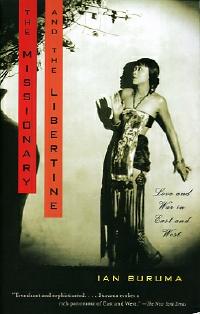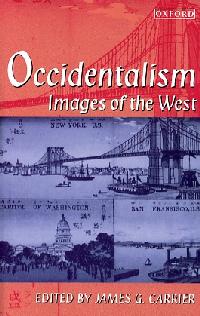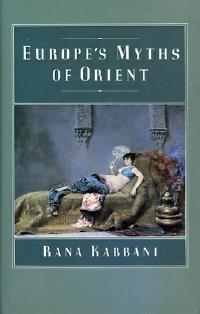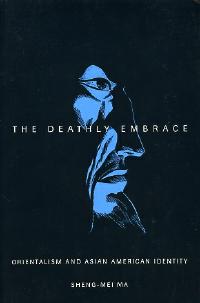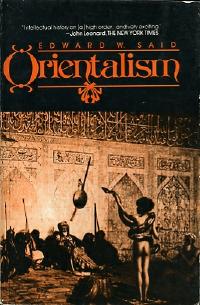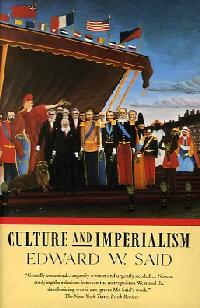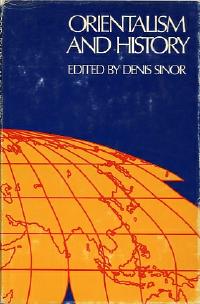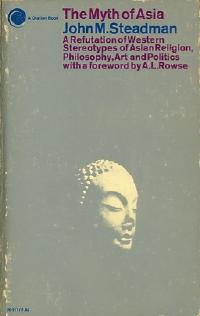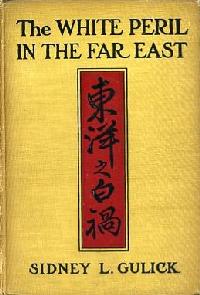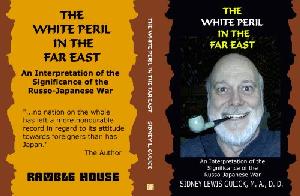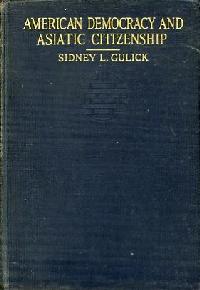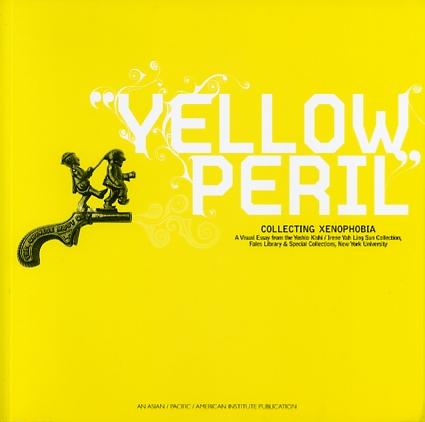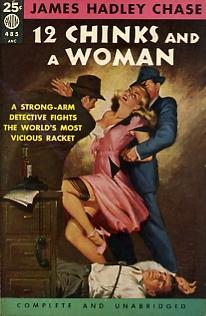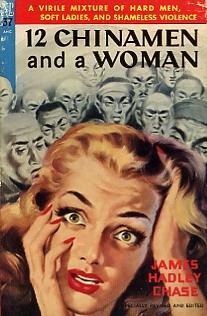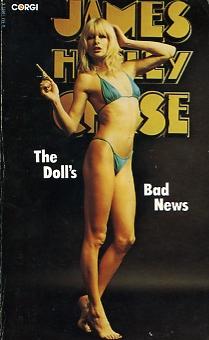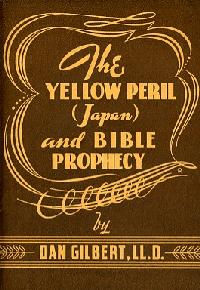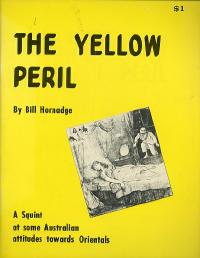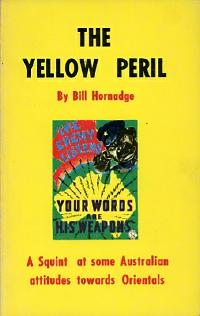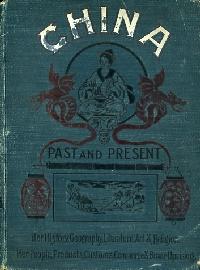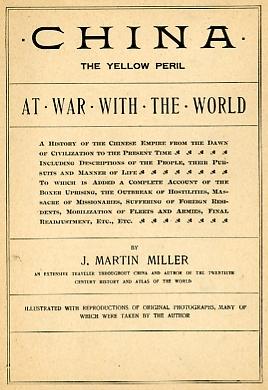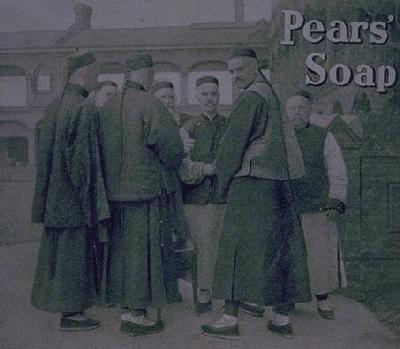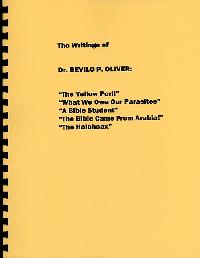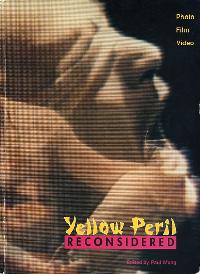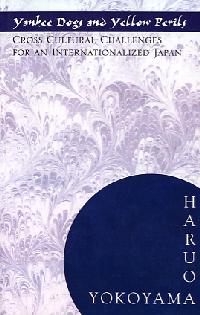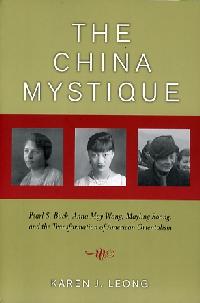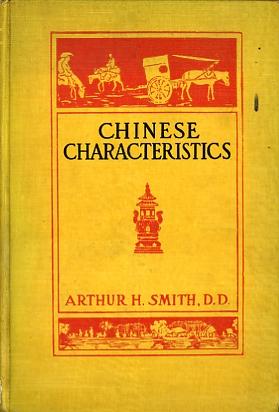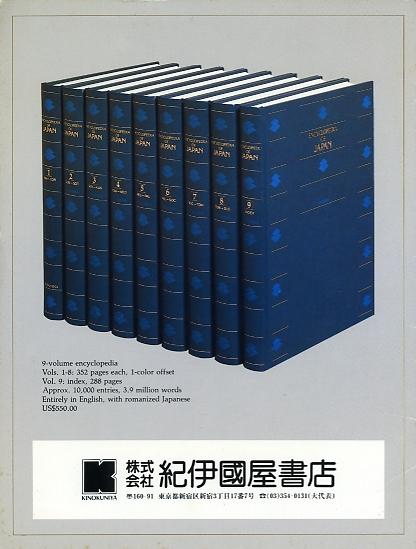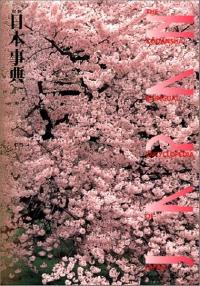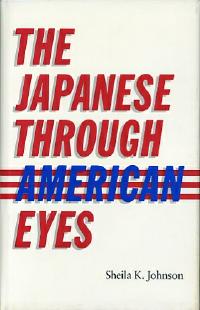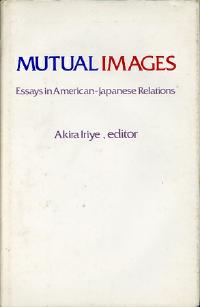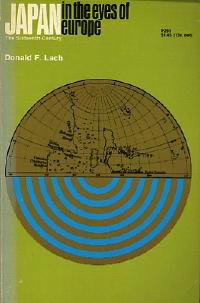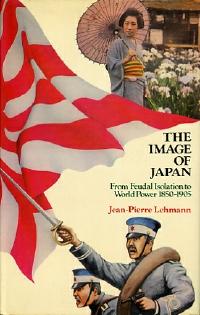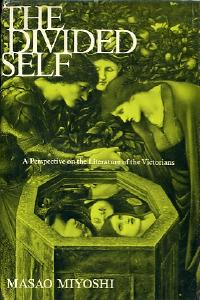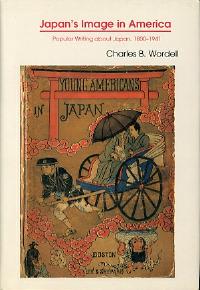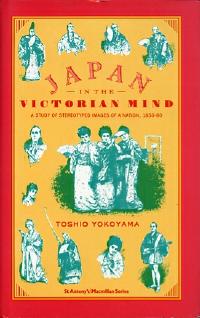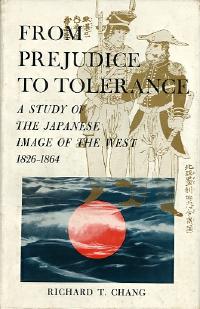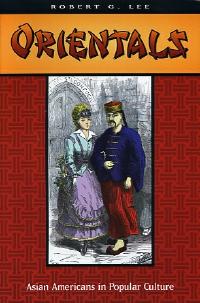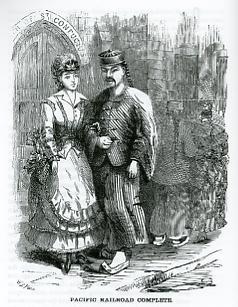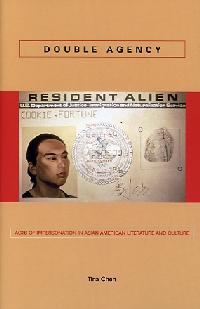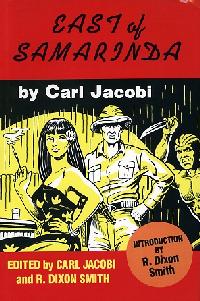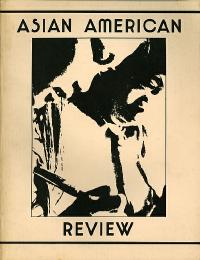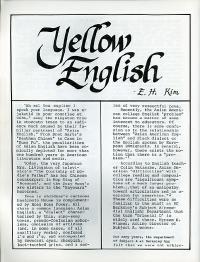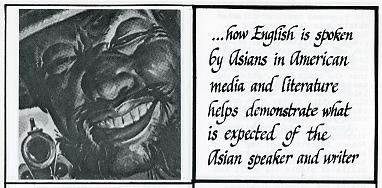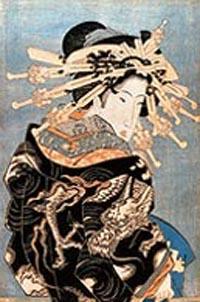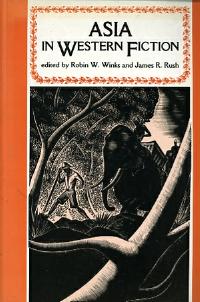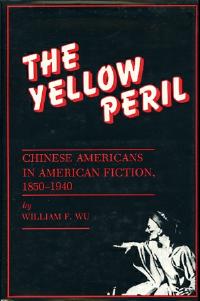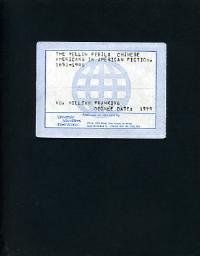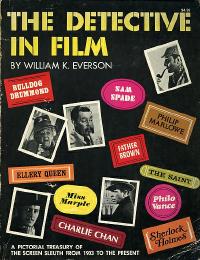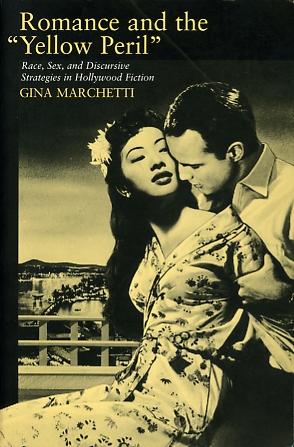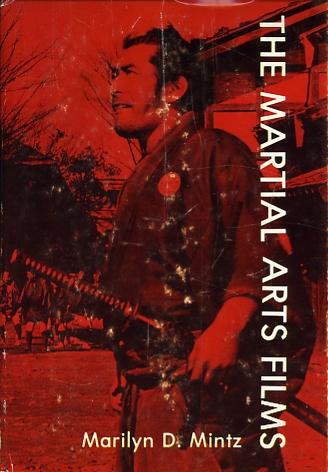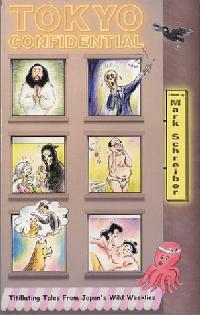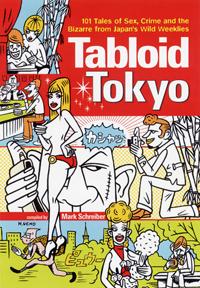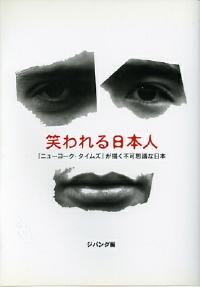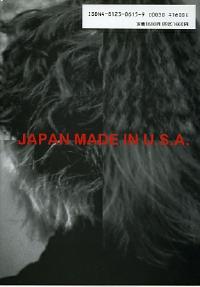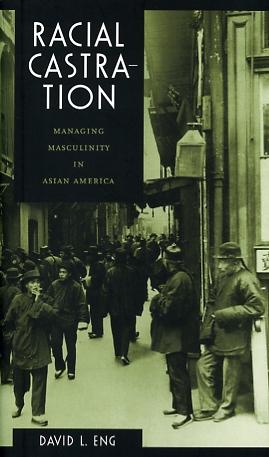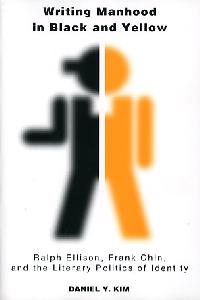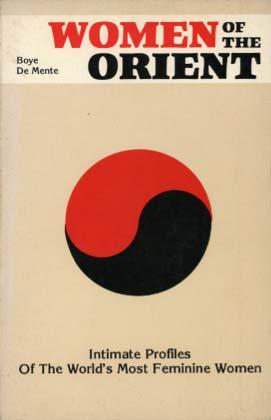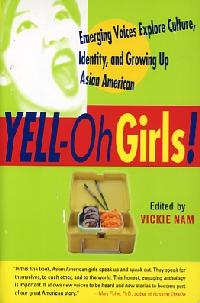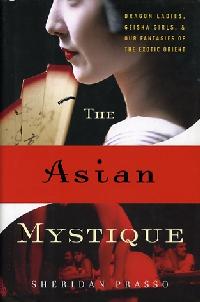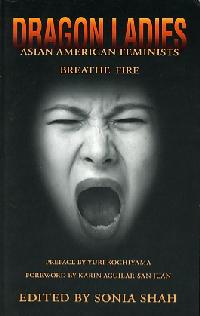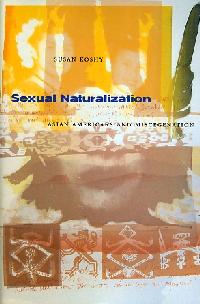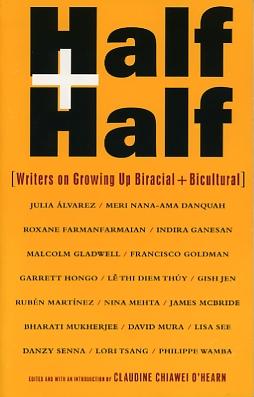The Steamy East
Steamy East images
By William Wetherall
First posted circa 2005
Last updated 28 July 2024
Studies of Steamy East images Mass media in academic halls of mirrors
Studies of Steamy East images
Mass media in academic halls of mirrors
How people see themselves and others
By William Wetherall
Here you will find reviews mostly of books, but also of a few articles, that address how people see themselves and others, and/or examine the images of the regions and countires that figure in Steamy East fiction.
Commentary on "yellow peril" is ubiquitous in writing on images of Asia. Only general works with "yellow peril" in their title or subtitle will be reviewed here under Yellow Peril. Books or articles that focus on "yellow peril" in fiction, for example, will be listed under Fiction in the Media section.
The main Images page is fully viewable in this window. You can jump to any part by clicking on its link on the menu, or scroll or search for keywords (Ctrl F) within this window.
Clicking on any link to another page within Steamy East, or to another website, will replace this page on your browser. To return to this page, click the return arrow in your browser.
Most of the images on this page are fuzzy because they are 50dpi or 72dpi scans made in the early days when screens were small, processors were slow, and memory was limited. More recent scans are 96dpi or 150 dpi, and a few 300 dpi.
| Mutual illusions |
|
Biologically all animals, including humans, are born with the capacity to develop ways of identifying friends and foes. Humans do this physically through the usual sensory devices, including smell and sound and shape and color. But humans also develop bodies of knowledge in the form of images that are passed on from generation to generation through spoken and written words. If one is intrigued by the the motion of the heavenly bodies, and comes up with the idea that they revolve around the earth, then these ideas remain truthful until there is cause to doubt them. It is the same with images that people have of themselves and others. Even habitually losing feuds or wars to inferior neighbors may not shake cherished beliefs in the supremacy of ones own family, tribe, or nation. That such illusions of superiority are almost always mutual is not ironic, because human nature could not be otherwise. Only when conflicts between rivals are replaced by conflicts which force the rivals to cooperate, do they begin to discover that many of the assumptions they had been making about each other are not correct. (WW) To be continued. |
| Occidentalism |
Ian Buruma This book is vintage Buruma. For several years my editor at the Far Eastern Economic Review, Buruma gets my vote for the most cogent and credible writer on the human condition in greater Asia and other parts of the world, of anyone writing today. The sheer breadth and depth of his commentary belies the labeling of him as just an Asianist, much less a Sinologist or Japanologist. Twenty-five essays are grouped in three parts. Part 1
Mishima Yukio: The Suicidal Dandy Part 2
Satyajit Ray: The Last Bengalil Renaissance Man Part 3
Ghosts of Pearl Harbor Many of these essays will shock readers who believe that "Asia" exists -- except as just another cauldron of humanity. (WW) |
James Carrier (editor) Almost as soon as "Orientalism" became a buzz word, some scholars began calling its counterpart "reverse Orientalism" -- an expression not used in this book. This simply meant that, if Occidentals "constructed" the Orient to serve their own purposes, Orientals constructed the Occident to serve their purposes. Life was simpler in those days, before anthropology became totally polluted by postmodernism, which feeds on obfuscation. Now even a rocket scientist would have trouble reaching the moon through the terminological haze. "orientalism" versus "Orientalism"In his Introduction, James Carrier, an anthropologist at Durham University who specializes in Melanesian society, defines "occidentalism" as meaning "stylized images of the West". He also differentiates "orientalism" from "Orientalism" (page 1). [Edward Said's Orientalism] is so influential that 'orientalism' has become a generic term for a particular, suspect type of anthropological thought. (In this collection, 'orientalism' marks the generic use of the term, 'Orientalism' being reserved for the specific manifestation Said describes.) As though they didn't have enough to do, readers are asked to differentiate between "Orient/alism" and "Occident/alism" on the one hand, and "orient/alism" and "occident/alism" on the other. Yet they must second guess the intent of such terms when capitalized at the beginning of a sentence, or in titles, simply because house style requires uppercase. Readers are also left wondering why, if there is an "orient" and an "occident", there are no "east" and "west" counterparts of "East" and "West" -- and why people are always "Westerners" and "Caucasians". No wonder the twain never meet in academia, where it is still fashionable to take seriously the notion that it is useful to dichotomize the world this way. ContentsThe convoluted prose that detracts from many of the articles is partly mitigated by their geographical spread. 1. Cargoism and Occidentalism 2. The Kabyle and the French: Occidentalism in Bourdieu's Theory of Practice 3. Maussian Occidentalism: Gift and Commodity Systems 4. Occidentalism as a Cottage Industry: Resenting the Autochthonous 'Other' in British and Irish Rural Studies 5. Imaging the Other in Japanese Advertising Campaigns 6. Duelling Currencies in East New Britain: The Construction of Shell Money as National Cultural Property 7. The Colonial, the Imperial, and the Creation of the 'European' in Southern Africa 8. Hellenism and Occidentalism: The permutations of Performance in Greek Bourgeois Identity 9. Occidentalism in the East: The Uses of the West in the Politics and Anthropology of South Asia Inside and outside "the West"Carrier broadly defines two kinds of occidentalisms, one internal, the other external. The former, "Occidentalism", exists in "the Western mind" (to paraphrase Carrier) in opposition to the "Orientalism" that exists in the same mind. The latter, which Carrier calls "occidentalism", exists "beyond the West" and appears "in studies of the ways that people outside the West imagine themselves . . . in contrast to their stylized image of the West" (page 6). This stylized image leads people "beyond the West" to take an "external view of themselves and their way of life [in order] to see their culture as a 'thing'" (ibid.). And this "occidentalized perception of themselves" (my wording) leads them to reformulate their indigenous social life accordingly. Loopy terminologyUp to this point, the rules of the terminology game are fairly clear if not simple. But things suddenly get very loopy. Here is, verbatim, an entire paragraph from the first chapter, which attempts to change the rules (Lamont Lindstrom, "Cargoism and Occidentalism", pages 35-36).
Things get betterSome of the reading gets better because it couldn't get worse. By the final chapter, though still very much in the throes of a postmodernist orgasm, thankfully there are no more nested brackets, and no more excuses for exceptionalizing one's one own rules in order to get upwind from the stench of one's own terminology (Jonathan Spencer, "Occidentalism in the East", pages 234-235).
EssentializationIn Carrier's introduction, "to essentialize" means "to reduce the complex entities that are being compared to a set of core features that express the essence of each entity, but only as it stands in contrast to the other" (page 3). "In conventional anthropology," he continues, "the orientalisms that have attracted critical attention, thus, do not exist on their own. They are matched by anthropologists' occidentalisms, essentializing simplifications of the West." In Edward Said's view, according to Carrier, "The alien Orient . . . is essentialized, is reduced to a timeless essence that pervades, shapes, and defines the significance of the people and events that constitute it" (page 2). In a note to this statement, Carrier remarks that "To essentialize a group or region does not require that it be seen as static or simple. It can be construed as going through stages of development or evolution, as . . . occurs in nationalist essentialisms. Equally, it can be essentialized in terms of its complexity and continual change, as . . . is the case for Europe." (page 29, note 1). Essentially, this book testifies on the side of critics who hold that cultural anthropology has lost touch with reality. (WW) |
| Orientalism |
Rana Kabbani The author, billed as a poet and translator of modern Arabic poetry, was born in Damascus and received her BA, MA, and PhD in English literature from Georgetown University, the American University of Beirut, and Jesus College, Cambridge. The "Orient" in her book is that of the Arab and Islamic world as seen through Victorian and other European eyes. Powerful travellersKabbani is interested in travellers (pages 1-2) The traveller who sets out from a strong nation to seek out curiosities in lands less powerful than his own is to be found in many different civilisations.1 The Islamic world, for instance, from the seventh to the fourteenth centuries composed of military and political powers which held sway over an area that came to stretch from Spain to China, sent out travellers, either as emissaries or as explorers, to bring back knowledge that could be used to enrich the store of politically useful information. As the Arabs grew more powerful, the number of travel books in their literature increased accordingly.2 Thus begins a brief overview of "travellers" in other ages and places, all leading up to Kabbani's focus on 19-century European travellers in the Arab and Islamic world.(page 7). The nineteenth-century traveller was concerned with the scenery only as it served as backdrop for his progress. He was the journey's hero -- not merely its narrator -- and he spelled out his complacency, cherishing every opportunity to speak of the self. . . . After all, the mythic Self of the traveller contained the sum of what he transported -- his education, emotions, biases and beliefs, laced with a strong dose of racial conceit, as befitted a century of imperialist travellers. Richard BurtonNo one represented the period more than the British explorer and imperialist of all trades Richard Burton (1821-1890) (page 7). Richard Burton was one of the most prolific among these, a staunch empire man through all his wayward wanderings. And significantly, it is his narrative that did most to asseverate the fiction of an erotic East. The Orient for Burton was chiefly an illicit space and its women convenient chattels who offered sexual gratification denied in the Victorian home for its unseemliness. The articulation of sexism in his narrative went hand in hand with the articulation of racism, for women were a sub-group in patriarchal Victorian society just as other races were sub-groups within the colonial enterprise. Oriental women were thus doubly demeaned (as women, and as 'Orientals') whilst being curiously sublimated. They offered a prototype of the sexual in a repressive age, and were coveted as the permissible expression of a taboo topic. Visual seductionKabbani, squarely in the feminist school of orientalist studies, prefers telling good stories to discoursing in postmodernese. She presents some very interesting and compelling citations from the writings of travellers like Burton, Galland, Lane, Doughty, and Lawrence to support her contention that European fantasies about Egypt and the rest of the Orient were as sexual as they were racial, political, and religious. Kabbani's analysis of orientalist painting, which visually seduced European onlookers (page 73), is well illustrated with eight pages of clear glossy black-and-white reproductions of representative 19th-century art portraying Arabian men and women. (WW) |
Sheng-mei Ma Sheng-mei Ma, a professor of American though and language at Michigan State University, received his PhD in comparative literature. He now teaches and writes on Asian American literature, minority discourse theory, Holocaust and other genocide studies, postcolonial literature and theory, Asian diaspora culture, and Asian literature and film. The title and subtitle of this book are actually meant to be read together, as Ma himself reiterates in his epilogue (page 161). I fully understand the consequences of my thesis -- the deathly embrace of Orientalism and Asian American identity -- and that it is likely to elicit strong reactions. But arguing in moderation is simply out of the question if one is to engage in a deconstructing of ethnic identity, as I point out in the Introduction. It is hoped that passion will not be mistaken for vitriol. Ethnicity in the arms of OrientalismThe following paragraphs are from the University of Minnesota Press web promotion of this book. The first paragraph also appears on the back cover. Asian American resistance to Orientalism -- the Western tradition dealing with the subject and subjugation of the East -- is usually assumed. And yet, as this provocative work demonstrates, in order to refute racist stereotypes they must first be evoked, and in the process the two often become entangled. Sheng-mei Ma shows how the distinguished careers of post-1960s Asian American writers such as Maxine Hong Kingston, Amy Tan, Frank Chin, and David Henry Hwang reveal that while Asian American identity is constructed in reaction to Orientalism, the two cultural forces are not necessarily at odds. The vigor with which these Asian Americans revolt against Orientalism in fact tacitly acknowledges the family lineage of the two. To identify the multitude of historical forms appropriated by the deathly embrace of Orientalism and Asian American ethnicity, Ma highlights four types of cultural encounters, embodied in four metaphors of physical states: the "clutch of rape" in imperialist adventure narratives of the 1930s and 1940s, as seen in comic strips of Flash Gordon and Terry and the Pirates and in the Disney film Swiss Family Robinson; the "clash of arms" or martial metaphors in the 1970s and beyond, embodied in Bruce Lee, Kingston's The Woman Warrior, and the video game Mortal Kombat; U.S. multicultural "flaunting" of ethnicity in the work of Amy Tan and in Disney's Mulan; and global postcolonial "masquerading" of ethnicity in the Anglo-Japanese novelist Kazuo Ishiguro. As Ma writes in his introduction (page xxii-xxiii): My approach as a whole is interdisciplinary, encompassing Asian American, American, Asian, and postcolonial studies; it is multigeneric, drawing from fictions, essays, children's books, films, comics, video games, and court documents; it springs from the field of cultural studies where a social phenomenon is anatomized in all its complexities, regardless of the barriers between "high" and "popular" culture, adult and children's culture. His commentary is augmented by seventeen consecutive pages of comic strips and other caricatures shown in black-and-white, and by five other full-page and four smaller black-and-white illustrations. Kazuo IshiguroI was particularly attracted to Ma's eighth and last chapter, "Kazuo Ishiguro's Persistent Dream for Postethnicity: Performance in Whiteface" (pages 147-160). Ishiguro is not an Asian American. He is British by way of migrating to the United Kingdom with his parents when a boy, and later naturalizing. Ma, of course, knows this. Why, then, wrap his thesis that "Asian American" identity has embraced "orientalism" with a look at a British writer he claims to be of "Anglo-Japanese" ethnicity? Ma has argued that "Asian Americans" will never be "Americans" because they themselves are embracing "ethnicity" rather than "postethnicity" as a way to defend themselves against orientalism. Ishiguro, Ma correctly claims, broke into writing on the strength of two "Japanese" novels -- A Pale View of Hills (1982) and An Artist of the Floating World (1986) -- contrived to go along with his Japanese name at a time when "ethnic" fiction was very marketable. This is precisely what "Asian American" writers continue to do -- whether one is a Maxine Hong Kingston (who Frank Chin calls "fake") or a Frank Chin (who thinks himself "authentic"). Ma views Remains of the Day (1989) and The Unconsoled (1995) as efforts on Ishiguro's part to escape the "ethnicity" imposed on him by his birth and upbringing and name. But Ma believes such efforts transcend his "Anglo-Japanese" self are merely a "Subversive Whiteface Reacting against Orientalism" and a "Reactionary Whiteface Subsuming Differences" -- as Ma states in the chapter's only two subtitles. "ethnic community" as racialist tyrannyThis is how Ma summarizes what he considers Ishiguro's failure achieve a white orbit around the pull of his ethnicity -- my expression for what Ma would call "passing" (pages 154-155). [N]either Remains nor The Unconsoled is truly postethnic. . . . Ishiguro's shift to English characters and postethnicity may suggest problematics much more troubling than a minority's reaction against identity politics by pigeonholing him as nothing but an Anglo-Japanese. Ethnic writers can conceivably imagine ways to become more, not less, ethnic. Why does ethnicity have to make way for postethnicity, an illegitimate heir that is probably one's own, yet alarmingly white? Why should the ethnic community accept one writer's flirtations with postethnicity, perhaps a code word for "whiteness"? Ma accuses Ishiguro of not writing hyphenated "Asian diaspora literature" (page 156). Ishiguro has so far masqueraded as Japanese (Ono), Anglo-Japanese (Etsuko), English (Stevens and Ryder), and vaguely Central European (the townspeople in The Unconsoled) characters in Japan, England, and an unidentified part of the Continent. The novelist inhabiting that hyphen has emerged in many roles, but rarely as an Asian minority living in the West, or, to put in unabashedly essentialist terms, in a subject position similar to his own. Ma finally tailspins into the sea of racialism (page 157). Ishiguro's dream of postethnicity turns out to be a veiling and an intensification of his minority complex. Freedom of choiceWhat, I would ask, is freedom for a writer -- if not to be able to choose what and who to write about? Ishiguro only began to write truly well and authentically when he realized he was British and not Japanese. Ishiguro, for his part, has diplomatically reminded every racialist interviewer who has found it amazing that a "Japanese" should be able to write a work of English fiction like Remains of the Day -- that he is British. Ma says that Remains of the Day "appears almost Conradian in its being more English than the English" (page 149). Ma himself cannot accept that Ishiguro might very well be English. He insists on treating Ishiguro like a piece of fruit: If doesn't look an apple, he shouldn't be trying to taste like one. It is people like Ma who, in judging Ishiguro by his birth and name, create the racialist climate in which not a few writers feel the pressure to "perform" an "ethnicity" that is not really theirs. When We Were OrphansIf Ma's The Deathly Embrace had been published one year later, he would have been able to read Ishiguro's When We Were Orphans (2000). The novel, set mostly in Shanghai, is about a famous London detective who returns to Shanghai, where he was born, only to find himself caught up in the Sino-Japanese War and his own memories. Why should anyone read any novel, except as an interesting (or not so interesting) story? Why should browsers pick up a novel by someone named "Kazuo Ishiguro" -- and return it to the shelf, disappointed because it lacks "Anglo-Japanese ethnicity"? Ma is also the author of Immigrant Subjectivities in Asian American and Asian Diaspora Literatures, Albany: State University of New York Press, 1998. In this work, too, he contends that "Asian Americans" who attempt to empower themselves by practicing an "ethnicity" that defines itself in opposition to orientalism are never able to liberate themselves from is power. It seems to me that Ishiguro is far more liberated than the likes of any North American or British writer today who happens to be, by sheer accident, of racially "Asian" descent. (WW) For more examples of the sort of racialism that hounds Ishiguro as an "Anglo-Japanese" writer, see my Yosha Research article on Kazuo Ishiguro. |
Edward W. Said See also Orientalismism. Orientalism was published in the deconstructionist soil of Third World Studies, which had spread on campuses throughout the United States in the 1970s, after the radicalization of academia that had started flared during the 1960s. The purpose of introducing it here is to qualify its usefulness as an approach to Steamy East fiction. Two points need to be made: (1) Said's "Orient" does not extend east of the "Middle East", hence don't expect to find very much about China or Japan, and not a lot more about India; and (2) his assumptions about the human condition are much too political and ideological to facilitate a truly dynamic (both critical and sympathetic) understanding of Steamy East fiction. |
Edward W. Said [Forthcoming] |
Denis Sinor (Editor) Forthcoming. |
John M. Steadman Forthcoming. |
| Fears of domination |
|
Though "yellow peril" plots can be found in some Steamy East fiction, the fear some white people have at times expressed about being someday dominated by yellow people is not, in fact, a very likely theme. If anything, Steamy East fiction is anti-yellow peril in that most writers are apprehensive about evil, not race. It just so happens that, if someone writes a thriller from the perspective the United States and an American good guy, about a fictional enemy in China, say, the good guy is likely to be white, and the bad guy is likely to be yellow. But the bad guy is typically bad because he is evil, not because he is yellow. He is a despot or psychopath or communist or some combination, who has fanatical, personal, or ideological reasons to want to set off a nuclear bomb in the middle of Manhattan, whatever. But the same sense of "peril" can be found in most fiction that draws a line between friend and foe. The foe is rarely an entire nation or race or religion or whatever, but an evil leader or clan or government or the like. So "peril" exists whenever there are chronic or acute fears of domination or destruction by an individual or collective embodiment of evil, as we shall see in the varieties of peril found in Steamy East and related fiction. Racialized enemiesFear usually stems from real or imagined threats of domination by another people by any means -- from religious, ideological, cultural, economic, or demographic influence, intrusion, or invasion -- or through direct military invasion, conquest, and occupation. The fear is easily racialized as friction and other forms of conflict between two states increase the potential for war. And once war comes, neighbors of the same nationality can suddenly become racialized enemies -- as happened in the case of westcoat Americans of Japanese ancestry. The internment of Japanese Americans was not motivated by "yellow peril" so much as by war instilled fears of the "Jap enemy". Chinese immigrants and their American descendants, once racialized as threats to white domination in parts of California, had to be differentiated from Japanese immigrants and their American descendants, since China was an ally against Japan. Since the Japanese enemy was racialized, however, the perception of the "Jap enemy" was expanded to include Americans who just happened to be "Japs". Of course, such racism did not just pop out of thin air. It exploded out of a fertile soil of racialism that included "yellow peril" sentiments. Pearl Harbor simply reduced the civil barriers that had, until then, kept most racialist paranoia in check. White, Yamato, and red perilsStill popular in Japan today is the argument that Japan's intentions in China and the rest of Asia and the Pacific were partly motivated by a desire to drive the "white peril" out of Greater East Asia if not all of the Eurasian hemisphere including the west Pacific. This argument cannot be simply dismissed as Yamatoist conceipt. The great irony of Japan's adventures in Asia and the Pacific is that Yamato supremicism replaced the white peril with the Yamato peril. The Yamato peril swept China and steeled Chinese resistance to Japan's efforts to totally occupy and control the country. Chinese nationalists and communists called a truce to their civil war to drive out the common Japanese enemy. China's Yamato peril informed American, British, Canadian, and Dutch insistance that Japan withdraw from China. Japan, though, insisted it had a right to involve itself as it had in China's internal affairs. Pearl Harbor merely brought China's Yamato peril closer to home in the United States. And this peril, more than a "yellow peril", led to the injustices committed by westcoast states and the federal government against citizens of Japanese ancestry. The Yamato peril ended with Japan's defeat. But it was immediately replaced by the "red peril" in China as Chinese nationalists and communists resumed their civil war on a massive scale. Then came the Korean war, again involving Korean communist and nationalist forces, the communists backed by the USSR and PRC, and the nationalists by the US and its UN allies. The Vietnam War began when Japan left Vietnamese it has "liberated" from French colonialism to resist the return of the "white peril" in the country. Because that resistance was "red", the United States backed the southern "nationalists" who opposed the "red peril" in the north. Present-day perilsToday the worlds major perils are "materialism" and "corporatization" and "McDonaldization" and "Americanization" and "regionalization" and even "globalization". Many states also contend with "cultural imperialism" -- France its fear of English, Korea its fear of Japanese popular culture, China its fear of the Internet -- almost everyone's fear of Hollywood. NationalismNationalism infolves a lot of chest beating and flag waving and other expressions of extreme pride in nation, or the spread of a nation through colonialization whether by conquest or other means. Typically it is driven by racial or cultural supremacism, and by religious and other forms of ideological fanaticism. SupremacismSupremacism is at the heart of nationalism. Not all nationalists are ultrasupremacists, but most nationalists inevitable believe in the relative supremacy of their nation. A nation is usually regarded as superior for reasons of "race" (nature) and "culture" (nurture) -- "race" being the collective natural or biological traits of nationals, and "culture" being their collective way of life reflecting the superior values they acquired from having been nurtured in a superior society. ReligionStories that feature conflict resulting from religious or friction will be treated here. Most such fiction reveals the "Christian peril" -- the conspiracy between Christianity and Euroamerican imperialism to bring Christ and industrial civilization to Asia. Some stories deal with perceptions of the "Jewish peril" while others concern the "Islamic peril". IdeologySome states and private organizations have forced communisim, capitalism, democracy, and other economic and political ideologies upon countries or peoples they wish to change and control. Stories touching upon such ideological perils will be covered here. CultureStories which feature "culture shock" or "cultural misunderstanding" or "cultural imperialism" will be covered here. "Culture" is included here only because "cultural determinism" has become very fashionable. Many people have fallen into the habit of wanting to explain nations and even individuals in terms of a shared "culture" that governs collective and personal behavior. They are taught to say "my" and "our" culture and "your" and "their" culture -- and "nationalism" and "culture" are sometimes seen as two faces of the same "ethnic nation" or "race" of people. Many writers of Steamy East and related fiction motivate their characters as though were cultural cyborgs. A typical Steamy East novel is full of anthropological and sociological asides about the Asian countries and peoples featured in the story. Asian characters are apt to be portrayed not as personalities, but as culturally programmed robots. The abuse of "culture""Culture" has come to be one of the most abused words in the world. Its fashionability owes a lot to the impulse to explain people in terms of "their culture". In the United States today, thanks to the spread of multiculturalism, "culture" has become a code word for "ethnicity" and even "race". However, "culture" is almost always a thought-terminator when used to explain human behavior. It is blamed for all kinds of things it cannot possibly account for -- such as an individual's "culture shock" (personal inability to accommodate and adjust to an unfamiliar situation) or "cultural misunderstanding" (personal ignorance). The idea that there is "communication between two cultures" or "intercultural communication" is an even greater semantic travesty -- since cultures don't exist in forms that permit them to "communicate" in any sense of the word. Only individuals can communicate or fail to communicate. And no individual, or accoundable group of individuals, can mediate "a culture": they can only mediate those molecules of the vast, rare, and ill-defined cultural air they inhale in the course of their life. "Cultural imperialism" is arguably more credible as a metaphor of domination, since states and nationalist organizations are known to "bombard" and otherwise "invade" other states with information through radio, televison, films, books, and other media. DominationOne country can dominate another in many ways. Military conquest does not itself result in domination. In fact, some vanquished peoples have been able to co-opt the victors, who end up assimilating into the conquered population. Military dominationMilitary invasion and occupation is the greatest fear of every nation with a history of wars with neighboring countries. The age of intercontinental ballistic missiles, and Star Wars style attack satellites, has spawned fears of annihilation by frist-striking enemies on the other side of the globe. Science fiction commonly features alien invasions of earth, and wars between civilizations in differently parts of the universe. Demographic dominationNations are known to fear being over run by foreigners through gradual or mass immigration. Mass migrations can be triggered by wars or natural disasters that set huge numbers of refugees in motion toward a new homeland. Economic dominationHere we will look at stories that feature trade wars, sabotage of financial institutions, industrial espionage, and other such conflicts of an economic rather than ideological or military nature. Industrial espionage related to military domination will be under military. TerrorismStories featuring threats or acts of terrorism by any means will be covered here. Stories with plots involving nuclear or biological terrorism will under these headings. Weather terrorismNot yet in fiction but probably not long in coming -- now on only the wackier fringes of the Internet -- is "weather terrorism". Since 1990, according to one meteorologist, teams of yakuza and Aum Shinrikyo assumed weather engineering operations over North America from FSB/KGB. Since Aum Shinrikyo bad guys are in prison, the operations are being continued by the yakuza, who are said to be leasing giant scalar interferometers from Russia. Apparently these "rouge Japanese teams" are under direct FSB/KGB supervision. Biological terrorismMost stories involving biological terrorism are about threats or attempts to expose a city to a deadly microorganism, to force a government to capitulate to some evil man's demands. Nuclear terrorismNuclear terrorism typically involves threats to annihilate a city, possibly the capital of a country, if the government doesn't submit to the terrorits' demands. Japanese bad guys who resort to "nuclear blackmail" are often motivated by a desire to avenge Hiroshima and Nagasaki. |
| White peril |
Sidney L. Gulick Ramble House reprint edition Ramble House's blurb reads like this. At last we have a studied, rational view of the mis-interpreted motives of the Japanese rulers of the early 20th century. The author, Sidney L. Gulick, who must have been one of the very earliest members of Mothers Against Drunk Drivers (1905!), shows us in 118 detailed pages that Japan has never harbored any ill will towards any other nation and that there is no chance of this noble shogunate ever threatening any other country, much less attacking by surprise. Indeed, as is evidenced by the horrific visage on the cover of this brand new reprint, it is the despicable white race that bears watching. This 1905 book is an essential addition to any contrarian's library. Gulick's own "Preface" is more serious. On the 8th of February, 1904, Japan crossed swords with a European people. And from the destruction of the Variag on that day until the fall of Port Arthur on the 1st of January, 1905, nothing but failure has been Russia's fate, nothing but success Japan's fortune. For the first time in history has an Asiatic people successfully faced a white foe. The Russo-Japanese war marks an era, therefore, in the history of the Far East, and of the world, for now begins a readjustment of the balance of power among the nations, a readjustment which promises o halt the territorial expansion of white races and to check their racial pride. To appreciate the significance of this war as one act in the tragedy of the white peril we must understand Japan. How has she attained the power, material and temperamental, which is enabling her to face the white man and to conquer him? This question we study in our earlier chapters. In those that follow we study the significance of the war, and the problems of the Far East in their world-setting. We are not concerned with dates and battles, with armies and heroes. Rather shall we consider movements and tendencies, national ambitions and international relations. Emphasis is laid on the peril to the Far East of the white man's ambitions and methods. Justice to white races, however, demands recognition also of the blessings they confer upon those lands. In a real sense the white peril is becoming the white blessing of the Orient. Yet the aim of the present work in these pages precludes adequate emphasis of this point. Certain graceful writers, masters of imaginative style, have described Japan as ideal in every direction, a view widely popularized to-day by Japan's brilliant military record. But of course no thoughtful man will be misled, for national as well as individual perfection is impossible. Highly admiring Japan as I do, absence of criticism in the following pages does not signify acceptance of the popular unbalanced admiration. The decline of white dominanceGulick was not the only writer to view the outcome of the Russo-Japanese War as a watershed of race relations in Asia and even the world at large. Though Gulick had dedicated his life to the spread of Christianity, he appears to have acknowledged, to some extent, "the failure of Christianity to conquer the evils of Christendom" (page 55). Gulick seems to have realized that, whatever "blessings" western civilization might confer on some non-western societies, it could not fulfill its humanitarian promise so long as it was mediated by Christians who saw nothing wrong with white supremicism. In my words, rather his, the Church was incapable of abluting its own sins because, institutionally, it had swallowed the apple of racist imperial ambition, worms and all. The Great War of 1914-1918 also suggested that something was lacking in western civilization. In Der Untergang des Abendlandes [The twilight of the eveninglands], translated as The Decline of the West, the German philosopher-historian Oswald Spengler (1880-1936) espoused a cyclical theory of the rise and decline of civilizations and argued that Europe may have reached its peak. Spengler began the two-volume work, first published in 1918 and revised in 1922, before the war, so its scope goes far beyond Germany's defeat. Most observers of Japan, though, did not share Gulick's optimism that Japan was no threat to others. Koreans at the time had good reason to think of Japan as a peril, since both the Sino-Japanese War of 1894-1895 and the Russo-Japanese War of 1904-1905 had begun in Korea. And Japan annexed the Korea in 1910. By the early 1930s, the "Japanese peril" had spread in earnest to the Chinese continent, already having reached Taiwan in 1895. And the rest is history. Well, not quite. The history of "Second Sino-Japanese War" or "The Greater East Asian War" or "The Fifteen-year War" of 1931-1945 is still being written. So, too, is the "Pacific War" of 1941-1945. That Japan's military actions in Asia during the 1930s and 1940s were partly based on intentions to liberate Asia and the Pacific of Euro-American colonialism cannot be denited. The operational word is "partly". Partly, not entirely, since Japan clearly had its own imperialist designs on the region. But "partly" is enough to require that the "white peril" in Asia be taken into account in any revision of regional history. By William Wetherall |
||||
Sidney L. Gulick, D.D. The "D.D." means "doctor of divinity" not "doctor of dentistry" -- but either way, it was like pulling teeth for Gulick to advocate an end to racism against Asian immigrants, as he did at a time when US immigration and naturalization laws prevented them from becoming US citizens on account of their "national origins" -- a code for "race" as it still is today. Raceless citizenshipIn Chapter IX -- Criticisms Criticized -- Gulick presents one of the most cogent, for its time, arguments for ending racism in US immigration and naturalization laws (pages 124-126) Let it be clearly understood, then, that the proposals of this volume have nothing to do with free Asiatic immigration. What we do urge will all possible emphasis is that those whom we do admit, and sho are to stay here permanently, whatever their race may be, should be urged and helped to learn our language and our ways and to enter thus into wholesome relations with our government and our people. [Emphasis in original] [abbreviated] American-born children are citizens, whatever their race. The withholding of citizenship from Asiatic parents will not have the slightest effect upon the chance that their American-born boys and girls may intermarry with girls and boys of long American ancestry, if they are mutually attractive. Gulick, to be sure, is a racialist, since he believes race exists, and finds no problem in labeling individuals and populations racially according to their putative "race". Nor is he advocating interracial marriage. He is simply not against such marriages if individuals of different races happen to be attracted to each other. What is important is that Gulick advocated raceless citizenship at a time when such an idea was unpopular in the land of the free and the home of the brace. He had been criticized for his advocacy of raceless citizenship, and even snubbed during an appearance before the Senate Committee on Immigration in 1914 -- hence the title of this chapter. Kipling was rightGulick is one of the few writers of his time to understand Kipling. On the second page of Chapter IX he takes to task those who misquote Kipling to defend their racism.
Pages later, the chapter ends like this (pages 128-129)
"Blue-eyed" dollsSidney Lewis Gulick (1860-1945) was born in the Marshall Islands to missionary parents. His father was born in the Sandwich Islands (Hawaii) to missionary parents. Sidney's paternal grandparents died in Kobe, Japan, where they had gone live with another of their sons, a younger brother of Sidney's father. Sidney Gulick was himself ordained in the Congregational Church in 1886. For twenty-five years between 1888 and 1913, he served in with the American Board of Commissioners for Foreign Missions. During his last seven years he was a professor of theology at a university in Kyoto and a lecturer at another. Back in the United States, Gulick campaigned against anti-Asian legislation in California and elsewhere in the country. His efforts failed to halt the Immigration Act of 1924, which all but closed the door to Asian immigration and continued to deny Asian immigrants access to US citizenship. Gulick threw himself into the formation and running of the Committee on World Friendship Among Children. He originated its doll exchange program, under which American children sent dolls to children in Japan. Beginning in 1927, thousands of "Friendship Dolls" were sent to schools in Japan during the Hinamatsuri (doll festival) each spring. Though many of the dolls did not have blue eyes, they came to known in Japan, and are mostly known today, as Aoime no ningyo in Japanese or American Blue-eyed dolls in English. In racialist contexts, "aoime" [blue-eyed] is the Japanese equivalent of "slant" or "sland-eyed" in English. It reflexively substitutes for "foreigner" or "westener" or "American" -- and for other terms that also signify "white" in racialist parlance. During the war, many of the dolls were destroyed because of their association with the American enemy. Today they are proudly displayed in schools that have managed to save them, and there are numerous websites devoted to dolls, which have also come to be prized by collectors. Gulick himself was suspected of being a spy for Japan. According to a grandson, he wrote, regarding his efforts to improve US-Japan relations by revising US immigration laws -- in America, "I am as truly a missionary working for Japan as if I were in Japan." By William Wetherall |
| Yellow peril |
Asian/Pacific/American Institute The Asian/Pacific/American Institute was established at New York Univeristy in 1996. Its mission, according to its website at www.apa.nyu.edu, is to (1) "promote discourse on Asian/Pacific America defying traditional boundaries, spanning Asia, to the Americas, through the Atlantic and Pacific Worlds", (2) "dispel socio-cultural and political misconceptions, provide cultural and scholarly connections, lead collections building, and encourage innovative research and interdisciplinary exploration", and (3) "serve as an international nexus of interactive exchange and access for scholars, cultural producers, and communities from New York to beyond." Recent achievements of the institute include the acquisition of the Yoshio Kishi / Irene Yah Ling Sun Collection as part of its effort to "build a foundation of, and preservation and access to, important historical documents and previously overlooked materials for present and future researchers and students." The publication under review commemorates the Archivist of the "Yellow Peril" exibit held at the institute from 3 February to 31 July 2005. The subtitle of the exhibit was "Yoshio Kishi Collecting for a New America". The book, like the exhibit, "provides a historical context/explanation of yellow peril and how this phenomenon came to be." The artifacts in the visual part of the essay are from the collection. The running text was written by Dylan Yeats, who the colophon lists as the editor. The imperative of collectingThe foreword, called "The Imperative of Collecting Xenophobia", was written by John Kuo Wei Tchen, the institute's founding director. Tchen starts with a simple question: Should an XXX-rated inflatable latex "Chinese Sex Girl" be collected or tossed? The book shows only part of the blow-up doll. The on-line exhibition shows all her charms. Tchen, a cultural historians, "can affirm this is an important item to collect" -- but wonders if he would have gone into a sex shop and bought one himsel. Someone has to wonder what such sex toys mean -- "How do the allures and fears of sexuality and race interlink?" "Each item has its shadow," Tchen says, and "We need to archieve the shadows." One problem everyone faces is what to keep and what to toss. Every person who gathers anything for whatever reason, or who inherits anything, has to do a triage. Somethings are saved. Other things are thrown, dumped, burned, or buried. As Tchen writes, though, there are both personal and social considerations (page 1).
Tchen concludes his generally interesting and colorful foreword on this note (page 3).
"Japanese in the U.S."In his foreword, Tchen pursues the "imperative of collecting" theme in terms of the "categories" that librarians and other archivists have placed materials -- "Yellow Peril" -- "Orient". Such terms began to vanish from libraries in the 1970s (page 3).
Tchen does not say why, for example, "Japanese American" is better than "Japanese in the U.S.". He probably assumes that most of his readers will understand that -- in the minds of not a few people -- "Japanese in the U.S." continues to embrace Americans who happen to be of Japanese ancestry, but who are not Japanese. Tchen does not appear to understand that such racialism -- such conflation of nationality with putative race -- is a problem everywhere. In Japan, too, most people will speak of "Japanese Americans" as though they are "Japanese in the U.S.". The problem with Tchen's own reductionism -- his conflation of "Japanese in the U.S." into "Japanese Americans" -- is that "Japanese in the U.S." is in fact a very appropriate term if it means precisely "Japanese in the U.S." -- namely, people who, regardless of their race or ethnicity, are nationals of Japan who happen, for whatever reason, to be in the United States. For this would be the legal sense of the term -- reflecting usage in both US and Japanese government statistics which report the number of Japanese nationals who in the United States. One is not entirely sure -- from Tchen's usage of "Japanese Americans" -- what he means by "Japanese" and "Americans". Presumably "Americans" is a nationality. Presumably "Japanese" is a national ancestry. If so, then "Japanese American" would have to include all people who are Americans by nationality and who, in their personal histories, have some family or other connection with Japan or Japanese nationality -- regardless of their racial ancestry -- since, under Japanese law, Japanese nationality is a raceless civil status. One gets the impression, though, that Tchen is merely swapping one racialist label for another. His inclusion of "Japanaese in the U.S." with "Japanese Americans" also contributes to the dumbing down of history that is rampant everywhere. The following remark later in the work is a case in point (page 27, underscoring mine).
The rhetoric -- "imprisoned" and "concentration camps" -- though not without foundation -- is not entirely accurate. Historical understanding is not achieved merely by replacing government and other euphemisms with what I would call "critically correct" terminology. The main problem in the above citation, though, is the characterization of the "prisoners" as "120 American citizens . . . along with all persons of Japanese ancestry" living on the West Coast in early 1942. It is simply not true. In the April 1940 census, there were roughly 127,000 people in the United States of Japanese ancestry. Of these, about 47,000 had been born in Japan, and practically all of the Japan-born were Japanese nationals. Of the roughly 112,000 people of Japanese ancestry who were living on the West Coast, about 70,000 were Americans and the rest were Japanese. Elsewhere in the United States -- unrelated to West Coast exclusions -- Japanese officials and other a number of other Japanese were taken into custody as enemy aliens. In some cases, Americans (including Americans of Japanese ancestry) accompanied their enemy alien spouse or parents into detention. Most of these detainees were repatriated to Japan within a year or two of their detention through civilian exchange agreements between the United States and Japan. Various local Civilian Exclusion Orders provided that "all persons of Japanese ancestry, both alien and non-alien" be "evacuated" from the West Coast military zone. In this implicity racial definition of "Japanese", the term "aliens" -- because there were no grounds to include "non-aliens" except as a racist metalegal afterthought. The "exclusions" and "evacuations" were based on Executive Order No. 9066 of 19 February 1942, which stated only "enemy aliens". The order cited, as its authority, the same 1918, 1940, and 1941 acts cited in Executive Order No. 8972 of 12 December 1941. These acts, and their post-9/11 21st-century cousins, stem from enemy alien and sedition laws going back to 1798. The number of people who were excluded from the West Coast, by internment in one of the several "relocation centers" or camps established for "persons of Japanese ancestry", is commonly pegged at 120,000. Apart from the accuracy of this figure, about one-third of the internees were in fact "Japanese in the U.S." -- and only about two-thirds were "Americans" defined as "American citizens". The Japanese internees included mostly settled immigrants. Very few of this "first generation" chose to be "repatriated". Some of the "second generation" were dual nationals, and some of these dual nationals had been partly educated in Japan. But very few of these Americans chose to renounce their US citizenship and leave the United States.
Popping pimplesAll in all, the "Yellow Peril" exhibit and book are par for the course, in that they constitute a better show than tell about the issues they presume to address. The exhibited items are genuine, but the stories told about them are sometimes misleading. The term "yellow peril" is practically dead outside the United States, where it is kept alive mostly by vestiges of the sort of social activism that spread during the civil rights movements between the 1950s and 1970s. These movements gave birth to the many "Asian American" and "Asian Pacific American" organizations that exist today, including -- more recently -- the A/P/A Institute. No doubt the "yellow peril" that began to blemish the faces of various countries in the late 19th century -- most conspicuously in the United States -- had become, by the early decades of the 20th century, an outbreak of ugly pimples. But the pimples -- political, legal, and social -- began to pop during the 1930s and 1940s, and by the 1950s they were beginning to dry out. To be sure there are still some "yellow peril" scars, and even a few open lesions, in some sectors of American mass media and popular culture. Now and then, somewhere, a die-hard racialist stereotype will fester from a discoloration to a bump. The odds, though, are that a proactive interest group will spot the zit and zap it before it errupts. Some teenzines advise that zits have to be treated with great care so as not to cause unwanted scarring. The sort of scarring I most worry about is "self-censorship" in the form of "political correctness" that would deny a curator or writer -- even those affiliated with an organization as competent as the A/P/A Institute -- the freedom to use words like "Chink" in an exhibit or book. Were the British writer James Hadley Chase (1906-1985) alive today -- and were he still inclined to write a novel of the kind he wrote seventy years ago -- I would like to think that he would be free do so so. Chase's novel is not, in any event, a truely "yellow peril" story. The expression begins to lose its meaning, even as a metaphor, when scholars and critics apply it to a work that is not about racial invasion or racial dominance -- no matter what other faults it may be said to have within the conventions of its time, place, and genre. William Wetherall |
Dan Gilbert This wartime publication (March 1943) has six short chapters. 1. Why Japan Will Outlast Germany 2. What Japan Will Do After Germany Is Beaten 3. Will Japan Make an Ally of Russia? 4. Japan's Plan to Seize the Holy Land 5. Is Japan the Antichrist Nation? 6. Can China Survive? The penultimate chapter is obviously where this Man of God is coming from. It draws largely from Syngman Rhee's Japan Inside Out, published in 1941 by Fleming H. Revell, whose mission it was to spread Christianity. Gilbert concludes that Japan's mission was otherwise (page 42). Japan is waging, primarily, not a war of conquest but a religious war. Her aim is to destroy Christianity -- first in China, and then throughout the entire world. To accomplish this objective she must unify the yellow peoples of Asia, not only by means of her military program, but under the inspiration of her religious superstition. Zondervan Publishing House, now a division of HarperCollins, is still in Grand Rapids, Michigan. It still specializes in Bibles and evangelical Christian tracts, and claims to be "the leading Christian communications company in the world". Today, though, its publications are mostly concerned with teen sex and whether the United States can be a Christian nation. (WW) |
Bill Hornadge The first paragraph of the preface: Australians, particularly when travelling abroad, try desperatelyi to cultivate the idea that they are a tolerant, racially unprejudiced people. They have worked so hard at buildling up this image that most of them now believe it to be true, but in reality the average Australian is as xenophobic and racially prejudiced as the next man. That this is not immediately apparent to the brief visitor to these shores is only because colour problems do not exist in Australia on the massive scale they assume in some other parts of the world. Wherever colour does intrude on the consciousness of the average Australian, the reaction is immediate -- and ugly. And the last paragraph: Racism in all forms will be eradicated only if it is dragged from its cesspit into the open and its exponents forced over and over again to justify in the cold light of day their prejudices and fears. The cold blasts of sunlight, and the logic of commonsense may eventually drive the evil from the planet earth, but that day is a long time in the future. |
J. Martin Miller This book is one of the most interesting publications to appear in 1900, immediately after the suppression of the Boxer Rebellion, which some Euroamericans saw as evidence of what Kaiser Wilhelm II, following the Sino-Japanese War of 1894-1895, had called "gelbe Gefahr" or "Yellow Peril". European and Japanese perilsThe book is particularly interesting because, though "The Yellow Peril" appears on the title page of the edition under review -- and though one chapter describes the "Two Months of Peril" faced by the foreign legations that were besieged by Boxers in 1900 -- its author did not, in fact, endorse a "yellow peril" thesis but, quite the opposite, he publicized the view of a prominent Chinese statesmen who advocated that China needed to defend itself against what amounted to a European peril and a Japanese peril. The spine of the edition under review reads "China / Past and Present / Illustrated". The front cover reads "China / Past and Present / Her History, Geography, Literature, Art & Religion. / Her People, Products, Customs, Commerce & Boxer-Uprising." Another edition bears the title "China / Ancient and Modern" on a decorative tan cover. Yet another edition is supposed to have a navy blue cover. Other editions are said to have been published by Occidental Publishing Company (San Francisco), Sanderson-Whitten Publishing Co. (Los Angeles), Earle Company Ltd. (St. John), and Haskell (Norwich). ContentsMiller introduces China historically and describes Chinese society as he observed it at the end of the 19th century. But the last 9 of his 28 chapters deal entirely with the Boxer disturbances that unfolded after the Sino-Japanese War of 1894-1895, broke out in open violence in 1898, came to a head with the intervention of foreign military forces while Miller was in China, and was settled by the Boxer Protocol of 1901, a year after Miller's book was published. 1. The Country of the Chinese 2. In the Dawn of History 3. The Growth of a Great Empire 4. Early Contact with European Powers 5. The Opium War with England 6. Foreign War and Internal Rebellion 7. Great Cities of the Empire 8. The Government of China 9. Domestic Life and the Family 10. Customs and Costumes of the Chinese 11. Holidays, Sports and Games 12. The Chinese Language and Literature 13. Religions of the Chinese Empire 14. Art, Music and the Drama 15. China in Science, Invention and Discovery 16. Resources and Industrial Wealth 17. War with Japan in Korea 18. Foreign Relations Since the China-Japanese War 19. Great Men in Modern China 20. Beginning of the "Boxer" Outbreak 21. From Taku to Tientsin 22. "On to Peking" 23. The Siege and Sack of Peking 24. Two Months of Peril 25. Stories of Personal Experience 26. Chronicles of Horror 27. In the Imperial City of Peking 28. Formulating Terms of Peace Boxer RebellionWhat Miller called the Boxer "uprising" or "outbreak" is now most often dubbed a "rebellion". An incredible amount of ink has been spilled in Chinese, Japanese, English, and other languages over the events surrounding August 1900, when foreign troops invaded, occupied, and looted Beijing -- an incident which nationalists and communists alike look back on as the most humiliating in China's recent history. The Boxers disliked the unequal treaties the Qing court had been forced to sign with foreign powers over the years, including most recently Japan after the Sino-Japanese War of 1894-1895. The Shimonoseki Treaty of 17 April 1895 ceded Japan not only Taiwan but the Liaodong peninsula. But on 23 April France, Germany, and Russia -- in what is called the Triple Intervention -- forced Japan to cede Liaodong back to China. The killing of two missionaries in Shandong province in 1897 gave Germany the excuse to occupy the port of Qingdao in eastern Shandong (Shantung) in November. The next month Russia occupied Lushunkou (Port Arthur) on the Liaodong (Liao-tung) peninsula in Liaoning province in northeast China and forced China to lease it the peninsula. Britain then snatched the seaport of Weihai (Weihai Garrison) to the east of Qingdao (Tsingtao), and in 1898 France occupied the fishing port of Zhanjiang (Fort Bayard) in Guangdong province in southeast China. The Boxers -- as the "Yihetuan" or "Righteous and Harmonious Fists" were dubbed in English -- were inspired by beliefs in their religious invincibility, and by nativist resentment of foreign influence in China, to purge the country of foreigners, above all missionaries. The group originally directed its discontent against the Qing court, of Manchu origin. But it was then coopted by the Empress Dowager Cixi, who also wanted to rid China of its foreign occupiers. In June 1900, the Boxers, with imperial troops, attacked foreign compounds in Tianjin (Tientsin) and Beijing (Peking). The missions of Belgium, France, Japan, the Netherlands, Russia, Spain, the United Kingdom, and the United States were close enough together in Beijing that they were able to link their defenses and provide a refuge for foreigners in the city. But the German legation, in another part of the city, was over run, and the German envoy was taken captive and killed. The diplomatic response was to form the Eight-Nation Alliance, consisting of Austria-Hungary, France, Germany, Italy, Japan, Russia, the United Kingdom, and the United States. A number of navel and other military actions took place in June and July, but things came to head, and the Boxers were finally defeated, in August. The alliance was able to pool about 50 warships, 5,000 marines, and 50,000 soldiers. Japan contributed 18 warships and over 20,000 troops, nearly twice as many as either Russia or Great Britain. Some anti-Boxer Chinese soldiers also joined the action. LootingTianjin was captured on 14 July, and it was from there that the alliance mounted its 4 August attack on Beijing. This is the subject "On the Peking" (Chapter 22) in Miller's book. As Miller describes the action, the Japanese troops are well organized, out in front, not afraid to take the initiative, and admired for their bravery in battle. When it came to "The Siege and Sack of Peking" (Chapter 23), though, two interesting things develop. One is that Japan attempted to gain control of the Imperial Palace and protect it against destruction before contingents of other nations could attack and presumably destroy it. Miller cites an unnamed "writer from the scene of conflict" (page 386). [At the gates of the walled Imperial Palace in the heart of Beijing] "The Japanese had plans of their own, which had not been reckoned with [by others parties in the alliance]. They were trying to protect the Purple city and establish communication with some one there who might be made to represent the Chinese government, so as to open the way for beginning negotiations for the settlement. Now they were sending a battalion of infantry to each of the main gates of the Imperial city to guard them and, if possible, prevent any violation of the palace." However, the regiments of the other nations began mounting attacks against one gate or another. Eventually it became a free for all, and the looting began anew (page 392-393, bold emphasis added). "Now the foreigner has laid his heavy hand on the wreck, and the condition is steadily growing much worse. The looking is going on more easily and evenly than it did in Tientsin. Here there are not so many Chinese lying around watching for their chance. They are fewer and vastly more timid. In their own quarter the Americans are supposed to stop looting entirely and the report is that there are orders to shoot. The British are going at the thing quietly and systematically, sending out their pack trains with a party in charge of each under command of an officer. All the loot goes into the big pile in the legation compound and will be put up at auction. Then, when it is all sold, Tommy will get his share of the prize money. It is a very comfortable and easy way and not liable to heart burnings like ours. Chinese atrocities"Two Months of Peril" (Chapter 24) is Miller's reconstruction of the suffering endured by those who defended the foreign legations in Beijing until they were rescued in August. He gives an account of how the chancellor of the Japanese legation, "while riding a jinricksha outside the Yung Tung gate of the southern city, was assaulted and killed and his body was never recovered. An imperial [Chinese] edict denounced the murderers, but its authors failed to perceive that this act was part of the harvest reaped from the dragon's teeth sown so freely by the Empress Dowager and her advisers" (page 407). In "Stories of Personal Experience" (Chapter 25), and especially in "Chronicles of Horror" (Chapter 26), Miller relates reports of butchery committed by Boxers, in order to convince the reader that foreigners and Chinese in the besieged legations had good reason to fear that they would be massacred should they be overrun. He does not himself provide numbers of casualties, but other sources suggest that, by the time the fighting ended on 14 August 1900, the Boxers had killed roughly 20,000 people, including about 230 missionaries and hundreds of Chinese Christians, and thousands of insurgents, supporters, and bystanders. Allied atrocitiesMiller's "Chronicles of Horror" runs 23 pages. The last 8 or 9 are devoted to stories of allied army atrocities, and begins like this (page 448). Not all of the atrocities, however, were committed by the Chinese. The spirit of revenge seized upon the soldiers of the allied armies, and the Russians, French and Germans particularly displayed a cruelty even less excusable than that of the Chines, if the obligations of enlightenment be considered. Citing accounts by people who were there, Miller reports atrocities committed by Russian police and Cossacks against Chinese civilians in settlements along China's northeast border with Russia, and atrocities committed by French soldiers in the course of looting the city of Tongzhou (Tungchau) a few miles east of Beijing. Regarding the latter, Miller cites the account of an American physician who had practiced in Beijing for many years and remarked that he "was one of the besieged in Peking and for sixty days expected nothing but death and torture at the hands of the Chinese" (page 452). "The native reports of the disgraceful behavior of the allied armies' troopers stationed in Tungchau having reached headquarters in Peking, General Chaffee, fearful lest his own soldiers should be implicated, decided to have the matter fully investigated. He therefore dispatched Major Meur and an interpreter to Tungchau to inquire into the occurrences. Before leaving Peking the belief as that Russians and Japanese were the principal offenders, but the investigation proved the Japanese to be entirely innocent, the Russians scarcely implicated at all, but the French to be the worst offenders." "China's only hope"Miller ends the book on an interesting note. He expresses faith that "the Chinese mind" is perfectly capable of "grasping the western man's point of view" and cites. He cites at length words from a treatise written in Chinese by statesman and educational reformer Chang Chih-tung (Zhang Zhidong, 1837-1909) soon after China's war with Japan in 1894-1895. Fleming H. Revell published Chang's treatise as China's Only Hope: An Appeal (translated by Samuel I. Woodbridge, introduced by Griffith John) as Miller was writing his book. Miller assures his reader that "Who, after reading them [passages from Chang's book], can deny that the Chinaman, whatever his mental plane and point of view, may be thoroughly well aware of the meaning of the game of diplomacy as played by the more civilized powers?" (Page 489-490). Miller has already quoted Chang to have said that Japan became prominent because of men who "visited foreign countries twenty years ago and learned a method by which to escape the coercion of Europe." China, Miller says, paraphrasing Chang, "must send men to Japan, and later probably to Europe" to gain the knowledge it needs to survive. Miller goes on to cite more paragraphs from Chang's book, and the last one he cites reads like this (page 490). "With fifty warships on the sea and thirty myriads of troops on land . . . what country would dare begin hostilities against China, or in any way infringe upon her treaty rights? We would be in a position to redress our wrongs without the fear of staking all upon minor issues. Under these conditions Japan will side with China, Europe will retire and the far east will be at rest." Miller adds only one comment to end the book (page 490). Whatever other conclusions may be drawn, the viceroy's interesting volume affords a remarkable proof of the fact that the Chinese, when he does awaken, may be found with an unexpectedly clear perception of the problems which confront him. "The Yellow Peril"Having crafted what is essentially a fairly objective account of China at the time of the Boxer Rebellion -- and having made it so clear that China was a victim of its own political ineptness and then prominently publicized Chang's hope for a strong, independent China that need no longer fear either Japan or Europe -- why "The Yellow Peril" on the title page? "At War with the World" alone would have said all that needed be said about China's political predicament at the start of the 19th century. What is particularly fascinating about Chang's (more than Miller's) view of what China needed to do to stand on its own feet is that (1) China's inability to heed his advice left China open for further lose of its sovereignty to foreign powers, particularly Japan -- though Japan claimed it was only defending China against Russian and other foreign incursions, and (2) China is defending its sovereignty today as Chang advocated it should a century ago. (WW) Who was J. Martin Miller?China is sprinkled with 47 full-page reproductions of photographs, many of which were "gathered" by the author during "a prolonged journey through the Chinese Empire in 1899". Miller is credited with another photograph from the times, showing "Seven white men in Manchu dress, with queues, stand talking together" in the words of Rolland Marchand, who teaches history at the University of California at Davis. |
||||
Soap and ChristianityThe image to the right is copped and cropped from The Roland Marchand Collection on the History Project website of the University of California at Davis. The text below the image is shown here as it appears in the scan of the entire ad from which the image was cropped. The ad ran on page 5 of the advertising section of St. Nicholas Magazine. It speaks for itself . . . to a point. The ad does not say whether J. Martin Miller wrote the letter knowing it would be copy for an ad -- or whether he wrote it with a wink inspired by a journalist's cynical sense humor. Prolific correspondentEither way, James Martin Miller (1859-1939) was a prolific writer, and apparently also a publisher of maps. Bret Wallach, a professor of geography at The University of Oklahoma, refers to him as "a well-known war correspondent of the time" in an article about Oklahoma in the late 19th century. Miller, who was raised in Winfield, Kansas, close to the border of what is now Oklahoma, recollected "the coming of troops to the Kansas line with men [outlaws] chained behind wagons." Kansas had become a state in 1861. Oklahoma Territory was formed out of Unassigned Lands and No Man's Land in 1890, and the Territory became a state in 1907. In addition to China, which appears to be his best known book, Miller wrote, edited, or coedited the following volumes, among others. (WW)
1899 J. Martin Miller
The Twentieth Century Atlas Etc.
1904 Pursy Miles
Official History of the Russian Japanese War
1904 Guelph, Ontario: World Publishing
Thrilling Stories of the Russian Japanese War
1905 J. Martin Miller
The Triumphant Life of Theodore Roosevelt
1908 National Publishing Company
The Life of Pope Leo XIII
1909 J. T. Moss, editor
Discovery of the North Pole
1909 The Complete Story of the Italian Earthquake Horror
1909 Hunting Big Game in the Wilds of Africa
Containing Thrilling Adventures of
the Famous Roosevelt Expedition
|
The Writings of Dr. Revilo P. Oliver Revilo Pendleton Oliver (1908-1994) spent much of his life championing antisemitism and a long list of other causes that liberals love to hate him for. His fans call him "Dr." because he had a Ph.D. -- which in his case must have meant the "piled higher and deeper" degree that follows a BS (bull shit) and MS (more of the same). Oliver a professor of Classics at the University of Illinois for over thirty years. Why a scholar of classical philology, Spanish, and Italian should become a founding member of the John Birch Society in 1958 is not surprising in the light of his white supremacist, antisemitic beliefs, and his communist, homosexual, and liberal phobias. JBS must at least be credited with expelling him in 1966 because of his public racism. ContentsThis collection of articles was apparently published by a fan wants to keep Oliver's thoughts in circulation. It consists of five single-spaced articles printed on one side only of fifty-one unnumbered spiral-bound pages. The Yellow Peril, 1983, 30 pages Oliver wrote "The Yellow Peril" at a time when Japan was at the height of its postwar industrial growth and seemed about to buy everything of value in North America and Europe. It is the age of "Japan bashing" on the part of Americans, in particular, who believe that Japan is playing, unfairly, by its own rules. Oliver cites a Business Week article at the time which quoted a Japanese official as saying "The Japanese can manufacture a product of uniformity and superior quality because the Japanese are a race of comparatively pure blood, not a mongrelized race as in the United States" (the italics are Oliver's). This "simple and obvious fact naturally provoked hysteria" according to Oliver. He is not sure where the "screeching about 'bigotry' and 'racism'" came from -- "whether this standardized slop came from Jews or high-minded nitwits; it probably came from both." Oliver is dead certain, though, that behind the rise of Japanese might are Jews in the guise of Japanese. He was convinced, as were those he cites, that the Jews had reached ever part of the world, and proceeded to "bamboozle and exploit the natives", long before the so-called "diaspora" -- which, like the Holocaust, he considered a hoax. If Japan is deeply infested with Jews, she is doomed, and the details of her ruin would be of no interest, even if we could foresee them," Oliver writes. "If she is not, she has a formidable potential, and unless she is destroyed by some external force, she will determine some part of the future of life on this globe. . . . Some of our descendants will probably survive to become the Ainu of Europe and North America." Unfunny comic reliefWe are not yet half way through Oliver's essay, and he has just been warming up. Seventeen pages later, after taking us on a tour of Japanese history and literature -- during which he invokes everyone and everything from Lafcadio Hearn, Genji, the Mishima, Zen, bushido, Romans, the Sassoons, the Jewess Soong Ching-ling, Mao and the Yellow Jews of China, Rabbi Kissinger, Anne Frank's Diary, and Mark Twain -- he concludes with these words. If this analysis of the Jews' racial instinct is correct, it answers our initial question. It is most unlikely that the Jews will wish to abate the growing industrial supremacy of Japan so long as its effect is to weaken us, induce economic prostration, and accelerate our race's already vertiginous progress to extinction. The greatest reason I can think of reading Oliver's mad jottings is that they offer page after bristling page of comic relief from the propaganda on the far left of the spectrum. The fact that some people are ignorant and paranoid enough to believe the rantings of either extreme is not, however, funny. (WW) |
Paul Wong, et al (editors, curators) The images in this publication represent the photographs, films, and videos that were presented in the Yellow Peril: Reconsidered exhibition that toured Montreal, Toronto, Winnipeg, Halifax, Vancouver, and Ottawa in 1990 and 1991. Examples of the work of each contributing artist are grouped by type of media, following six essays which are listed on a contents page headed "Le Peril jaune". Yellow Peril: Reconsidered (Paul Wong) Belong in Exclusion (Monika Kin Gagnon) Multiculturalism Reconsidered (Richard Fung) Neither Guests Nor Strangers (Larissa Lai and Jean Lum) Broadcast Blues (Anthony Chan) A Displaced View (Midi Onodera) The forefront of artThe Preface explains that Yellow Peril: Reconsidered is the third in a series of exhibitions that "focus on the works of Asians in the New World" (page 4). The first, called Asian New World, was held in Vancouver, and presented video works by Canadians and Americans. The second, called Yellow Peril: New World Asians, was held in London, where it "received curious, and mixed, reactions" (ibid.). The UK has a well developed "Black Arts" (artists of colour) movement. Much of that work refers to issues of decolonization and the effects of living in what was once the colonial power base of the English empire. Within that context, Yellow Peril: New World Asians was seen as peculiar, a prominent exhibition from the colonies featuring the work of Asians. The photoworks and videotapes were exported from the colonies and presented as an import in what had been the centre of imperial power. The exhibition and participants were not viewed as marginalized. They were seen as serious artists presenting important new work at the forefront of Canadian Art. As the cover of this book suggests, the graphic images presented in Yellow Peril: Reconsidered were undoubtedly then, and are probably still, at the forefront of art, Canadian or other. (WW) |
Haruo Yokoyama The main title of this book is merely there to get our attention. The blurb on the back cover expands on its truer subtitle and introduces the author. Yankee Dogs and Yellow Perils offers a smorgasbord of vivid anecdotes, insights, and opinions on the cross-cultural challenges faced by an increasingly internationalized Japanese society, in addition to giving a flavor of what the foreign experience can be like in Japan. [Abbreviated] A graduate of Seton Hall University, Haruo Yokoyama is the founder of World Student Village, an organization that for twenty-five years has provided dormitories for foreign students in Tokyo. . . . Numerous publications promise to help FOB [fresh-off-the-boat] aliens overcome "cultural barriers" in Japan. Some get real and point out that "cultural barriers" and "culture shock" are fictions because, in the end, it is the individual who must accommodate life in Japan or suffer maladjustment. Yokoyama mostly gives practical advice by way of anecdotes about the problems he has experienced dealing with foreign students, many of them Americans, and his solutions. He does this with a pragmatic sense of humor, and disdains the cultural theories of "internationalists" who preach that "Japan's common sense is senselessness to the world" -- an allusion to the now over-the-hill political critic Takemura Ken'ichi (page 15). If I were to distill any significance in Yokoyama's provocative title it would be that some yankees are in fact dogs. Those who come to Japan and insist on barking like most Americans will find life in Japan rather perilous. Whereas those willing to bark more like most Japanese will find that life in Japan is not that difficult. Bra-less perilsYokoyama is at his best in chapters like Part 3 of Chapter 9: "Bra-less Rooftop Bombshell (White-hot Blue-eyed Blond Causes Stir with Topless Sunbathing on High-Class Tokyo Apartment Building Roof -- Smiling Dad and Angry Mom)" (page 209). Some of his charges insist on climbing a ladder to the roof, which is off limits, and baring it all for the sake of their perception of "health and vitality". Poor Yokoyama has to field complaints from neighbors. "I am required to give a warning to the bra-less sunbather of the moment to refrain from her rooftop practice" he says, then laments "it's my (however reluctantly undertaken) job!" (WW) |
| National images |
|
Here you will find reviews of books and a few articles on images, past and present, of a region or country that figures as a stage for Steamy East fiction. Some of these settings are "inside" Asia, others "outside" Asia, for the Steamy East can be anywhere. Mutual image studies involving an Asian and non-Asian country will be listed under the Asian country (for example, a study of US-Japan mutual images will be listed under Japan). Mutual image studies of two Asian countries will be listed under the country where the study was done (for example, a Japanese study of Japan-Korea mutual images will be listed under Japan). National image studies are extremely popular, especially in Japan, where hundreds of books have been published on how foreigners, particular Europeans and Americans, have viewed Japan over the centuries. Only a very select few of these studies will be introduced here. |
| Images of China |
|
China's territory has changed many times during the country's history. The People's Republic of China (PRC), which claims Taiwan and Tibet, did not exist when these territories were either parts of other states or independent. And Hongkong and Macao were under the control of other states until very recently. Taiwan, Manchuria, Hongkong, and Macao are of special interest as settings for Steamy East fiction, past and present. Hence novels set in these territories -- regardless of period or which state claimed the territory at the time -- will be reviewed here, under specific territorial headings. BeijingBeijing is capitol of the People's Republic of China (PRC). The "northern capital" is also commonly spelled "Peking" in stories that predate the adoption and spread of pinyin romanization after 1949. For a number of years before 1949, when the capital of the Republic of China (ROC) was elsewhere, the city was called "Peip'ing" (Beiping in pinyin) meaning "northern peace". For many years after 1949, the ROC government in Taiwan, the only province PRC was unable to bring under its control, continued to regard "Nanjing" (Nanching in Wade-Giles) or "southern capital" as its seat, and maps of China produced in Taiwan still called the northern city "Peip'ing". Stories written today but set in the past may use "Peking" to evoke an older atmosphere. But even while people outside China were writing "Peking" (which still inspires "Pekin[g]" in Japanese), the pronunciation was more like "Beijing". "Peking" itself is an older romanization. "Peiching", the Wade-Giles equivalent of Beijing, never became standard. Hongkong / KowloonHongkong was occupied by Britain in 1841. In 1897, it was leased for ninety-nine years from the Qing government, with a part of the Kowloon peninsula called the New Territories. The combined territories, and over two-hundred associated islands, were returned to the People's Republic of China in 1997 but remain a Special Administrative Region (SAR) within PRC. MacaoMacao became a Portuguese trading post in 1557, for which use Portugal paid tribute to China until 1849, when it declared the city a free port. This status was confirmed in the 1887 Protocol of Lisbon. Refugees flooded the city after the revolution of 1949, and the region was politically unstable until 1974, when Macao formally become a PRC territory under Portuguese administration. An agreement in 1987 resulted in Macao becoming an SAR of PRC in 1999. Manchuria / ManchukuoJapan invaded Manchuria and created the puppet state of Manchukyo in 1931. On 8 August 1945, a week before the end of the Second World War in Asia on 15 August, the Soviet Union attacked Japanese positions in Manchuria and occupied the territory. Nationalist and communist Chinese armies, which had largely cooperated in the resistance against Japanese occupiers, resumed a civil war which had started before Japan's invasion in 1937. Communist forces turned their attention to Manchuria in 1947 and had all but seized control of the region by late 1948. ShanghaiShanghai was one of the most famous stages for classical Steamy East adventure in China. Britain, the United States, and France establish concessions in the city during the 1840s. The city becomes a center for opium trade and rebellion. During the 1870s, the city gave the English language the word "shanghai" as men were drugged and kidnapped in order to crew ships bound for China. Following its victory in the Sino-Japanese war of 1894-1895, Japan builds factories in the city, and otherwise joins the list of foreign countries with extraterritorial powers in China. White Russians, many of them Jews, flow into the city in 1917. The Chinese Communist Party was founded in the city in 1921, afterwhich it became a hotbed of nationalist and revolutionary fervor and conflict. It was through Shanghai, at the mouth of the Yangtze river, that Japan began its invasion of China in earnest in 1937. It didn't stop until it had reached Wuhan via of Nanjing. In 1943, Britain and the United States were forced to give back to China the International Settlement they had formed in 1863. And Japan forced Jews, including those who had escaped into China from Germany, into a designated area in Hongkou District. Taiwan / FormosaThe Qing government ceded Taiwan (Formosa) to the Great Empire of Japan in 1895 as part of its settlement of the Sino-Japanese War of 1894-1895. Within weeks after the end of World War II in Asia in 1945, Taiwan reverted to China, by then the Republic of China (ROC), which had been founded in 1911. When ROC armies were defeated by the People's Liberation Army in 1949, the ROC government fled to Taiwan but continued to claim the rest of China as its dominion. Meanwhile, the People's Republic of China (PRC), founded by the communist victors in 1949, claimed that Taiwan was merely a renegade province. PRC came into its own as the legitimate representative of China after 1972, when the United States and Japan switched their recognition to PRC from ROC. Since then, ROC has been fighting a losing battle in the recognition war. Still, the status of ROC in relation to PRC, which insists that ROC is a province and warns that it will not tolerate succession, remains a potentially "hot war" issue. TibetBecause Tibet is also of special interest as a setting, both before and after the founding of the People's Republic of China in 1949, stories set in Tibet will be reviewed under Central Asia. PRC, which invaded Tibet in 1949, claims that it has been part of China since at least the Yuan dynasty (1271-1368). Tibetan nationalists and separatists claim that Tibet's history as an independent state goes back over a millennium before this. |
Karen J. Leong This book looks at how three prominent women connected with China contributed to changes in the "orientalist" perception of China in the United States. It therefore overlaps with books more expressly about orientalism or women. The back cover blurb pretty well sums up the author's intent. Throughout the history of the United States, images of China have populated the American imagination. Always in flux, these images shift rapidly, as they did during the early decades of the twentieth century. In this erudite and original study, Karen J. Leong explores the gendering of American orientalism during the 1930s and 1940s. Focusing on three women who were popularly associated with China -- Pearl S. Buck, Anna May Wong, and Mayling Soong -- Leong shows how each negotiated what it meant to be American, Chinese American, and Chinese against the backdrop of change. Although they came from different backgrounds, these women shared a transnational relationship with the United States and China, and all three encountered the possibilities as well as the limitations of their transnational status. The China Mystique places the stories of Buck, Wong, and Soong within the context of an increasingly global mass culture, rising nationalism in Asia, the emergence of the United States as a world power, and the more assertive participation of women in civic and consumer life. Leong is a professor of Women and Gender Studies at Arizona State University and is also the director of the university's Asian Pacific American Studies program. In this book, she presents a fairly conventional overview of the "complementary discourses of American nationalism and orientalism" (page 11), both of which have their roots "in the attitudes and values of European immigrants who arrived in North America during the sixteenth and seventeenth centuries" (page 7). American nationalism and orientalism "informed the mission of American evangelical Christianity at home and in China", and both characterized women as "moral or immoral" (page 11). According to American nationalism, American women were the moral center of America, while through the eyes of American orientalism, Chinese women were "hypersexual and lacked maternal instinct, reflecting the lack of civilization and morality in China" (page 11). Because Christian missions empowered women who participated in their evangelical exercises, "[Pearl] Buck and her mother could justify their activity beyond the home and into China as an extension of their feminine roles" (ibid.). Anna May Wong and Mayling Soong, too, "found that American orientalism provided them justification to participate in public life, even as it limited the extent of their participation" (ibid.). Thus does Leong set up her thesis in Chapter 1, which she has called "Gendering American Orientalism" (page 11).
In examining the lives of Buck the missionary, Wong the actress, and Soong the political publicist, Leong has made a greater contribution to Chinese and American studies than to women's and gender studies. Three profilesPearl Buck (1892-1973)Pearl Sydenstricker Buck grew up in China. Nonetheless she was an American, owing to her parents' decision to return to the United States in order that their second child be born on American soil. This decision guaranteed Buck U.S. citizenship and allowed her to live in a country that was not her own, and to teach the Chinese about a religion that was not their own. Far inland from the hybrid treaty port cultures that nourished Soong, Buck experienced being an ethnic minority, a protected elite, and a despised Westerner during her China sojourn. (Pages 12-13) Anna May Wong (1905-1961)Unlike Pearl Buck or Mayling Soong, who could reside in each other's countries without losing claim to their national status, Wong confronted ambivalence in both the United States and China because of the seeming ambiguity of her identity; [though born in Los Angeles] her U.S. citizenship was always in question because of her racial heritage. As someone who portrayed the perpetual foreigner in Hollywood films, Wong constantly redefined herself as a Chinese American in relation to shifting international relationships and competing interests within the film industry. (Page 57) Mayling Soong (1897- 2003)Mayling Soong (Song Meiling) -- known to most Americans as Madame Chiang Kai-shek -- symbolized the changing relations between the United States and China during the late 1930s through the 1940s. Soong was a symbol not only of China's new womanhood but of new China as well. While nationalism is inherently gendered, Soong's position was unique because for Americans she embodied the traditionally masculine as well as the feminine role of China. Generalissimo Chiang Kai-shek's dependence on his wife to interpret and negotiate betrayed how much weaker than Western nationals China was. (Page 106) Self-definition as conscious strategyLeong illuminates the lives of these three fascinating people in prose that invites one to keep reading. Her conclusion is also powerful (pages 170-171).
Thus ends one of the better (and thankfully shorter) books to come out on the subjects of "China mystique" and "orientalism". The back matter includes 29 pages of Notes, an 18-page Bibliography, three pages of Acknowledgments, and a 12-page Index. (WW) |
Arthur H. Smith EastBridge republished this important book by the American missionary Arthur Henderson Smith (1845-1932) in its D'Asia Vu Reprint Library in 2003, with an introduction by Lydia Liu of the University of Michigan. The following blurbs are from EastBridge's website. Chinese Characteristics (1894) was the most widely read American work on China until Pearl Buck's The Good Earth (1931). It was the first to take up the task of analyzing Chinese society in the light of "scientific" social and racial theory. Written as a series of pungent and sometimes comic essays for a Shanghai newspaper in the late 1880s, Chinese Characteristics was among the five most read books on China among foreigners living in China as late as World War I and it was read by Americans at home as a wise and authentic handbook. The book was quickly translated into Japanese and just as quickly into Chinese. It was accepted by the Chinese -- and has maintained its authoritative status for over a century -- as the quintessential portrait of the Chinese race drawn by a Westerner. Lu Xun, the most prominent Chinese cultural critic of the early twentieth century, urged his students to study and ponder Smith's message, which was very widely debated in Chinese student circles. Within the last decade (the 1990s), two different, new translations of Smith's book were published in China and both editions have enjoyed wide distribution and readership. In the West, particularly since World War II, Chinese Characteristics has been widely quoted (though seldom read) as a purported example of "Sino-myopia" and "Orientalism". Despite such Western pseudo-intellectual bias, Smith's arguments retain the power to provoke critical introspection among Chinese and, for the honest, among Westerners as well. Arthur H. Smith, D.D., was born in Vernon, Connecticut and graduated from Beloit College before serving with the Wisconsin infantry for a few months during the Civil War. A college friend called Smith an accomplished storyteller and "the funniest man I ever knew." After he attended Andover Theological Seminary, in 1872 the American Board of the Commissioners for Foreign Missions sent him and his wife, Emma Jane Dickenson, to China. They lived in the north China village of Panjiazhuang for several decades, aspiring to fit in as "natives." Arthur Smith steeped himself in Chinese classical literature and folklore, leading to a stream of articles and books, including Proverbs and Common Sayings from the Chinese (1886; 1916); Village Life in China: A Study in Sociology (1899); and China in Convulsion (1901), a two-volume study of the Boxer Uprising. The original edition of Chinese Characteristics was first published in Shanghai in 1890. Smith qualifies his appraisals as follows, as cited from the edition pictured above. The circumstance that a person has lived for twenty-two years in China is no more a guarantee that he is competent to write of the characteristics of the Chinese, than the fact that another man has for twenty-two years been buried in a silver mine is a proof that he is a fit person to compose a treatise on metallurgy, or on bi-metallism. Barbarous compoundWhile Smith's modesty is partly contrived to parry criticism that he had "never even visited more than half of its provinces" and had "lived in but two of them", his observations of China come across as honest if not, by today's standards of understanding, always true. And at times his takes on contemporary conventions are sensibly critical. In his Introduction to the 1894 edition, Smith quotes the preface to the published letters of George Wingrove Cooke, the China correspondent of the London Times in 1857-1958, in which Cooke apologizes for his failure to describe "the Chinese character". Smith flags, and makes the following comment about, the word "Chinamen" in Cooke's apology. (Smith 1894:10, note) It is a matter of surprise, and even more of regret, that this barbarous compound seems to have rooted itself in the English language, to the exclusion of the proper word Chinese. We do not know of a foreign periodical in China in which natives of that country are not constantly called "Chinamen," nor of a single writer in the Empire who consistently avoids the use of the term." Ambivalent missionAlmost everything published by Fleming H. Revell Company, about China or Japan, was authored by an American missionary like Smith. The company that today calls itself just Revell is still very much a publisher of Christian tracts, though 19th century readers would have been shocked by trendy titles like "The Single Mom's Guide to Finding Joy in the Chaos" and "Surprised by Remarriage: A Guide to the Happily-Even-After". Revell's website describes its founding as follows. Revell began over 125 years ago when D. L. Moody and his brother-in-law Fleming H. Revell saw the need for practical books that would help bring the Christian faith to everyday life. Whether publishing fiction, Christian living, self-help, marriage, family, or youth books, each Revell publication reflects relevance, integrity, and excellence. While Smith's professional goals in China were to spread Christianity, he wrote Chinese Characteristics with more anthropological intentions. (Smith 1894:14) A foreigner may live in a Chinese city for a decade, and not gain as much knowledge of the interior life of the people as he can acquire by living twelve months in a Chinese village. Next to the Family we must regard the Village as the unit of Chinese social life, and it is therefore from the standpoint of a Chinese village that these papers have been written. They are of purpose not intended to represent the point of view of a missionary, but that of an observer not consciously prejudiced, who simply reports what he sees. For this reason no reference is made to any characteristics of the Chinese as they may be modified by Christianity. It is not assumed that the Chinese need Christianity at all, but if it appears that there are grave defects in their character, it is a fair question how those defects may be remedied. Smith's reiterates that only time will tell whether Christianity will prove to be the means by which the human condition in China will be improved. He then ends the Introduction with words he attributes to Lord Elgin, which underscore his own skepticism about the prospects of "Christian civilisation" in China. (Ibid. 15) "When the barriers which prevent free access to the interior of the country shall have been removed, Christian civilisation of the West will find itself face to face not with barbarism, but with an ancient civilisation in many respects effete and imperfect, but in others not without claims to our sympathy and respect. In the rivalry which will then ensue, Christian civilisation will have to win its way among a sceptical and ingenious people, by making it manifest that a faith which reaches to heaven furnishes better guarantees for public and private morality than one which does not rise above the earth." It is somewhat ironic that Smith, as one of most enlightened Christian missionaries of his generation, should write such a down-to-earth ethnography about a people whose civilization developed precisely because it embraced a number of celestial faiths. (WW) |
| Images of Korea |
|
During the Russo-Japanese war of 1904-1905, the Empire of Korea became a protectorate of the Empire of Japan. Immediately after the war Japan became a proxy for Korea's foreign affairs. A series of other agreements led, in 1910, to a treaty in which the Emperor of Korea ceded his sovereignty to the Emperor of Japan. As a result, Korea became part of the sovereign territory of the Japan and remained so until 1945. Japan lost its legal authority to govern Korea the moment it surrendered in 1945. Whereas Taiwan had been turned over to the Republic of China, a functioning state, there was no Korean state to take possession of Korea. Besides, the Soviet Union had entered the war and, by prior agreement, occupied the peninsula north of the 38th parallel, while the United States occupied the south. In 1948, the US-backed Korean nationalists in the south founded the Republic of Korea (ROK), and the USSR-supported communists in the north created the Democratic People's Republic of Korea (DPRK). Both states claimed the same territory and population, much like the Republic of China and the People's Republic of China have both claimed the same territory and population. The Korean War and the US-ROK military alliance are perhaps the most common backgrounds of Steamy East fiction set in Korea. Recently, though, DPRK has figured in thrillers about nuclear terrorism. |
| Images of Japan |
|
Japan's territory has significantly changed a number of times during its history. The Great Empire of Japan, at its height, included what is today Taiwan, Korea, and Karafuto within it's sovereign territory. Under a League of Nations mandate it also oversaw former German territories in the Pacific. And it occupied and controlled the Liaodong (Liaotung) penninsula and Manchuria, before it went on to invade and occupy most other major cities and regions of China. Taiwan, Korea, Karafuto, and certain Pacific islands are of special interest as settings for Steamy East fiction, past and present. Hence novels set in these territories -- regardless of period or which state claimed the territory at the time -- will be reviewed under respective headings, under China, Korea, Russia, and Pacifica. Okinawa / RyukyuOkinawa, too, is of special interest as a setting for fiction. All stories set in the islands, regardless of whether they were at the time of the story an indepdent territory, part of Japan, or under US administration, will be reviewed under Okinawa. Okinawa did not become a part of Japan until late in the 19th century. In 1868, when Japan became a state, the islands, then part of the Ryukyu kingdom, were under the loose suzerainty of a Tokugawa-tethered domain on Kyushu. The kingdom was also a tributary state of China, with which it had maintained an even longer political relationship. Japan annexed the Ryukyus as a domain in 1872. Then it forced an end to the kingdom and its tributary status with China by making the islands a prefecture, called Okinawa, in 1879. Okinawa was the site of fierce fighting during the final months of the Pacific War. It was occupied by the United States before Japan's surrender in August 1945, and ceased being a prefecture of Japan in May 1946 when the United States formally took over the administration of the Ryukyu group. The Amami group, in the Ryukyu archipelago but part of Kagoshima prefecture, was returned to Japan in 1953. The Okinawan islands were not returned until 1972, but they continue to be a hostage to US-Japan military aggreements. |
Gen Itasaki (Editor in Chief) See also Understanding Japan. People from all walks of life, including writers of Steamy East fiction, rely on library and Internet sources, including hardcopy and on-line encyclopedias. The Kodansha Encyclopedia of Japan (KEOJ) is no better or worse than most such compendia -- which means it is not, on the whole, as reliable as one would like. KEOJ is included here as an example of how information about Japan can be wrong or misleading -- even when found in what appears to be an authorative Japanese publication. The original KEOJ has since evolved into an searchable on-line version published by Palgrave Macmillan. DislosureShortly after the official start of the KEOJ project I was asked to contribute an entry on foreigners in Japan. I was never told what other entries mine would be complementing or who would be writing them. In the process of discovering all this I learned that no one in the editorial ranks had a clear vision of what exactly "foreigners" should mean. As I was then party to a law suit claiming that the gender discrimination in Japan's Nationality Law at the time was unconstituional, I assumed that "foreigners" meant "non-Japanse" as defined by this law. Hence foreigners would include Koreans, Chinese, Americans, Nigerians -- i.e., anyone not a member of a family register in Japan -- regardless of race or ethincity, which have no bearing on determinations of Japanese nationality. However, an editor informed me that I was expected to write about "Westerners" and "gaijin". I refused. That would be both racialist and racist. I persisted and was eventually allowed to describe "foreigners" in the strictly civil (legalist) sense that I understood the term. My contribution turned out to be a medium-length signed article called foreigners in Japan. It followed foreigners, attitudes toward by Hiroshi Wagatsuma, who I knew, and who was one of the professors on the planning committe who had recommended I be asked to contribute, though I was then still a student. There were other articles on foreigners and a number of categorical minorities, foreigners and Japanese, many of them written by professors I knew. Taken as a set, however, they betray the uneven quality of the encyclopedia regarding editorial consistency as to what "Japanese" should mean in contrast with "foreigners". Even monkeys fall from treesThe whole point of the KEOJ project was to save Japan from foreign ignorance. It was hoped foreigners would read it and wake up -- after falling asleep by page three of Volume 1 and subliminally absorbing all nine-volumes -- with a "correct" understanding of Japan. And Japanese would read it in order to help them explain Japan in English to foreingers. But immediately following my own contribution is a fine example of why the accuracy of KEOJ cannot be taken for granted. The item consists of only one paragraph (KEOJ, Volume 2, page 314). foreigners, legal status of The writer is elsewhere identified as a professor in the Department of Art and Science at Tsuda College in Tokyo. But the purple passages are wrong. Japan regards all its nationals as Japanese regardless of whether they are also nationals of other countries. And aliens are allowed to own land. Several other statements, including the one about alien entry and departure, are also highly misleading. For example, all people entering and leaving Japan are "legally regulated" at ports of entry and disembarkation -- regardless of nationality. And the word is "nationality" -- not citizenship. Japan's Nationality Law confers only nationality. Other laws determine qualities of citizenship, and nationality is only one factor.
Recent editions of KEOJThe nine-volume KEOJ was reissued by Kodansha America in 1987 and a supplementary volume was also released that year. The ten volumes were revised, updated, and compressed into the two-volume Japan: An Illustrated Encyclopedia, which was published as a boxed set in 1993 by Kodansha International. Other spinoffs include the one-volume Kodansha Bilingual Encyclopedia of Japan in 1998. I was twice, in 1994 and 1998, paid 2000 yen for the privilege of being allowed to permit Kodansha International to recycle my article -- which was edited and cut, without my permission, and eventually without my name. A fully searchable on-line edition of KEOJ, accessable only to subscribing libraries and instituions, was launched by Palgrave Macmillan in February 2002. The following "Introduction" was cut and pasted from http://www.ency-japan. Introduction In the course of the past two decades, Japan's power to affect the rest of our planet has grown at an astonishing rate. The global reach of Japanese industry and finance and the transformative impact of Japanese technology have been felt in almost every country. Yet Japan remains an enigma to most people, inspiring unease and distrust in addition to admiration and curiosity. In part, this is because Japan has faced more formidable barriers to the export of its cultural, artistic, and intellectual accomplishments than it has to the products of its industries. Even today, the volume of information on Japan that reaches other countries is pitifully small in comparison to need. This encyclopedia serves as an attempt to redress this imbalance. It is conceived as a single, comprehensive resource that will give the interested reader a key to unlocking the complex society of late-20th-century Japan. It contains a wealth of hard data on Japanese politics, government, economics and corporate behavior, but it is also a treasury of Japanese art, culture, and history and a guide to the more subtle traditions that have shaped Japanese life and thought throughout the centuries. Our hope is that this encyclopedia will serve not only as a ready reference for those seeking specific information, but also as an enjoyable and instructive tool for those who wish to add depth and perspective to their image of Japan and the Japanese. The Encyclopedia of Japan website naturally has its own history, and a word here would seem appropriate. This digital reference work is based on Japan: An Illustrated Encyclopedia, published in 1993, and it contains almost all of the 11,000 main-text entries of that book, thousands of which have been updated to reflect changes occurring in the 1990s. There are also 150 new entries on notable people, companies, events, trends, etc, of the last decade. The main-text entries range in length from 50 words to more than 4,000 and cover every aspect of Japanese culture and society from prehistory to contemporary science and technology. They are the work of some 1,400 scholars and specialists from Japan and 27 other countries as well, as an international editorial staff. Japan: An Illustrated Encyclopedia was, in turn, based on the nine-volume Kodansha Encyclopedia of Japan, published in 1983. The nine-volume encyclopedia has been widely acknowledged as a landmark in English-language writing and scholarship on Japan. Hype is arguably an essential element of advertising and history. William Wetherall |
Sheila K. Johnson See also Japan in American eyes. DislosureMy copy of this book includes a card which reads "Compliments of the Author" and two personal letters from Sheila Johnson. One letter, dated 2 October 1985, she sent while updating her 1975 book, American Attitudes Toward Japan, 1941-1975. In the letter she asked a number of questions related to certain issues she wanted to cover in the updated edition. Sheila and I were acquainted because her husband, Chalmers Johnson, had been my general program advisor as head of the Group in Asian Studies during all of my graduate studies at UC Berkeley. Ordinarily I do not review books of people I know unless I have something critical to say. In the case of Sheila's book, I found myself wanting to point out many things I regarded then, and still regard, as flaws in an otherwise commendable work by a respected writer. The second letter, dated 3 October 1988, is one I received from her in reponse to my review, a copy of which I had sent her. I take liberties here to cite the most important lines from the part of her letter that concerned the review. I would take issue with your assertion that it is not clear in what sense the images I'm presenting are "American" since I am Dutch, Hearn is Greek, Clavell is English, etc. etc. It is not our [emphasis in letter] nationality that matters but the fact that the best-sellers I describe became best-sellers in the U.S. and therefore can be taken as both representative of American attitudes and possibly as having contributed to certain stereotypes. I replied to the effect that I would agree with this -- but would have liked to have seen such a statment in the book -- among other clarifications of viewpoint. I have posted my review elsewhere on this site (see above link). A paperback edition was published in 1991, and it is possible that Sheila corrected the reference to Masao Masuto and E.V. Cunningham, as she said she would "if there's ever another edition." William Wetherall |
Akira Iriye (Editor) This is a serious book, undertaken by serious scholars in Japan and the United States, who convened a "trans-Pacific scholarly exchange" on Kauai, Hawaii, in June 1972 "to discuss various aspects of Japanese-American perceptions of one another. ContentThe essays in this book cover a century of "mutal images" that Japanese and Americans had of each other, from the 1870s to time the book was published in the 1970s.
1. Introduction: Akira Iriye
2. All the World a Melting Pot?
Japan at American fairs, 1876-1904 (Neil Harris)
3. The Sacred Land of Liberty: Images of America
in Nineteenth Century Japan (Shunsuke Kamei)
4. Japan as a Competitor, 1895-1917 (Akira Iriye)
5. Images of the United States as
a Hypothetical Enemy (Shoichi Saeki)
6. Japanese Images of War
with the United States (Kimitada Miwa)
7. From Ruth Benedict to Herman Kahn: The Postwar
Japanese Image in the American Mind (Nathan Glazer)
8. Postwar Japanese Education and the United
States (Michio Nagai and Takeo Nishijima)
9. America as Seen by Japanese Travelers (Hidetoshi Kato)
10. U.S. Elite Images of Japan: The Postwar Period
(Priscilla A. Clapp and Morton H. Halperin)
11. The Visual Panacea: Japanese-Americans
in the City Of Smog (Don Toshiaki Nakanishi)
12. Some Concluding Remarks:
The Turning Mirrors (Harold R. Isaacs)
Nakanishi's surveyAll the scholars who participated in the 1972 exchange that resulted in this book were born before the start of the Pacific War -- except Don T. Nakanishi, who was born and raised in East Los Angeles after his parents had been released from an internment camp. One year into his graduate studies at Harvard at the time of the exchange, Nakanishi now directs the UCLA Asian American Studies Center and also holds faculty appointments in the Department of Asian American Studies and in the Graduate School of Education and Information Studies at UCLA. Nakanishi's contribution to the exchange was particularly interesting in that it reported the results of a survey he conducted on 28 prominent Japanese Americans in the Los Angeles area. The 7 women and 21 men on the panel represented "five different generational units" -- 3 issei (first-generation, or "Japanese who migrated came to the United States prior to the 1924 Oriental Exclusion Act"), 10 nisei (second generation, born in America, therefore Americans) , 2 kibei (nisei "who returned [sic] to Japan for their education"), 1 new issei ("a first-generation immigrant [sic] of the post-1945 period"), and 12 sansei (third generation, like Nakanishi). Nakanishi, who personally knew about one-third of the people he interviewed, admitted that his panel "does not represent a random or stratified sample in any methodological sense" and did not otherwise pretend that the responses he got to his questions about experiences in life and their views toward Japan and America in any sense represented a cross-section of Japanese Americans. Still, Nakanishi explored an overlooked aspect of images among the people that have been most effected affected by vicissitudes in US-Japan relations. Nakanishi conducted his survey in late December 1971 and early January 1972, a few months after he had graduated from Yale University, and a year after Mishima Yukio staged his coup de tat and, when it failed, committed seppuku with the assistance of an accomplice who also disemboweled himself. Nakanishi summarized the view of one of his kibei respondents as follows (page 238, bracketed comment in original). The Kibei do not have a view of continuous progress for Japan, as do our old Issei. They acknowledge its achievements, to be sure, but they are also quite amazed that it has come this far in so short a period. Nor are they concerned about some correct or acceptable path succeeding generations in Japan should follow. Instead the dominant view they express centers around Japan composed of numerous divergent elements which, to a certain extent, are dialectically struggling with one another to create a semblance of harmony, but a harmony resulting from conflict rather than consensus. The wartime Japan our Kibei remember is far from dead and to them it occasionally shouts out to the world. As one Kibei said, "Look at Mishima. You can't say it [nationalism] is gone. It might be a minority, but it was amazing how young Japanese followed him to the end. Maybe there is only one out of a hundred or even in a million. But I think in the future, no matter what, it will come back." At other times they see it reflected in Japan's phenomenal growth in the era of peace. One said: "I see the same seriousness and industriousness of the Japanese in war in the businessmen who come here from Japan. How they are totally involved in company work. They're always out. It is this willingness to do things: working ten hours a day. Of course, they are elites and maybe they are forced to do that." Neo yellow peril novelsI have cited the above image of Japan because it happens to be reflected in certain "neo yellow peril" Steamy East stories that feature fanatical neo nationalists striving toward the goals that the Great Empire of Japan failed to achieve. Followup surveyIt would be interesting to conduct a more systematic study of images of Asia generally, and Japan particularly, among Japanese in America today, and among Americans who style themselves as being of Japanese ancestry. Nakanishi's "five generational units" would be totally inadequate to describe the variety of people one might catch in a random sample of even 100 such people. Most of the "old issei" would be dead or dying. The "old nisei" and "old kibei" are also dwindling in number. The "old sansei" (including Nakanishi) are mostly war babies or postwar boomers -- meaning that they are now retired or about to retire. "New issei" would have to be divided into "old new issei" and "younger new issei" and "recent new issei". Then you'd have to differentiate between issei who have remained Japanese and those who have become Americans. Then there are nisei, sansei, yonsei, gosei, and rokusei. And ni-ten-han sei (children of issei and nisei). And nisei born to Japanese sojourners who return to Japan with their parents later in their childhood or even teens, with Japanese nationality as well as US citizenship. And a significant percentage of the sample will be racially mixed offspring who regard themselves as Japanese Americans. Such a survey would probably reveal that the vast majority of "Japanese Americans" know little about Japan and are likely to embrace the general stereotypes that prevail in American education and mass media. It would also probably show that most Americans who acknowledge Japanese ancestry are not that interested even in the "Japanese" things that may have tricked down to them in their own families, or which they may have encountered in the "Japanese heritage week" of a multicultural social studies class or whatever. Akira IriyeAt the time he edited this book, Akira Iriye was a professor of history at the University of Chicago. In 1989 he returned to Harvard, where he had earned a PhD in U.S. and East Asian history in 1961. He is now affiliated with the Reischauer Institute of Japanese Studies at Harvard. I had the privilege of sitting in the same circle of conferees with Iriye during a symposium on the "vitality of Japan" in Tokyo in 1992. One of the most articulate and prolific writers in the field of US, Japanese, and even Chinese diplomatic history and relations, he has authored or edited the following books, among others. (WW)
1972 Pacific Estrangement:
Japanese and American Expansion, 1897-1911
1974 The Cold War in Asia: A Historical Introduction
1975 Mutual Images: Essays in American-Japanese Relations
1977 From Nationalism to Internationalism:
US Foreign Policy to 1914 (Foreign Policies
of the Great Powers)
1981 Power and Culture: The Japanese-American War, 1941-1945
1987 The Origins of the Second World War in Asia
and the Pacific (Origins of Modern Wars)
1990 The Great Powers In East Asia: 1953-1960
(With Warren I. Cohen)
1990 After Imperialism: The Search for a New Order
in the Far East, 1921-1931
1991 Fifty Years of Japanese-American Relations (in Japanese)
1992 China and Japan in the Global Setting
(The Edwin O. Reischauer Lectures)
1993 The Globalizing of America
1994 The United States and Japan in the Postwar World
(Edited with Warren I. Cohen)
1997 Cultural Internationalism and World Order
1999 Pearl Harbor and the Coming of the Pacific War:
A Brief History with Documents and Essays
(The Bedford Series in History and Culture)
2004 Global Community: The Role of International
Organizations in the Making of the Contemporary World
|
Donald F. Lach This book is paginated 651-729, indicating that it is an exact reproduction of Part III, Chapter VIII, from Volume 1 of Lach's Asia in the Making of Europe, Chicago: University of Chicago Press, 1965. Forthcoming. |
Jean-Pierre Lehmann Jean-Pierre Lehmann was born in the United States but spent many years of his childhood in Japan, to which he has returned many times over the course of his academic career. At the time he published this book he was a lecturer in East Asian History at the University of Stirling in Scotland. ContentsThe titles of Lehmann's chapters suggest an approach to "the image of Japan" somewhat different from most reviewed here.
1 The New Japan -- Far East or Far West?
2 Western Encounters with Japan --
Enchantments and Disenchantments
3 The Women of Japan -- In Reality and Fantasy
4 Politics --
Oriental Obscurantism to Occidental Enlightenment
5 Industriousness, Industry and Industrialisation
6 Yellow Hope -- Yellow Peril
One immediately stumbles over clues that, while Lehmann's presentation of materials reflecting images is not without some interest, his own images of Japan are not infrequently faulty. Two simple examples. Lafcadio HearnIn the course of introducing the sources of the materials he cites in his book, Lehmann says this about Lafcadio Hearn (page 17). Of the longer-term residents, the best known was undoubtedly Lafcadio Hearn. Hearn wrote numerous books about Japan, became a Japanese citizen (taking the name Koizumi Yakumo), married a Japanese, and died in the country. Well, not exactly. Hearn married first, then because he was allowed to be adopted into his wife's family register as head of household, he acquired both her family name and Japaneses nationality. There was no such thing as a "citizen" of Japan at the time. While today is possible to speak of being a "citizen" of Japan, the law that governs acquisition and loss of nationality is not a law of citizenship. Cultural imports from ChinaLehmann also presents a static and misleading "image" of what he calls the "cultural invasions" of Japan (page 21). Yet, if it is true to say that Japan never experienced military invasions until 1945 [notwithstanding the attempted invasion in the thirteenth century by the fleet of Kublai Khan], she was subjected, as a modern historian has pointed out, to a number of cultural invasions.3 The first and most important of these took place from the fifth to the eighth centuries of our era when Japan adopted practically all the cultural features of neighbouring China (architecture, writing, religion, etc.). China remained Japan's fountain of civilisation until the nineteenth century, though to varying degrees. Thus from the seventeenth to the nineteenth centuries Japan entertained no official relations with her neighbour (apart from limited trade centring around the port of Nagasaki), the achievement of scholarship, for example, depended on one's knowledge of and erudition in the Chinese classics. The cultural imports from China were 'japanised' over the ages, that is adapted to indigenous customs and needs. The second though far less significant cultural invasion took place in the sixteen century and marked the first contact of Japan with the West, mainly in the form of Portuguese Jesuits. Apart from whether the "invasion" metaphor is appropriate for the diffusion of Chinese culture in Japan -- Lehmann overlooks a number of earlier benchmarks of diffusion of culture from the continent, mostly via the Korean peninsula. Most of what he attributes to "neighboring China" also came by way of one or another of the early Korean kingdoms, largely through the migration to Japan of Koreans fleeing wars. There is off and on cultural traffic between Japan and the continent over the centuries leading to the 16th century. Japan maintained significant diplomatic and trade relations with Korea during from the 17th through the 19th century, and with China through the Satsuma suzerainty over the Ryukyu Kingdom, then a tributary of China. It is also clear from early accounts of how "Chinese" culture was adopted in Japan, that Japanization did not take place "over the ages" so much as immediately. As today, "indigenous customs and needs" serve first to filter what is taken in, then to catalyze localization. It is a pity that Lehmann's commentary is not more reliable, given the trouble he obviously went to collating materials, including 8 pages of black-and-white plates, that reflect "the image of Japan" from "feudal isolation" to the Russo-Japanese War. So be warned and wary. (WW) |
Masao Miyoshi Masao Miyoshi Masao Miyoshi was a full professor in the English Department at the University of California at Berkeley when he wrote this book -- his second foray into the field of Japanese studies. His first was Accomplices of Silence: The Modern Japanese Novel -- which, when it came out in 1975, broke his own long silence on anything having to do with Japan. Miyoshi had the reputation on campus, when I was there in the late 1960s and early 1970s, of being disinterested in Japan and Japanese literature. He had come to the United States, after graduating from the University of Tokyo, to pursue graduate study at Yale and New York University, and had built his reputation on the Victorian literature, the subject of The Divided Self, his first book. But he was reluctant to apply the critical tools of his English lit profession to Japan. Once Miyoshi decided that he could no longer ignore the country of his birth and upbringing, he devoted himself, as an American, to writing on Japan -- largely from the postmodernist viewpoint then and still fashionable in schools of literary criticism. His approach came as a bit of a shock to students of Japanese literature who had not been exposed to deconstructionist thought. Later he moved to the San Diego campus of the University of California, where he is now Hajime Mori Professor Emeritus of Japanese Language and Literature, and Professor Emeritus of English and Comparative Literature in the Department of Literature. "tenacious differences"As We Saw Them will probably survive as Miyoshi's best work on Japan, if only because it is the most plainly written overview of the first Japanese Embassy to the United States -- and, at the same, a critical look at racial images and how little they have changed. The Epilogue concludes on the sort the sort of note that rings through much of Miyoshi's subsequent writing about present-day Japan (page 186). [T]oday's travelers may yet be found to share much with the 1860 Embassy members. In history's longer terms, a century of contact may still prove to be a very limited one. An intense relationship that culminated in a total war, occupation, and so-called economic cooperation thereafter gives the impression of the two countries mingling and constantly merging in so many aspects. But America and Japan, one might stop to reflect, lie as far apart now as they did a century ago. Before all cultures are made indistinguishable by the ingratiating blight of technology and consumer culture, one might even now recognize and cherish the tenacious differences between the two cultures.4 It is in this context that the records of the 1860 Embassy seem still fresh and cogent after all that has happened in the intervening century and more. The book has eight color plates and forty black-and-white pictures of old photographs and lithographs, some of cartoons and other materials which reflect racial images at the time. All are listed, with copious bibliographic details, in a three-page table of Illustrations at the front. (WW) |
Charles B. Wordell See also Japan comes to mind. Charles Wordell (1947-2004) was working on a study of some 1,000 works of fiction set in New Orleans when he passed away. Undoubtedly it would have reflected the same labor of love he brought to this study of Japan's image in America during the 19th century up to the Pacific War, and to his courses on images of Japan in fiction, particularly of the Steamy East kind. ContentsWordell chose to examine images of Japan in America through time marked by Japan's political relationship with America.
Section One
1800-1853: Japan Excludes America
1. America Discovers Japan
2. America Probes Japan
Section Two
1854-1888: Japan Receives America
3. America Establishes a Base in Japan
4. America Enters Japan
5. America Explores Japan
Section Three
1889-1910: Japan Imitates America
6. America Romances Japan
7. America Sentimentalizes Japan
8. America Rejects Japan
Section Four
1910-1923: Japan Threatens America
9. America Fears Japan
10. America excludes Japan
Section Five
1924-1931: Japan Recedes from America
11. America Neglects Japan
Section Six
1932-1941: Japan Challenges America
12. America Reluctantly Accepts Japan's Challenge
13. America Prepares to Fight Japan
Too neat and a bit perverseThe section and chapter titling is clever but too neat. Wordell creates the impression that images of Japan in American popular culture neatly correlate with political events. But the images he reveals at length in each chapter as likely as not have nothing directly to do with the political developments he summarizes at the beginning of each section and chapter. Some of Wordell's titles are also a bit perverse. Nothing he says in Section Four justifies "Japan Threatens America" as a characterization of the years 1910-1923. If anything, America was threatening Japan with sanctions if it didn't cooperate with America's racialist immigration policies. And 1932-1941 could be seen as a period when Japan was not so much "challenging" America as imitating its Monroe Doctrine. While Wordell's book has some flaws like these, it contains an enormous amount of descriptive and bibliographic material related to popular English fiction and other writing about Japan and Japanese. It also has 12 pages of black-and-white plates showing mainly illustrations from books. (WW) |
Toshio Yokoyama Toshio Yokoyama, who studied law and politics ate Kyoto University, and modern history at the University of Oxford, was a professor of the history of modern Japanese culture at Kyoto University at the time this book was published. This book is based on a thesis Yokoyama completed at Oxford in 1982, and it shows all the markings of a work written for academic readers. Yet it is quite readable, and its focus on images of Japan in mid-19th-century Britain make it a credible companion volume works that focus on images in the United States at the time. ContentsYokoyama's chapter titles are creative. 1 'This Singular Country' 2 Japan and the Edinburgh Publishers 3 Britain, the Happy Suitor of a Fairyland 4 Britain, the Suitor Disillusioned 5 In Quest of the Inner Life of the Japanese 6 'The Strange History of this Strange Country' 7 The Expanding Gulf 8 Victorian Travellers in the Japanese 'Elf-land' Fukuchi Gen'ichiro on The MikadoThe Introduction begins with an anecdote about Gilbert and Sullivan's The Mikado, which premiered at the Savoy Theatre on 14 March 1885 and went on to play a record 672 successive performances (page xix). Most of the Japanese officials and businessmen who were staying in London at that time resented The Mikado, feeling that their sovereign was being ridiculed every evening in a performance based on fantasy. Among them, however, was a journalist who expressed quite a different opinion. A former official of Japan's ancien regime, Fukuchi Gen'ichiro (1841-1906), who had ample experience of Europe, asserted that the operetta was not altogether fantastic but showed a good understanding of traditional samurai society.1 Whether Fukuchi was right or not will not be discussed here, but he might have found some supporters among Europeans. The last samuraiReading this book is sort of like panning for gold. You have to wash a lot gravel before finding a little color. But it's worth it -- like these nuggets about the demise of the samurai (page 131).
Thus does Yokoyama to some extent keep his promise, at the end of his Introduction, to devote "a considerable amount of space . . . to quotations which allow Victorian writers to speak for themselves." Though he himself does most of the speaking, as telling rather than showing goes, his is generally tolerable. (WW) |
| Images of Asiapacifica |
Asia and the PacificAsia and the Pacific are very broad terms that do not mean the same for all people. East Asia usually refers to China, Korea, and Japan. Northeast Asia ordinarly means Korea and Japan, but may also include Manchuria in China and Siberia in Russia. West Asia may mean anything west of India as far as Egypt and Turkey. Southeast Asia is one of the more complex parts of the world, anthropologically and politically. The borders of Southeast Asian states enclose a number of territories contested by ethnic groups with roots in ancient, long forgotten migrations. The populations of these states also include significant numbers of more recent migrants, from Spain, Portugal, the Netherlands, Britain, France, the United States, India, China, Japan, and a number of other countries, and their descendants. Japan and Southeast AsiaMost Southeast Asian states are products of recent colonial histories which Japan's invasions and occupations during World War II. While true that Japan set out to evict American, British, Dutch, French, Portuguese, and other Euroamerican colonial powers from greater East Asia, it is also evident that the Greater East Asia Co-Prosperity Sphere (Dai toa kyoei ken) was mainly about securing prosperity for Japan. Japan's "Pan-Asianism" (Dai Ajia shugi) meant "Japanism" or "Yamatoism", while "Asia for the Asiatics" meant "Asia for some Asiatics" in particular "Asia for Japanese". Steamy East fiction set in Southeast Asian countries reflects prewar, wartime, and postwar changes in local politics. Many works of English fiction set Southeast Asia during the 19th and 20th centuries involve Japanese. But Japanese were present in parts of Southeast Asia in earlier centuries too, and some works of historical fiction feature Japanese traders and pirates. Vietnam WarVietnam became a battlefield shortly after 1945, when France resumed its colonial operations in Indochina. In 1950 the United States began providing military aid to pro-French Vietnamese units in the country, and in 1964 it chose war over peace with North Vietnam. The United States signed a peace treaty with North Vietnam in January 1973 but did not abandon Saigon until April 1975. The American phase of the Vietnam War involved some military units from Korea, Australia, and New Zealand on America's side, and some Chinese troops in support of North Vietnam. The warzone spread to Cambodia and Laos, and some Thai troops fought in Laos. The Vietnam War was also fought in and around US military bases in Thailand, the Philippines, Japan, and Okinawa (which was administered by the US until 1972). American soldiers took R&R (rest and recuperation) leaves at safer locales in the Vietnam, but also went on junkets to Thailand, Malaysia, Singapore, Hong Kong, Taiwan, The Philippines, Japan, Australia, Hawaii, and even Korea. Mercenary paradiseWhile the Vietnam War may have been the most sensational of wars in Southeast Asia since World War II, the whole region has been a hotbed of unrest and insurgency. Civil and revolutionary wars, wars of resistance and succession, and drug wars have created jobs for numerous foreign mercenaries, possibly more in the fantasies of American and British men's action and war adventure fiction than in real life. New GuineaNew Guinea is the world's second largest island after Greenland -- though continents, too, are surrounded by water. The political history of the islands, and associated islands, is convoluted to say the least. Colonial periodApparently the Portuguese explorer Antonio d'Abreu sighted the island in 1511. In 1526/1527, the Portuguese explorer Jorge de Meneses named it Ilhas dos Papuas (Island of the fuzzy-haired-peopled). Then in 1545 the Spanish explorer Inigo [Ynigo] Ortiz de Retes called it Nueva Guinea because he thought the Papuan people resembled the inhabitants of the Guinea coast of West Africa. In 1828 The Netherlands annexed the western half as Dutch New Guinea. In 1884/1885 the Britain made the southeast coast and nearby islands a protectorate called British New Guinea, and Germany took possession of the northeast as German New Guinea. In 1905/1906, when Australia gained independence from Britain, it was also given control of British New Guinea, which it renamed the Territory of Papua. During World War I, Australian troops occupied the German-controlled northeast, which the League of Nations mandated to Australia in 1920. Pacific War and afterMost of New Guinea was occupied by Japanese forces during the Pacific War. The islands witnessed fierce fighting, both between Japanese and Allied forces, and also between Japanese and native New Guinea guerilla forces. After the war, the mandated part of New Guinea was renamed the Territory of New Guinea and became a United Nations trust territory under Australia. In 1949, the Papua and New Guinea territories were administratively merged, and 1973 they were united into the self-governed state of Papua New Guinea, which gained full independence in 1975. The Netherlands gave administrative control of Dutch New Guinea to Indonesia in 1963, and in 1969 it came the Indonesian province of Irian Jaya. Papuans in the province resisted Indonesian rule, however, and became semi-autonomous in 2001. Papuan separtists claim they will soon be a minority in "our own land" as large numbers of Indonesians migrate into Irian Jaya. They call the province "West Papua", and the "revolutionary" slogan of their "liberation movement" is "One People, One Soul". |
| Images of Euroamerica |
Europe and the AmericasEurope and the Americas are equally broad terms that do not mean the same for all people. Here Europe will include Russia, and the Americas will include all American states from Canada in the north to Chile in the South. Occasionally the term "Euroamerica" will be used in opposition to "Asia" or "Asiapacifica" but without a great deal of significance. RussiaThe territorial history of Russia is about as convoluted as such histories can get. It is not our purpose here to dwell on the details. But something needs to be said about Karafuto and the Kurils. Karafuto / SakhalinStories set in Karafuto or Sakhalin, regardless of whether these nearly synonymous territories were was part of Japan or Russia (or the USSR) at the time of the story, will be reviewed under Karafuto / Sakhalin. Japan's relationship with Russia is complex to say the least. In the middle of the 19th century, both Russia and Japan had outposts on the southern half of Sakhalin and the Northern Kurils, while Japan alone occupied the Southern Kurils. In 1875, the two countries signed a treaty that gave Russia all of Sakhalin and Japan all of the Kurils. In 1905, after losing a war with Japan over territory in China, Russia ceded the southern half of Sakhalin, which Japan nationalized as Karafuto. The territory became Japan's 48th prefecture in 1943. As such it topped the north-south ordered list of prefectures ahead of Hokkaido, itself a product of nationalizing Ezo, formally an Ainu territory. The Union of Soviet Socialist Republics, as Russia had become in 1917, joined the war against Japan in August 1945. Soviet troops invaded and occupied Karafuto and the Kurils, which had been part of Hokkaido. The 1952 Peace Treaty, which the USSR declined to sign, ceded Karafuto and, on the face of the wording, all of the Kurils. Later Japan claimed that it did not intend to give up the four islands closest to Hokkaido. But Russia, which now possesses the Kurils, shows no inclination to return the Southern Kuriles, which Japan calls its "northern territories" (hoppo ryodo). The territorial conflict over the islands is gist for the mill of future-war fiction. |
Richard T. Chang "an opportunity to acquire
|
| Media images |
|
Reviews of books and some articles about how Asia and Asians are portrayed in general media, comics, fiction, film, and jouralism are presented here. Only general studies of images in fiction or film will be found here. Reviews of materials and websites devoted to specific characters in or writers of Steamy East fiction or film will be found under Heroes or Authors. |
| Images in general media |
Asian Media Watch
Asian Media Watch describes itself as follows.
Asian Media Watch is an independent non-profit grassroots organization dedicated to promoting a diverse, fair, and balanced portrayal of Asian and Pacific Islander Americans in the media and entertainment industry. This website provides news about APIA media portrayals including our effort to monitor television and film for offensive or controversial content, campaign against offensive programming, and promote better APIA media representation.
The website is entirely focused on exposing steretoypes of Asian and Pacific Americans (APAs), particularly in American media.
The Hot links menu features a short list of the "Best of APAs" (read "Best of the worst stereotypes of APAs") in Advertising, Television, Film, Radio, and Other.
The Chinese in California, 1850-1925
The Chinese in California, 1850-1925 is a digital collection of primary resources related to Chinese immigration in California. The resources are from the Bancroft Library and the Ethnic Studies Library, both at the University of California, Berkeley, and from the California History Society in San Francisco. The collection is hosted by the American Memory website of the Library of Congress. It was one of twenty-three collections that won awards in a 1996-1999 competition sponsored by LOC with a gift from Ameritech.
8,000 images and pages of primary source materials
The first paragraph of the blub describes the portal to the collection.
The Chinese in California, 1850-1925 illustrates nineteenth and early twentieth century Chinese immigration to California through about 8,000 images and pages of primary source materials. Included are photographs, original art, cartoons and other illustrations; letters, excerpts from diaries, business records, and legal documents; as well as pamphlets, broadsides, speeches, sheet music, and other printed matter. These documents describe the experiences of Chinese immigrants in California, including the nature of inter-ethnic tensions. They also document the specific contributions of Chinese immigrants to commerce and business, architecture and art, agriculture and other industries, and cultural and social life in California. Chinatown in San Francisco receives special treatment as the oldest and largest community of Chinese in the United States. Also included is documentation of smaller Chinese communities throughout California, as well as material reflecting on the experiences of individuals. Although necessarily selective, such a large body of materials presents a full spectrum of representation and opinion. The materials in this online compilation are drawn from collections at The Bancroft Library, University of California Berkeley; The Ethnic Studies Library, University of California Berkeley; and The California Historical Society, San Francisco.
The second paragraph is the mission statement of its host.
The mission of the Library of Congress is to make its resources available and useful to Congress and the American people and to sustain and preserve a universal collection of knowledge and creativity for future generations. The goal of the Library's National Digital Library Program is to offer broad public access to a wide range of historical and cultural documents as a contribution to education and lifelong learning. Digital collections from other institutions complement and enhance the Library's own resources.
The third paragraph is a disclaimer warning viewers they might find some materials offensive.
The Library of Congress presents these documents as part of the record of the past. These primary historical documents reflect the attitudes, perspectives, and beliefs of different times. The Library of Congress, the University of California, Berkeley, and California Historical Society do not endorse the views expressed in these collections, which may contain materials offensive to some readers.
Patience, and a willingness to explore and discover, are essential to an appreciation of the enormous amount of material assembled in this valuable collection. The introductory essays consist mostly of bland, boilerplate commentary -- a fault of many presentations intended for non-controversial public consumption. Reproductions of some materials may be purchased from the holding libraries or archives, which may also be contacted for information about materials not shown in the digital collection. (WW)
Robert G. Lee Robert George Lee is a professor of American Civilization at Brown University. He specializes in Asian American history, and , has put together a serious and uncompromising critique of images of "Orientals" in American popular culture. Contents
Preface: Where Are You From?
Introduction: Yellowface
1. The "Heathen Chinee"
on God's Free Soil
2. The Coolie and the Making of
the White Working Class
3. The Third Sex
4. Inner Dikes and Barred Zones
5. The Cold War Origins of
the Model Minority
6. The Model Minority as Gook
7. After LA
8. Disobedient Citizenship:
Deconstructing the Oriental
The preface begins with this dramatization of treatment I have witnessed others face, and which I myself have experienced, many times (page ix). "Orientals are rugs, not people," says my student, summing up Asian American history. As she knows, it is the common experience of all Asian Americans -- recent immigrant or fourth-generation American born, university professor or garment worker -- to be asked by other Americans, "Where do you come from?" My student knows that the question, while often benign, is never completely innocent. "Oakland" or "Oshkosh" is never the acceptable answer, and its rejection reveals reveals at once that the question is not about hometowns. The repeated question always implies, "You couldn't be from here." It equates the Asian with alien. While this is one of the most common anecdotes in the literature of discriminatory experience, it is not trivial. And Lee uses it to great advantage to argue that "The student's quip about rugs and people touched the heart of the matter. As Marx observed long ago, while people make their own histories, they do not do so in a world of their own making." (Page xi) Six yellowfacesLee's object is to map "the history of the Oriental" that was not of their own making as Asian immigrants and Americans of Asian ancestry. Lee contends, in the Introduction, that "The 'common understanding' of the Oriental as racialized alien . . . originates in the realm of popular culture, where struggles over who is or who can become a 'real American' take place and where the categories, representations, distinctions, and markers of race are defined" (page 5). He then outlines the "six faces of the Oriental" that occupy the attention of the first six chapters (pages 8-9). Six images -- the pollutant, the coolie, the deviant, the yellow peril, the model minority, and the gook -- portray the Oriental as an alien body and a threat to the American national family. From each of these racial paradigms emerges a wide array of specific images. Each of these representations was constructed in a specific historical moment, marked by a shift in class relations accompanied by cultural crisis. At such times American nationality -- who the "real Americans" are -- is redefined in terms of class, gender, race, and sexuality. "common understanding"Lee's references to "American nationality" allude to a Supreme Court decision that "stripped Bhagat Singh Thind, an Indian immigrant who was already an American through naturalization, of his U.S. citizenship" -- in 1923 -- "a year after it denied Takao Ozawa the right to naturalize" (page 3). Lee described the cases as follows (pages 3-4). In Ozawa v. United States, the court had ruled that no matter what the actual color of his skin, nor how much he could prove himself culturally assimilated, Ozawa's Japanese 'blood' made him 'unamalgamable' by marriage into the American national family. In United States v. Thind, despite the ethnological evidence presented by Thind that he, a high-caste Hindu, was a descendent of Aryans and hence white by "blood,", the court ruled that he was not, holding that race was not a scientific category but a social one, and upheld the revocation of Thind's citizenship. In both decisions, Chief Justice Sutherland "cited the existence of a 'common understanding' of racial difference which color, culture, and science could not surmount" (page 4). Lee's "Oriental" is a study of this racialist "common understand" as revealed through popular culture, including Steamy East fiction and film, from "Fu Manchu" and "Charlie Chan" to "Year of the Dragon" and "Rising Sun". |
||||
| Images in comics |
| Images in fiction |
Tina Chen The back cover describes the author's intent like this. Tina Chen proposes impersonation as a paradigm for performative dimensions of Asian American literature and culture. Asian American acts of impersonation, Chen argues, simultaneously foreground the limits of subjectivity even as they insist on the importance of subjecthood. By decoupling imposture from impersonation, Chen exposes how Asian American performances have often been misinterpreted, read as acts of betrayal rather than ones of multiple allegeiance. A central paradox informing the book's conceptual frameworks -- impersonation as a performance of divided allegiance that simultaneously pays homage to and challenges authenticity and authority -- thus becomes a site for re-considering the implications of Asian Americans as double agents. In exploring the possibilities that impersonation affords for refusing the binary logics of loyalty/disloyalty, real/fake, and Asian/American, Double Agency attends to the possibilities of reading such acts as impersonations -- dynamic performances, and a performance dynamics -- through which Asian Americans constitute themselves as speaking and acting subjects. ContentsI can hear a certain person I know, who shares my impatience with such language but is less diplomatic than I am, say "She's got to be kidding." But I think not. And the table of contents suggests that there might be something to what she is trying to say.
Part I: Impersonation and Stereotype
1. Impersonation and Double Agency:
Theorizing the Practice, Practicing the Theory
2. Dissecting the "Devil Doctor":
Stereotype and Sensationalism in Sax Rohmer's Fu Manchu
3. De/Posing Stereotype on the Asian American Stage
Part II: Double Agents, Double Agency
4. Bodily Negotations: The Politics of Performance in
Hualing Nieh's Mulberry and Peach
5. Shamanism and the Subject(s) of History in
Nora Okja Keller's Comfort Woman
6. Impersonation and Other Disappearing Acts:
The Double(d) Agent of Chang-rae Lee's Native Speaker
What is an Asian American?It pays to read the introduction to the brief "Coda" (at the end (page 185). "What is an Asian American?" As I often tell my students at the beginning of my classes on Asian American literature and culture, they will not, at the end of the semester, leave with a concrete answer to that question. Indeed, I assure them that such an entity does not exist in any culturally or racially authentic way: that the term, descriptive and invented as it is, is useful to us primarily as a way of conceptualizing a "politico-cultural collectivity" (Espiritu 2) that symbolically reinterprets its histories of both inclusion and exclusion in order to effect social, political, and artistic articulation. To borrow words from Tam Lum, a character in Frank Chin's Chickencoop Chinamen, Asian Americans "are made, not born." . . . In thinking about how Asian Americanness operates, then, this book has argued that Asian American identity must be impersonated in order for it to function as the category of personhood that we understand it to be. And, even more significantly, impersonzation highlights for us the ways in which we must keep in mind disparities in performance if we are to remember the double project -- of both undermining and yet not annulling identity -- that his study pursues. Fu Manchu more than just a negative imageIn her introduction "On Impersonation and the Not-so-secret Agent", Chen clarifies the purpose of Chapter 2, on Fu Manchu (page xxi). The anxiety that Fu Manchu creates for Asian Americans -- an anxiety that Daniel Kim terms "the legacy of Fu" -- finds its most vociferous voice in Frank Chin, whose mission to remasculinize Asian American men has led him to target specifically Fu Manchu as a "homosexual menace." I argue that only by really looking at Rohmer's Fu Manchu and the ways in which such a character impostures Chinese identity can we confront the anxiety that Chin articulates. Without careful examination, we are left, like Chin, to rant at an empty image that remains powerful despite our rage. Chen concludes Chapter 2 on this note (page 59). As my discussion has suggested, reading Fu Manchu as a stereotype reflective of a racist agency must involve more than denigrating the negative images he embodies. I do not argue against acknowledging the dangerous ramifications of stereotype, or lose sight of racism's use of stereotype to persecute Otherness; rather, I suggest moving beyond denunciations of racist agency to explore the powerful ways in which that expression works to structure the representational frameworks that Asian Americans have necessarily had to engage. To that end, I have tried in this chapter to look at Fu Manchu as stereotype in the most productive sense by using insights derived from impersonation as metacritical strategy. Such a strategy helps us to recognize the complicated nature of Rohmer's deployment of the Doctor and all its intended and unintended ambivalences -- a necessary step toward deconstructing the power of stereotypical representation. Hybrids, half-castes, one-quarter ChineseWhile Chen has gone to a lot of postmodernist trouble to constructively deconstruct Fu Manchu, where Chin was content with calling him a "homosexual menace" and getting on with life -- Chen does say some interesting things about how Rohmer "staged" race, both in the racially and culturally hybrid character of Fu Manchu (pages 46-49), and in "half-caste" characters like Karamaneh (pages 43-45) and "one-quarter Chinese" characters like Tony McKay and Jeannie Cameron-Gordon (page 47). Though no one in the stories ever sees him as other than "purely Chinese" (page 47), "Fu Manchu cannot be purely Chinese" (page 46) -- since his physical traits "make it clear that Fu Manchu claims partial Caucasian ancestry" (page 46). Fah Lo Suee, his daughter, is also "definitely Eurasian" (page 46, bracketed phrases are mine). However, the books postulate her destiny as racially overdetermined by her part-Chinese ancestry. This classificatory practice runs throughout the series. [Scotland Yard's Nayland] Smith and his cohorts immediately regard as suspicious characters who have any kind of Oriental background.24 This practice remains uncountered until the final book, Emperor Fu Manchu (1959), which introduces male and female protagonists Tony McKay and Jeannie Cameron-Gordon, both one-quarter Chinese and unimpeachable allies in the fight against Fu Manchu.25 KaramanehChen is at her best in her analysis of the changes in the character and role of Karamaneh, the first and "[p]erhaps the most famous 'half-caste' every to make an appearance in the Fu Manchu series" (page 43). Karamaneh captured the heart of Nayland Smith's Watson-like sidekick Dr. Petrie, who narrates the stories, with her "predilection, characteristically Oriental" for him (page 43). Petrie meets Karamaneh in the first chapter of the first Fu Manchu novel, The Insidious Dr. Fu Manchu (1913), and quickly falls under her spell despite Smith's misgivings about his weaknesses for such women. By the end it is clear that he has nothing but her exotic charms in his honorable mind. Karamaneh figures even more prominently in the second novel, The Return of Dr. Fu Manchu (1916), but as Chen points out she becomes more passive and invisible in the third and fourth stories (page 44, bracketed information provided by Chen's except where initiated WW). Significantly, Karamaneh's active part in the adventure soon ceases. After marrying Petrie and retiring to Cairo [where Petrie practices medicine (WW)], Kara, as she is renamed [in the third story (WW)], becomes progressively more passive. Whereas she was once capable of swinging on wires racing across moors, and perpetrating crimes in various disguises, her marriage to Petrie renders he weak, nervous, and unable (or at least not allowed) to do things by herself. Smith and his later partners make much of her happiness as Petrie's wife but in so doing, they relegate her voice to the background. Despite the surface rhetoric of the books, which juxtapose her slavery to Fu Manchu with the freedom enjoyed by English and American women, Kara's Anglicization does not make her more free; rather, she is trapped by her fear of being alone, controlled by Petrie's demand that she "conquer . . . the barbaric impulses that sometimes flamed up with her "(Rohmer, Hand 85). By the fourth book of the series, Daughter of Fu Manchu (1931), the erasure of her "Oriental" attributes -- not to mention her name -- signifies Kara's successful assimilation: "In Mrs. Petrie's complex character there was a marked streak of Oriental mysticism -- although from her appearance [one] should never have suspected Eastern blood" (210, emphasis mine). Karamaneh's incorporation into British colonial society exemplifies an attack on imperial structures of representation that has been (predictably) overcome through the subgenre of (inter)racial romance. However, Fu Manchu is not so easily reincorporated. In the end, Karamaneh proves to be a fairly archetypal Eurasian woman in male thrillers set in Britain's Oriental empire, in which Egypt and Egyptians are closer, more familiar, and ultimately less Oriental than China and Chinese. (WW) See Dr. Petrie falls in love with Karamenah for a more detailed look at "Yellow Peril" and "Karamenah" in The Insidious Dr. Fu Manchu. |
Tony Goodstone (compiler and editor) The face on the dust jacket dominates the cover of the first issue of Mammoth Adventure, July 1946 (Vol 1, No 1). The entire cover is shown as a full-page color plate (No 8). A caption attributes the artwork to Arnold Cohn. The cover features "Manchu Terror" by William P. McGivern (1922-1982). The story is reprinted in this book, complete with a black-and-white illustration and caption. See Manchu Terror for a review of this story and its deceiving stereotypes (under Articles). Pulp anthologyThis book begins with a brief introduction to "Nickel Heroes" and "Dime Novels", then gets down to business with "Over fifty complete stories, poems, features and articles all in their original format". For this book is basically a pulp anthology. The stories are divided into four parts and ten chapters. PART I -- Mainstream 1. Adventure Pulps 2. Sports 3. Aviation and War PART II -- Parallel Forms 4. Western and Frontier 5. Detective and Mystery PART III -- Exploiting the Girls 6. Innocence 7. Straight Out Sex PART IV -- Extension of the Finite 8. Supernatural 9. Science Fiction 10. Paper Tigers / The Hero Pulps Facing the one-page Bibliography at the end is a Charles Atlas ad. "What's My Job?" he asks, standing at a board with bowels of food labeled ENERGY, STRENGTH, ALL-OVER MUSCLE. "I Manufacture Weaklings into MEN!" he declares. There's a clippable coupon by a blurb promising "One Postage Stamp May Change Your Whole Life!" A good dose of the pulps could change anyone's life. (WW) |
Carl Jacobi and R. Dixon Smith (editors) Forthcoming. |
E.H. Kim I have put this review here, not because "Yellow English" is about Steamy East fiction, but because it gives us an appropriate name for the sort of "Asian English" that one finds in much of the fiction that is written in English by natives of English-speaking countries -- who don't know how people in Asia countries, or people who emigrate Asian countries, speak their own languages, much less English. All [Asian characters whose speech is mocked in lyrics of music, and in dialog of fiction, movies, tv, and cartoons] share a common language: Asian English, a "dialect" characterized by thin, sing-song tones, pseudo-Confucian aphorisms, ommission of articles (and, in some cases, of all auxilliary verbs), confused l's and r's, and accompanied by downcast eyes, sheepish, buck-toothed grins, and a series of very respectful bows. (Page 44) Kim covers a lot of ground in this piece. Mostly she is concerned about how Asian Americans feel so marginalized by representations of Asians in media, that Asian American students, as a cohort, don't perform as well on English exams or develop as much confidence in self-expression as white native speakers. Books, television, and Hollywood depict a world of Asian English which provided a seemingly endless source of entertainment to non-Asians. Although few children preferred the subservient position of Hop Sing, the mumbling houseboy, they quickly learned that one could probably survive a lot longer in white society as Hop Sing than as the despised Fu Manchu. Very often, Western stereotypes about Asian English left the Asian child with this unenviable choice. (Page 48) Kim cites commentary by people who have studied or otherwise observed how Asian immigrants take to English, and how Asian Americans perform in college English courses. Two of her concluding paragraphs best summarize her position (page 58). Traditional linguistic theories of the "Asian English Problem" fail to understand . . . the ambiguity Asians feel about mastering the language of the culture to which they have been subjected. This ambiguity . . . cannot be resolved through cosmetic programs aimed at mythical learning handicaps. The attempt to "blame the victims" for problems which are institutionally engrained in Ameican society is inherently biased and unfair. The policies for imporoving Asian American use of English should not be aimed at helping Asian Americans feel more comfortable as white people in yellowface . . . . Elaine KimI have been a critical fan of Elaine Kim since reading "Yellow English" shortly after it came out in Asian American Studies. As a student who had followed the development of the Ethnic Studies Department at Berkeley, I had already known of Kim's activities as an academic and activist. But I didn't have an opportunity to meet her until 1978, when I interviewed her in her faculty office for the following magazine article. Elaine Kim interviewed by William Wetherall Kim wrote "Yellow English" at the height of radical (literally) changes in college education that multiculturalists today take for granted. Since then, Asian American fiction has come into its own -- though not without considerable controversy. Postmodernists hotly dispute which Asian American writers feed mainstream commercial (mostly white) expectations that "Asian" characters in novels (like "Asian" faces in movies) be somehow "Oriental" -- and which create characters that are credible simply as human beings who happen, as all humans are, descendants of other humans. Elaine Kim specialized in English and was teaching composition in the Asian American Studies department at UC Berkeley when she wrote this article. At the time she was also developing courses on Asian American Literature and on creative writing. Over the past three decades, Kim has gained a considerable reputation for herself as an anthologist, historian, and analyst of such literature, mostly but not exclusively by immigrant Korean and Korean American authors. |
||
Pistol Packin' PapaSeven of the eight black-and-white pictures in "Yellow English" are facial photographs of people of putatively Asian descent, including several Americans Elaine Kim cites in her article. The single exception is the image to the right. Apparently Kim chose this image for its shock effect. It does strikingly contrast with the expressions on the faces in the photographs of actual people. She also seems to have chosen it as a vehicle for the caption -- " . . . how English is spoken by Asians in American media and literature helps demonstrate what is expected of the Asian speaker and writer" (page 47). Kim does not source this image, which happens to be of Pistol Packin' Papa, a character in William McGivern's short story "Manchu Terror", as featured on the cover of the first issue of Mammoth Adventure in July 1946. The story is about political intrigue and murder set in Shanghai shortly after the Second World War. Pistol Packin' Papa speaks only a few lines of a language that is not his native tongue. However, what he says in the story, and how he says it, is not an object of mockery. Moreover, his face on the cover is that of a hero. (WW) Manchu Terror is reviewed in the Article section. |
Narrelle Morris Web published at Innocence to Deviance Narrelle Morris, at Murdoch University, has been working on a PhD thesis about Japan-bashing in the United States and Australia in the 1980s and 1990s. In a profile she created on Australian Public Intellectuals Network, she describes her interests as including "cultural representations of the Other, particularly images of Japan in Western fiction, television and film." Morris is deeply involved with "gender" and "identity" issues. While her articles reflect the critical viewpoints that have become de rigueur in academic studies of these topics, her writing is generally readable and, at times, insightful rather just fashionable. Innocence to Deviance consists of 33 numbered paragraphs and 82 endnotes, which come to about 17 printed pages. Its purpose is best described in the 4th paragraph. 4. This paper is an historical overview of these Western myths of Japanese women, ranging over nearly one hundred and twenty years of Western fiction since the late nineteenth century. Nearly always represented according to the eurocentric requirements of the time, the Japanese woman had a slow symbolic maturation from an exotic, yet simple, maidenly innocent in the late nineteenth century to a sophisticated, often deviant, femme fatale by the 1990s. The orientalist ideology underpinning this process of characterisation, however, rarely faltered. Indeed, commercial popularity, as well as a distinct lack of author enthusiasm for problematising it, has regrettably ensured that 'the Japanese woman' remains a fetishised symbol in contemporary Western fiction 'on Japan'. The paper includes a few images of covers of Steamy East novels, some rarely seen. The tone of the paper is what you would expect from the phrasing of the journal's subtitle -- "Gender, History, & Culture in the Asian Context" -- and purpose, described on its website as follows. Intersections is a refereed electronic journal conceived as an interactive forum for new research and teaching in the area of Gender Studies in the Asian region. It stems from Murdoch University's School of Asian Studies and was originally published with the financial assistance of the Division of Social Sciences, Humanities and Education. Placed at the junction of historical and contemporary concerns, Intersections emphasises the paramount importance of research into the region's multiple historical and cultural gender patterns?patterns which are crucial for the understanding of contemporary globalised societies, where identities and social relations are constantly being negotiated against the background of dominant narratives. In this sense the journal crosses disciplinary, cultural and gender boundaries. Morris is also the author of the following two articles, one of which is about images in "American" or "Western" popular fiction related to Japan. Narrelle Morris Japanese Studies is published by Routledge, which is part of the Taylor & Francis Group. Access to a pdf copy of Morris' article is restricted to subscribers. Intersections is an electronic journal published by the Division of Arts at Murdoch University in Perth, Western Australia. |
Robin W. Winks and James R. Rush (Editors) This book contains twelve articles by thirteen contributors.
1. Introduction (Winks and Rush)
2. Images of Asia and Asians in European
Fiction, 1500-1800 (Lach and Foss)
2. Muslims in English-language fiction (Hambly)
4. The literature of the Raj (Lewis)
5. Imagining India: English-language fiction
set in post-independence India (Embree)
6. The Himilayas in fact and fiction (Miller)
7. Chinese fictions in the twentieth century (Spencer)
8. Hong Kong: fragrant harbour,
city of sin and death (Turnbull)
9. Journeys to Java: Western fiction
about Indonesia, 1600-1980 (Rush)
10. Fear and fascination in the tropics: a reader's
guide to French fiction on Indo-China (Osborne)
11. The Philippines in mass-market novels (Netzorg)
12. Taking Japan seriously: Some Western literary portrayals
of the Japanese during the climax of their
national self-assertion, c. 1905 - c. 1945 (Lammers)
The Introduction best states why the authors feel it is important to understand how "Asia in western fiction" might differ from "Asia" seen from another vantage point (page 3). The following collection of essays attempts to explore the problem of entering Asian societies thorugh Western (and predominantly English) fiction, since this is the major port of entry for most schoolchildren, university students and, indeed, on suspects, most adults. There are many other ports of entry: service in war, for government, or in business; through the eyes of the missionary, the anthropologist, the linguist, the explorer, or the modern traveller; motion pictions and television; even the neighbourhood Chinese restaurant. However, most who journey to these ports come armed with books and most often fiction -- James Clavell's Shogun on the flight to Tokyo, the latest Robert Ludlum en route to Hong Kong, one of Paul Scott's Raj Quartet while checking into the Taj Mahal Hotel in Bombay -- which creates or reinforces expectations which, in turn, colour the actual experience of Asia. Over the years motion pictures and television may have displaced fiction in this regard, but if the long view is taken, perceptions of Asia in the West have surely been shaped more persistently by fiction, broadly construed, than by any other medium. The sheer regional breadth of this book makes it one of the best introductions to the subject of images of countries that are regarded as parts of "Asia" -- in, as the editors say, mostly English fiction. Some countries are conspicuosuly missing. Korea for one. And why not Australia? Each article following the Introduction has a "Reading List" of fictional works related to the country or area of focus. Many of the lists include a few works by nationals of the country who took up residence overseas or by foreigners with ancestral ties to the country. The writing is generally accessible, though inevitabely in a book like this -- a product of The Asia Society's Western-language fiction project -- some contributors are more readable than others. The weakness of this book, and of most writing like it, is the constant stream of conventional diction like "the Chinese" and "the West". The writers unwittingly reinforce the sort of images they describe by the very way they discuss them. (WW) |
William F. Wu William Franklin Wu The book is essentially a commercial release of Wu's disseration. There are a couple of new additions to the bibliography, and few other minor changes, and an index. Otherwise the content is the same. In the Introduction (practically identical in both publications), Wu defines "yellow peril" (page 1 in book, pages 1-2 in dissertation). I am defining the term Yellow Peril as the threat to the United States that some white American authors believed was posed by the people of East Asia. As a literary theme, the fear of this threat focuses on specific issues, including possible military invasion from Asia, perceived competition to the white labor force from Asian workers, the alleged moral degeneracy of Asian people, and the potential genetic mixing of Anglo-Saxons with Asians, who were considered a biologically inferior race by some intellectuals of the nineteenth century. The Chinese immigrants were the first target of this attention, since they were the first Asian immigrants to reach the United States in large numbers. This study will focus on American fiction about Chinese Americans in an attempt to analyze the growth and development of attitudes about them. The table of contents outlines how Wu goes about this analysis (from the commercial edition, which is essentially the same as the disseration).
I The Chinese Immigrant on the Frontier
II Early Novels of Chinese Invasion
III Short Fiction of the Overland Monthly
and the Californian
IV Chinatown, 1882-1908: Naturalists, Muckrakers,
and Missionaries
V Chinatown, 1909-40: Fantasy and Diversification
VI Fu Manchu and Charlie Chan
VII The Pulps
Conclusion: Wind from the Gobi
Wu lists four categories of fiction according to how they depict Chinese Americans in relation to the yellow peril.
And he lists three parameters of a "theoretical model of a Chinese American character which, if created in fiction, I would consider nonracist" (page 5).
Wu found that "most of the Chinese American characters reviewed here fail to measure up to them [these parameters] in one way or another." And he immediately added "I believe that this failure is directly related to the concept of the Yellow Peril, and that a realistic character portrayal of a Chinese American in an accurate historical context could not sustain the vision of a Yellow Peril". Wu comments on the significance of the yellow peril during and after World War II (page 207) World War II bears a special relation to the Yellow Peril theme which will be briefly summarized here. In the late nineteenth century, the possibility of an armed invasion of the United States from Asia was possibility of an armed invasion of the United States from Asia was so unlikely that the idea bordered at times on paranoia. Yet after decades of unfounded concern about the Yellow Peril, Americans suddenly discovered in 1941 that the imagined threat had become real. This is because the racist foundation of the Yellow Peril had permitted many attitudes and beliefs about the Chinese and Chinese Americans to be expanded to include the Japanese and Japanese Americans. To some, the attack on Pearl Harbor justified every word of Yellow Peril ideology ever uttered in the United States, and so the myth, instead of being discredited, remained embedded in American culture. There is something a bit muddled about Wu's logic. His focus on "the Yellow Peril" in relation to Chinese Americans in American (which he essentially defines as "white") fiction" leads him to downplay the fact that Japan and Japanese, hence Japanese immigrants to America and even their American offspring, quickly became the principle object of yellow peril concerns in California and eventually Washington, DC, after Japan emerged as a colonial and military power in the early 20th century. By the 1920s and 1930s, China and Chinese came to be objects of sympathy and even protection in American public opinion and national policy. American national policy attempted to protect China from a "Japan" peril that was anything but a myth in China. The culmination of America's arguably not very diplomatic efforts to force Japan to withdraw from China resulted in war. The invasions not only of Pearl Harbor but the Philippines and other Euro-American footholds in Asia were not real manifestations of a real Japan peril. Japan's attack on Pearl Harbor could not have discredited the "myth" of the yellow peril, because it validated the reality of the Japan Peril -- just as Japan's attacks on China did. (WW) |
||||||
| Images in film |
William K. Everson This book, practically every page full of high-quality stills, has chapters that will interest any fetish. Guess which one we're going to focus on. 1. Introduction 2. The Master 3. The Silent Period 4. Three Classics 5. The Early Talkies 6. Bulldog Drummond 7. The Oriental Detectives 8. The Private Eyes: 1. The Gentlemen 9. The FBI and the Law 10. The British 11. The Detective and Alfred Hitchcock 12. Comedy and Camp 13. The Private Eyes: 2. Marlowe to Klute Chapter 7 (pages 72-85), though on the thin side, has a lot packed into it about Charlie Chan, Mr. Moto, and Mr. Wong films. The writer, Everson, is not afraid to call a spade a spade -- in these, his first paragraphs, which introduce the advent of Charlie Chan on the big screen (pages 72-73).
The last film Everson discusses as an example of an "Oriental detective" film was produced in Japan. What he says about it, in relation to American films, and in relation to "Japanese" themes, is highly revealing (page 82). Enjoyable and diverting as the mysteries of Messrs. Chan, Moto, and Wong were, they of course remain nothing more than formula entertainments. It is to the Japanese that we must turn for a classic film on the Oriental sleuth -- although actually the film in question, High and Low (1963, directed by Akiro [sic] Kurosawa), is based on an American novel by Ed McBain and is not markedly Japanese in theme or action, other than for the value it places on personal honor and integrity. Everson does not tell us why High and Low is any less a "Japanese" film simply because it was based on an American novel. How would basing it on a Japanese novel have made it more "Japanese"? In any even, how did Everson arrive at the conslusion that value on personal honor and integrity is a particularly "Japanese" theme? What, in his view, would constitute a "markedly Japanese" theme or action? A detective meditating at a zen temple? Or performing a tea ceremony? And were there no "Oriental" if not "Japanese" detectives in Japanese films before Kurosawa? (WW) |
Gina Marchetti This is a comprehensive and complex study of mostly white-male/yellow-female interracial sexuality in Hollywood films. The blurb on the back cover makes this claim. Marchetti brings the theoretical perspective of recent writing on race, ethnicity, and gender to her analyses of film and television and argues persuasively that these media help to perpetuate social and racial inequality in America. Noting how social norms and taboos have been simultaneously set and broken by Hollywood filmmakers, she discusses the "orientalist" tensions underlying the construction of American cultural identity. Her book will be certain to interest readers in film, Asian, women's, and cultural studies. Marchetti's book will also interest students of Steamy East fiction. For many of the films Marchetti examines are based on Steamy East novels, and otherwise echo the caricatures of "Asia" and "Asians" that frequent English literature. The book contains 10 chapters, which focus on themes and related titles. In the following list, all titles have been shown in bold to increase their visibility.
Marchetti's writing is solid and readable despite her tendency to characterize the "discursive strategies of Hollywood fiction" as somehow peculiar (page 118).
Logically, Said's argument applies to every human individual and collectivity. All individuals and collectivites gain their "strength" and their "identity" by setting themselves off against other individuals and collectivities. Self-conscious existence could not be any other way. I know that "I" am not "you" only because I "see" that "we" are different. Only when I wish to subsume you, or be subsumed by you, or blend with you, do I dare argue that "we" are the same. This is true because all human individuals and collectivities share the same psychological needs and propensities. There are no national, cultural, ethnic, or gender differences in the basic equations that determine how individuals and collectivies define their existentual skins, as it were. None of the "visions" constructed by Hollywood films regarding Asia and Asians are categorically exceptional. All films, in all countries, do the same thing with their subject matter. One can even argue all "fiction" -- meaning all story telling -- requires the construction of the sort of "visions" Marchetti speaks of in order to achieve its purpose of dramatic entertainment. PrefaceI usually read prefaces last, so as not to be disappointed or misled. For prefaces often make unfulfilled promises, or bait the reader's mind with confessions of motives for writing that have nothing to do with what has been written. Marchetti's preface begins like this (page ix). Some readers, who do not know me either personally or by reputation, may wonder why a woman with an Italian surname would write a book dealing with Asian characters and themes. As an academic, my attraction to this subject matter needs no explanation. Why, then, does she proceed to explain that "Shockingly few books and articles have been written about Hollywood's treatment of Asia and Asians, and no substantial study has analyzed the depiction of interracial sexual relations in the American popular cinema." It would have been more interesting to hear why she thinks this state of affairs to be "shocking" -- but she says only that "This almost uncharted territory provided a research challenge too tempting to be ignored" -- which tells us only that she is an opportunist. And why does she then have to explain her "personal commitment to the study of Asian cinema and Asian themes in Western film"? How is the fact that her "interest" began with a "martial arts class" ten years ago -- and that she still trains "on almost a daily basis" -- relevant to anything in the book? Marchetti may be a woman, her surname might go back to Italy, and she could be the world's most enthusiastic martial artist. But do such facts have any bearing on the quality of her research or thesis? One would think that the only qualifications for studying or writing anything is that one wants to and does. She wanted to, and did. And for this reason, only, we have a book that -- by virtue of the writer's human talents -- is worth reading. By William Wetherall |
Marilyn D. Mintz No other form of Asian exotica has been so prominent in both fiction and film as what the author calls "Oriental martial arts". What is it about kung fu and karate, among many other ways of fighting, that make them so attractive, especially on film? On the fiction side, countless stories feature heroes and villains with martial arts in their arsenals. Many action thriller series are devoted to these means of fighting. The same is true of film. In addition to the numerous genre films that appeal mostly to practitioners and other fans of the martial arts, many more non-genre films have scenes involving one or another of the martial arts. Martial arts sequences in films are highly choreographed, not only in Ang Lee's Crouching Tiger, Hidden Dragon (2000), but the classics of Bruce Lee (1940-1973) and, more recently, films of Jackie Chen. The Martial Arts Films, published in the 1978, draws the line at 1975, so Jackie Chen, Jet Li, and Zhang Ziyi fans will be disappointed. Yet it is still of interest because Mintz, a teacher of martial arts, covers films that feature all manner of martial artists -- Roman gladiators, Vikings, Arthurian knights, cowboys and Indians, street fighters and boxers, and others from all places and times. This broad prospective allows Mintz to illuminate Asian martial arts, including the antics of Mifune Toshiro in Kurosawa Akira films, in a light that is less Orientalist than one might expect from her "Oriental martial arts" introduction. The focus of the book, however, is on Chinese and Japanese films, and the ten-page filmography lists only Chinese and Japanese actors, directors, and films. The visuals are par for the course in a film book printed on ordinary paper: while some of the black-and-white stills are a bit fuzzy or faded, there are one or two on practically every page. (WW) |
| Images in journalism |
Mark Schreiber (editor) This book is a collection of over one-hundred summaries of articles that had appeared mostly in Japanese weekly magazines. The summaries were published on the "Waiwai" page of Mainichi Daily News between 1992 and 2000. The summaries in the collection were selected from thousands by the WaiWai writers themselves. They range from a story about a duel between romantic rivals in an old folks home to comely saleswomen who bed their customers in order to pitch life insurance policies, to an account of mothers who use oral sex as an incentive to encourage their teenage sons to study. These are not Steamy East tales made up by some fresh-off-the-boat alien who can't see the cherry blossoms through the noisy drunks under them. They reflect, instead, the "real Japan" that sober Japanese journalists write about every day in popular Japanese media -- the truly human Japan that romantics and even naturalists have trouble accepting. Not all the contributors are terminal, unpigmented, neocolonialist swines. (WW) |
Mark Schreiber (compiler) Readers who enjoyed Tokyo Confidential will immediately recognize these digests of weekly magazine stories by the same team of writers. The stories originally appeared in the print edition of The Japan Times, or in the Internet edition of Mainichi Daily News, during 2001-2004. Among the book's highlights are stories about a Japanese "diplomat" who bared her breasts to the North Koreans; ninja-stealthy sex molesters who target female commuters; men who fall in love with their latex companions; a rapist who targeted the suicidal via the web; and men who wear women's lingerie under their business suits. This collection, like its predecessor, shows the more utterly human aspects of Japanese society that mainstream news media in Japan and overseas generally ignore. (WW) |
Zipangu (Compiler) See also Zipangu's blind agenda This book received a lot of attention in Japan because it represented an attempt by a group of Japanese journalists and artists calling themselves Zipangu to "correct" the image of Japan created by articles in The New York Times which they found to be wrong or misleading. The book's chief editor also contributed a long report about the book's purpose and response to the book, entitled "Japanese Reflections in an American Mirror", to the Japan Quarterly (Volume 46, Number 1, January-March 1999, pages 76-82). Both the book and Otake's article are worth reading for what they reveal about Zipangu's justifications for its mission and blindness to its own ignorance. The book is valuable as a source of examples of how silly some reporting on Japan can get when American journalists sent to Tokyo for a couple of years write about complex social issues they are ill-prepared to understand. It also sheds light on the thinking of Nicholas D. Kristof, the NYT scribe whose articles Zipangu found most offensive. Most ironically, though, the book exposes Zipangu's collective cultivated ignorance, as it goes out its way to praise articles that are as skewed as those it skewers. The article is valuable for what it tells us about Zipangu's agenda, and the fashionability of reducing the valid problem of misinformed or biased if not irresponsible reporting to a question of culture, power, gender, and even skin color. (WW) |
||||
| Raciosexual images |
Sexual imperativesIf race is metaphorically the watershed of novels about people of racialized nations, sex is the water. If readers of English fiction crave the vicarious thrills of stories set in Japan, for example, their thirst for erotic excitement is quenched by voyeuristic glimpses of men and women of different races breaking taboos about sexual mingling. This thirst is by no means limited to white men lusting after yellow women or the converse. The writers of Steamy East and related fiction come in all colors and genders. And they mix the colors and genders of their characters in all possible ways, to gratify all kinds of readers. The mingling of racesUndeniably, though, Steamy East and related fiction is mostly about "East" meeting "West" through the mediacy of a yellow woman and a white man. Love between yellow men and white women, and black and yellow characters, are no less significant -- or perhaps they are more significant, precisely because they are less common in genres of fiction dominated by white male writers and readers. Fiction involving the mingling of men and women of ostensibly different races in some sort of criminal, economic, political, or social conspiracy requires that the characters are sexually attracted to each other, and act out their attractions despite social barriers that would disourage or prohibit them. The barriers between the sexual protagonists could be anything, really. The man and woman would work for competing companies. Or they could be unmarried at a time, or in a place, where marriage is considered an essential prerequisite to sexual union. Or one or both could be married to someone else. Or one could be a comissioned officer and the other a non-com recruit, or one a teacher and the other a student, or one old and the other young, or one a member of a wealthy and powerful family and the other a nobody with a seriously flawed pedigree, or one highly literate and the other illiterate, or one fully abled and the other handicapped. Or both could be of the same gender. Raciosexual territorialismBecause raciosexual images in a given society are mostly the province of racial majorities, who dominate its media and fiction, racial minorties are at the mercy of how racial majorities perceive them sexually. Racial majority men are likely to regard racial minority women as sexually interesting and therefore more acceptable socially, and racial minority women are likely to reciprocate by regarding racial majority men as socially if not sexually more attractive. The dynamics of raciosexual relations are of very complex, and at a personal level it is difficult to sort out motives for sociosexual attraction between people of putatively different races. Generally, though, minorities of both sexes tend to find their interracial romances opposed by members of the opposite sex, which suggests raciosexual territorialism. While fathers and brothers are more likely to oppose relationships of their daughters and sisters with men of other races, women are likely to wonder what men of their own race see in women of other races. |
| Images of men |
|
Racial minority men are likely to be emasculated -- portrayed as sexually odd if not asexual -- in fiction by racial majority men. They may be more favorably portrayed in fiction by racial majority women. |
David L. Eng Three years before this book appeared, David Eng, a professor of English and comp lit at Columbia University, coedited with Alice Hom an anthology of essays and fictional pieces dealing with queerness in Asian America called Q & A: Queer in Asian America (Temple University Press, 1998). Not surprising, Racial Castration also focuses on literature and film in its buildup to a discussion of queerness. INTRODUCTION -- Racial Castration ONE -- I've Been (Re) Working on the Railroad: Photography and National history in China Men and Donald Duk TWO -- Primal Scenes: Queer Childhood in "The Shoyu Kid" THREE -- Heterosexuality in the Face of Whiteness: Divided Belief in M. Butterfly FOUR -- Male Hysteria -- Real and Imagined -- in Eat a Bowl of Tea and Pangs of Love EPILOGUE -- Out Here and Over There: Queerness and Diaspora in Asian American Studies Psychoanalytic theory and sexualityThe back cover blurb boasts that this is "the first book to bring together the fields of Asian American studies and psychoanalytic theory" as it "explores the role of sexuality in racial formation and the place of race in sexual identity." The sort of "psychoanalytic theory" Eng has in mind is one which has been radically modified to reflect the view that sexuality, like race, is a politically constructed cultural formation (Introduction, page 14). Psychoanalytic theory can help us understand the important lesson that sexuality is not natural -- that it is resolutely cultural and constructed. We need to expand this valuable axiom into the field of Asian American and ethnic studies to insist that psychoanalysis also and at once describes, marks, and produces social differences other than sexuality. Feminism and queer studies -- as both intellectual and political projects -- cannot proceed without an active reengagement of psychoanalysis on these radically and racially modified terms. In this new form, psychoanalytic theory might provide a rich set of conceptual paradigms for the investigation of Asian American racial formation in relation to specific epistemologies of sexuality and sexual development. To bring the discourse of psychoanalysis to the field of Asian American studies is to consider explicitly questions of sexuality and gender as they impact the formation of Asian American male subjectivity. In the Introduction, Eng similarly justifies his focus on the meaning of maleness, and particularly queerness, as an attempt to balance the disproportionate attention given to Asian femininity (page 15). [W]hile there has been substantial research done in Asian American studies -- in both the humanities and the social sciences -- on female subjectivity and gender, mother-daughter relations, and questions of feminism, less critical attention has been paid to the topics of masculinity and sexuality. Racial Castration extends important scholarship in Asian American and women's studies on female subjectivity and gender to think specifically about the formation of Asian American male subjectivity and, in particular, homosexuality. Despite Eng's propensity to put a homosexual spin on his castration metaphor, and his lapses into the radical jargon that has become the hallmark of critical literature studies, his analyses of how Asian American writers are worth at least skimming. They become a bit more meaningful if one has first read, say, Maxine Hong Kingston's China Men (1980) and Frank Chin's Donald Duk (1991) before tackling Eng's rather dense prose. Eng on Chin and KingstonWhat keeps Eng's "discourse" from sinking is the way he contrasts Chin with Kingston's. He faults Chin (page 97).
Eng finds more to favor in Kingston's protagonist, Ah Goong (pages 100-103).
Eng credits the expression "given-to-be-seen" to the French psychoanalytic theorist Jacques Lacan, who made a semiological distinction between a figure that is "given to be seen" and a signification that is "given to be understood". Lacan was concerned with the dynamics of a "gaze" -- its meaning to both the gazer and the gazed at. The subject of a "gaze" is but a "given to be seen" -- a picture that exists as a projection on the subject by a gaze from outside. Lacan approached Freud from decidedly postmodernist schools of structuralism and linguistics, The "other" becomes a subject of vision and language, a mere "image of a given-to-be-seen" that Eng could just as well have called a "stereotype" -- and spared the reader the agony of linguistic castration. (WW) |
Daniel Y. Kim Daniel Y. Kim is a professor of English and ethnic studies at Brown University. The blurb on the back cover describes his book like this. Writing Manhood in Black and Yellow examines cultural representations of African American and Asian American masculinity, focusing primarily on the major works of two influential figures, Ralph Ellison and Frank Chin. It highlights the language of gender and sexuality that writers use to depict the psychological injuries inflicted by racism on men of color -- a language that relies on metaphors of emasculation. The book focuses on how homosexuality comes to function as a powerful symbol for a feminizing racism, and explains why this disturbing symbolism proves to be so rhetorically and emotionally effective. This study also explores the influential concept of literature that these writers promote -- a view of writing as a cultural and political activity capable of producing the most virile and racially authentic forms of manhood. In comparing African American and Asian American writings, Kim offers the first scholarly account of how black and yellow conceptions of masculinity are constructed in relation to each other. ContentsThe table of contents further reflects the orientation of Kim's thesis.
1. Invisible Desires: Homoerotic Racism and Its
Homophobic Critique in Invisible Man
2. Bluesprints for Negro Manhood: Ellison and the vernacular
3. The Legacy of Fu-Manchu: Orientalist Desire and
the Figure of the Asian "Homosexual"
4. "Shells of the Dead": The Melancholy of Masculine Desire
5. The Fantasy of a Yellow Vernacular: Mimetic Hunger
and the "Chameleon Chinaman"
Here we have yet another book that explores the alleged "emasculation" of the Asian. Kim in fact runs in the same "queer studies" pack as David Eng, the author of Racial Castration (2001). He main contribution is, in words, as follows (pages xix-xx). What I offer in this book is, I believe, the first comparative study of African American and Asian American forms of literary identity politics -- politics that are, in their basic shape, nationalist. By focusing primarily on select works by Ralph Ellison and Frank Chin -- writers who have been chosen precisely for their emblematic and influential status in the African and Asian American literary traditions, respectively -- I identify certain paradigmatic elements of the cultural nationalism forwarded by each that encourage an interracial antagonism. I trace the erasure of "the Oriental problem" in Ellison's conception of "American Negro" nationalism and disclose a latent Orientalism in the homophobic symbolism that gives structure to Invisible Man; I call attention to a complex competitiveness vis-a-vis African Americans that shapes Chin's cultural nationalism and suggest how the homophobia that structures it is derived in part from black-authored texts. The works I examine here, therefore, do not comprise an archive that in some straightforward way promotes the political cause of coalition building. But it is my belief that analyses of how such influential nationalist ideologies encourage African and Asian Americans to see one another in antagonistic rather than cooperative terms remain indispensable to the goal of advancing more progressive forms of interracialism, for they speak to the question of why such coalitions seem to emerge with such infrequency and difficulty. Expedient focus on menKim's prose doesn't get friendlier. "The Legacy of Fu Manchu" is worth reading for what it says about sexual images in Steamy East fiction, but the going is tough. In this chapter, Kim cites the following remark made about anti-Asian stereotyping in American popular culture by Frank Chin and other editors of Aiiieeeee! (1974) in its Preface (page 132 in Kim, citing page xix in the 1991 paperback edition of Chin et al. 1974, which features the passage on page xiii; the sentence in bold has been restored here to show what Kim cut and marked with ellipses). The period from the late twenties through the thirties that spawned Charlie Chan, Fu Manchu, and Leong Gor Yun also produced a rash of popular songs, Charlestons, and fox trots about "China boys" being stranded in America without their women. Such a song as "So Long Oolong (How Long You Gonna Be Gone)," that tells of a girl, "Ming Toy," pining for her sweetheart, "Oolong," stranded in America. Songs with titles like "Little Chinky Butterfly," "Hong Kong Dream Girl," and dozens of others appeared to be Tin Pan Alley's way of celebrating America's closing of the last loopholes in the Chinese Exclusion Act of 1923 by finding ways to exclude entry to Chinese women into the country. Also, a series of popular novels and movies involving passive Chinese men, worshiping white women and being afraid to touch them, appeared in Son of the Gods, East is West, and the Fu Manchu and Charlie Chan series.12 Thus does Kim sometimes brush women out of pictures drawn by others to facilitate his own feverish focus on men. Kissing white assesKim also quotes part an often cited remark (Eng 2001:209, Chen 2005:25) made in Introduction of The Big Aiiieeeee! (1991) by Paul Chan, Frank Chin, and its other editors (page 136 in Kim, page xiii in Chan et al. 1991). It is an article of white liberal American faith today that Chinese men, at their best, are effeminate closet queens like Charlie Chan and, at their worst, are homosexual menaces like Fu-Manchu. . . . The good Chinese man, at his best, is the fulfillment of white male homosexual fantasy, literally kissing white ass.25 Kim gets the impression that Frank Chin and does not intend to make a real distinction between Charlie Chan and Fu Manchu (page 136). Whatever distance might appear to open up between these two figures -- between the Asian male as model minority and as Yellow Peril -- is immediately closed by the homosexuality that appears to draw them together. Kim similarly comments on practically every word that Chin has ever written by way of "[fleshing] out more fully his vision of the 'gay' yellow man as object of racist love" (page 137). (WW) |
| Images of women |
|
Racial minority women are almost always portrayed as sexually attractive and as highly sexual in fiction by racial majority men. Racial majority women are also likely to portray racial minority women as attractive though not as extremely so. |
Boye [Lafayette] De Mente Boye De Mente cranked out dozens of books on how to do almost everything -- conduct business with Japanese and Koreans, understand Japanese culture, learn Chinese, Japanese, and Korean, navigate the mysteries of Arizona's Indian reservations, and get along with Oriental women. He was demented with Oriental women and few writers did more to impute unusual powers to their fabled sexuality. (WW) Here is a sampling of De Mente's titles among dozens. Bachelor's Japan Tokyo: Charles E. Tuttle, 1962 Some Prefer Geisha: The Lively Art of Mistress-Keeping in Japan Illustrations by Tadahito Nadamoto Tokyo: Charles E. Tuttle, 1966 Retiring in Arizona: Senior Citizen's Shangri La Phoenix (AZ): Phoenix Books, 1974 Black History and Achievement in America: An Overview of the Black Struggle, Its Heroes and Heroines Edited with Karlton Stuart Phoenix (AZ): Phoenix Books, 1982 Japan's Secret Weapon: The Kata Factor: The Cultural Programming That Made the Japanese a Superior People Phoenix (AZ): Phoenix Books, 1990 Asian Face Reading: Unlock the secrets hidden in the human face Boston: Journey Editions, 2003. How to Measure the Sexuality of Men and Women by Their Facial Features Phoenix (AZ): Phoenix Books, 2005 |
Vickie Nam (editor) Many kinds of books explore the experiences of Asian American women who have grown up in a society that constantly confronts them with racialistic and sexist notions of who they are expected to be. This book is refreshing because most of its 86 contributions are from Asian Americans in their late teens -- speaking in a multitude of voices that often ring clearer and straighter than the polemics of academic Dragon Ladies. A bio blurb on the back cover describes the author as follows. VICKIE NAM was most recently content/community producer at VOXXY, the L.A.-based interactive network for girls. She was formerly managing producer at AsianAvenue.com, news team coordinator at Teen People, and editor in chief of Blue Jean Magazine. Her work has appeared in Seventeen, Jump, and KoreAM Journal. Vickie lives in Los Angeles. Visit her Web site at www.yellohgirls.com. Nam has been interviewed at length by Teenreads.com. The interview, dated 23 October 2001, is introduced with the same bio that appears on the back of the book -- sans only the line referring to "www.yellohgirls.com". Nam apparently let the domain name go. Yelloh girls is now ostensibly owned by a somewhat exhibitionist Filipina who hopes "to inspire young women (and even men) like she [Vickie Nam] attempted to do before" -- but with a very different mission. Universal themesThe Teenreads.com interview includes this question and answer.
I would go even further than Nam and say all the stories in this book -- even those that appear to be ethnic-specific -- are about growing up in a world that any human being will find confusing. Chapters and mentorsThe stories in this book are divided into five unnumbered chapters, each of which ends with with a "mentor piece" by a famous old-fogie big-sister role model.
The stories are intimate, and are intimately told in a variety of styles, mostly prose but some poetry. (WW) |
Sheridan Prasso Sheridan Prasso is a journalist with academic degrees in international affairs (US) and social anthropology (UK). She has written about Asia for many years, for Business Week and Agence France-Presse, including stints in Hong Kong and Cambodia as a correspondent, editor, and bureau chief. Journalistic anthropologyMost foreign correspondents in Asia get around to writing about the local sex industry and sex tourism when they run out political and financial stories. Their editors may demand something spicy. Or they themselves seek to relieve their boredom by doing pieces on the world's oldest profession. I call it journalistic anthropology. And it's not just the male reporters who get off doing field work in local bars, strip joints, and love hotels in the name of investigative journalism. Female scribes are no less game at scoping out such venues and engaging in a little participatory observation, if it takes being there and doing it to get a good story. Prasso has at least been there. And the stories she tells in first-person about where she's been, what she's seen, and what she's heard when talking to people who have not only been there but done it -- are the most credible parts of this book -- and the only reason to read it. We, us, and ourWhat Prasso writes in a critical vein, about orientalism and sexism and racism, however, is mostly borrowed and canned, and at times even preachy. From the very start, she blinds her perspective with a rhetoric that is too self-consciously inclusive of "white" and "American" and "Western" to serve the cause of truth. In fact, people of all races and regions trade in myths and stereotypes about "Asia" and "Asian" sexuality. "The Asian mystique" Prasso blames mostly on people like herself is partly created and shared by the very "Asians" she seems to exclude from her we's, us'es, and our's. Inclusive first-person plural pronouns are used in editorial and polemic writing to imply that the reader is of the same stripe as the writer, and is expected to embrace the writer's angst or joy or guilt as one's own. I tripped over the "our" in the subtitle, because it seemed to be telling me that I shared certain fantasies with the writer, before they were specified, and before I could agree that I shared them. The introduction wasted no time in tightening its claim on my emotional allegiance. It is full of we's, us's, and our's -- we can envision, the despot in all of us, our Western fantasy, we cannot easily escape, we use to view, We see through, our own making, our experiences, our knowledge, Our perspectives, We in the West -- all this in just the first two short paragraphs. ContentsPrasso packages her reportage and diatribes in two parts, each with several unnumbered chapters with titles that invite reading.
Part One -- The Asian Mystique
Mystery, Sex, Fear, and Desire: A Brief History
Hollywood, Burbank, and the Resulting Imaginings
Matters of Men and Country:
The Incredible Lightness of Being Portrayed
"Race-ism," Fetish, and Fever
Part Two -- Ten People, Ten Colors
The Real Memoirs of Geisha
The Other Side of Miss Saigon
Glamour of the Skies, Sorority of Service
Screwing, Getting Screwed, and Getting Ahead
Who's Playing Whom
China Doll, Dragon Lady
Power Women
Epilogue: Demand Creates Supply
Prasso's book would have been more valuable had she gotten off her "East-West cultural divide, gender division, economic disparity" soap box and given equal time and energy to the ways that race, sex, and money figure in "East-East" and "West-West" encounters. Had she done this, her we's, us's, and our's would have more truthfully indicted people of all races and regions as accessories to the crime of being human. Amazon.com tie-insAmazon.com insists that The Asian Mystique is "Better Together" with Ming Tan's How to Attract Asian Women (2002). And those who would buy Tan's book are urged to buy Prasso's book -- as well as Tania Wang's Dating Asians (2004) and Adam Quan's How to Date a White Woman (2002).
Who would doubt the veracity of These and other like titles are also introduced below, as examples of what buyers might read were they to fill their carts with such books -- most of them self-published through print-on-demand subsidy presses such as Virtualbookworm.com Publishing, AuthorHouse (formerly 1stbooks), iUniverse, and Xlibris -- all POD vanity houses for authors who want to publish their own books. There was a day when author-subsidized publications would never have been known outside the author's circle of relatives, neighbors, colleagues and friends, and those reached by token publicity. Rarely would a vanity press book be advertised or reviewed except in a small hometown paper or club newsletter. Now such publications dominate Amazon.com listings for some keywords, like those associated with Prasso's book. The parameters of what people might stumble across in their search for something to read are no longer determined by major newspapers and magazines, or by what local book dealers display. (WW) |
Sonia Shah (editor) I thought I might need asbestos gloves to handle this book. What I needed was a closed mouth and hankie. Having heard the shouting and shed tears at the tender parts, though, I figure it's now my turn to scorch the air. Preface -- "like their colored counterparts""Struggle is a way of life for all who inhabit this world," Yuri Kochiyama begins her preface, "but particularly for women of color in a white-dominated world. Asian/Pacific Island women, like their colored counterparts, have had to fight to participate as equals with whites in U.S. society. Sometimes they have had to almost literally 'move mountains' that once seemed immovable to get to where they are today" (page 5). I am confused. I do not expect to hear "their colored counterparts" from the mouth of Yuri Kochiyama. Or is there another Yuri Kochiyama? But no, this has to be the Yuri Kochiyama -- else why feature her name so prominently on the cover, and dedicate an entire chapter to her legendary activism? I fully expected to read "other women of color" following "like" -- which would have included "Asian/Pacific Island women" in the "people of color" category. For the practice started by supremacist whites many centuries ago and formalized in census and other race-box statistics in the United States -- of dividing the human race into "whites" and "non-whites" or "colored" -- is now kept alive mostly by those who consider themselves "people of color" as opposed to "whites". Not many contributes to this book use the "people of color" or related expressions. But those who do invariably include "Asians" if not also "Pacific Islanders" -- as in expressions like "Asian American feminists and other women of color" (page 158). Never mind that not all Asians and Pacific Islanders are "colored" -- but that's another story. Kochiyama, though, seems to be categorically excluding "Asian/Pacific Island women" from "colored" people. What gives? I will return to this question later. Foreword -- "two movements in one" bad mathKaren Aguilar-San Juan remarks at the beginning of her Foreword -- called "Breathing Fire, Confronting Power, and Other Necessary Acts of Resistance" -- that an "unfortunate aspect" of a certain article calling for the mobilization of Asian American women was its title -- "Two movements in one" -- which alludes to "the familiar notion that race comes first, then comes gender" (page ix). Later she elaborates her discontent with the idea of putting race ahead of gender (page x). In order to produce a sense of racial solidarity, Asian American activists framed social injustices in terms of race, veiling other competing social categories such as gender, sexuality, ethnicity, and nationality. She mentions "person of color" only once -- by way of questioning the importance that others attribute to race (ibid.). I have heard too many community activists explain the intersection of gender and race by referring to disembodied identities, fractions of human experience: "First I am a person of color, then I am a woman. That makes me doubly oppressed." According to this way of adding, a white man has the most whole identity; his experience is treaded as the norm. She feels the arithmetic of this view that "the Asian American women's movement consists of 'two movements in one'" to be "convenient but unreasonable" (page x). She is mainly concerned with "gender inequality" in "gender hierarchies" and wants to focus on gender and the injustices that are directed against women, regardless of race. Asian American feminists should "redefine the usual sites of feminist struggle: the home, the family, and the body" (page xi). In their "struggle for empowerment", the most important thing is "an articulation of a commitment to justice" (ibid.). Aguilar-San Juan makes no mention of "Pacific Islanders". Introduction -- "we all share the same rung"Sonia Shah, in her Introduction, speaks only of "Asian American women" and stresses their diversify (page xii). We are a group of people with different nationalities, languages, religions, ethnicities, classes, and immigration status. Notice that she does not include "races" in her list of traits that vary among "Asian American women". Vague similarities are "skin-deep, not enough to make relations between different Asian American women any more likely than relations between Asian women and any other group of people. But if "Asian American women" are characterized by such diversity, what sense does it make to speak of them as single group? Shah's reply to her own question is to point out that "white people or black people or Latinos" are also admit to "just as much, if not more, diversity within their ranks than they have similarities" -- and "in the end, they are historical constructs, kept in place by social and political institutions, in service of a hierarchical, racially based society" (page xiii). Having said this, Shah now makes her point (page xiii).
Shah's ideological plot has very obviously thickened. There is, however, room to take heart in what she goes on to say by way of insisting that a book like Dragon Ladies is needed because -- unlike "[m]any fine works on Asian American women that have been published in recent years" it is fundamentally different in that it "focuses explicitly on the political perspectives of Asian American women, describing a growing social movement and an emerging way of looking at the world: Asian American feminism" (page xii). The phrase "Asian and Pacific Women" appears only in Shah's mention of "The National Network of Asian and Pacific Women", which she introduces as an example of an organization driven by the middle-class professional women which constitute the majority of its membership -- rather than workers (pages xvi-xvii). Shah does not once use "people of color" or "people of color and women". Sixteen articles -- a few really rockSixteen articles are grouped in four parts: (I) Strategies and Visions, (II) An Agenda for Change, (III) Global Perspectives, and (IV) Awakening to Power. Juliana Pegues, the author of the first article -- "Strategies from the Field: Organizing the Asian American Feminist Movement" (pages 3-16) -- immediately introduces herself as "a feminist and lesbian who has participated in identity-based organizations and the white-dominated leftist movement" and is frustrated with difficulties she has had in both (page 3). Later Pegues discloses that she is also a "mixed-heritage Chinese American woman, Taipei-born and Alaska-raised" (page 5). Pegues talks about experiences she has had as a member of predominately white organizations. The only other "person of color" in one such group of "rag-tag revolutionaries" is a "Chicana sister" named Juanita. Pegues is grateful when whites in the group call her Juliana and not Juanita. She suspects that blacks view the group as a "white establishment in their community of color" (page 4). After being hired by a "peace and justice" NPO, she is introduced to the all-white board. Some of the members begin talking about the black friends they have, blah blah blah. She questions the appropriateness of such a conversation "in front of a person of color" (page 7). Some members said they weren't aware she was a person of color. After the meeting, some members approach her to in order to talk about "race relations" and assure her they "weren't really racist". Two want to give her a hug. This book would have been worth its weight in your precious metal of choice -- had it consisted entirely of personal stories like those Pegues has narrated in the course of calling upon radical Asian American women to better organize their strategies. Whether one agrees with her politics, sexuality, or racialism -- the stories Pegues tells about herself rank among the most powerful one will find in literature of this kind. Yellowdykecore: Queer, Punk'n'AsianThis is the title of the last article in the book (pages 216-232). The article is subtitled "A Roundtable Discussion", and true to word it consists of a transcription of a conversation between three women who get very personal about their racial and sexual experiences. Because it unfolds so much like a drama -- which in ever sense of the word it is -- it also soars to the top of my scales of readability and credibility. "what terms you use"Margarita Alcantara describes herself as "Filipino, Spanish, and Irish" and says there was no "middle ground" for her because she was surrounded by people who were "really Filipino or really Asian or really white" (page 219). Leslie Mah's mother was "white" but she was raised by her "Chinese" father -- which Selena remarks "is not the more standard Eurasian mix in the country." By this Selena meant "Usually the Asian parent is the mother, the white parent the father" (page 219). Selena Whang, a participant but also the moderator, describes her parents as "Korean" and says she couldn't attend "a workshop for women of mixed race" because "it was only for mixed race". She heard, thought, that it wasn't just "Eurasians" but "people mixed with everything". Which raises, for her and many others, the question of what "Asian" means (page 223).
"it's not so much a physical melanin thing"Most notable about this article for me is the ambivalence two of the discussants in particular show toward "color" as a basis for identity (pages 220-221, bracketed remarks in original).
"maybe I'm related to some of them"Leslie goes on to give a very moving account of her first visit alone to Chinatown in San Francisco (pages 221-222).
When you read accounts like this -- and compare them with the words that are put in the mouths of the "mixed race" characters that are commonly pressed into the service of Steamy East plots by writers who lazily use such characters as racial, cultural, and linguistic mediators -- you realize how vastly real life differs from fictional projections. Yuri KochiyamaEverything I have cited above has some bearing on Yuri Kochiyama's opening remarks about "Asian/Pacific Island women" and "their colored counterparts". Kochiyama is practically a cult figure among Asian American activists including feminists. She is a hero to Juliana Pegues, the author of the first article, who says that "just to hear about her is a total inspiration" (pages 15-16). And she is the heroic subject of Diane C. Fujino's contribution -- "Revolution's from the Heart: The Making of an Asian American Woman Activist, Yuri Kochiyama" (pages 169-181). Kochiyama was born in California in 1921 and spent the war years in the relocation center at Jerome in Arkansas. She moved with her family to Harlem in 1960 and three years later she met Malcolm X, who converted her from someone who had believed in integration to an activist who "came to see how correct Malcolm was -- that integration would only hinder the struggle for freedom" (Kochiyama's words as cited by Fujino, page 172). When Malcolm X was assassinated on 21 February 1965, it was Kochiyama who "ran up on stage afterwards and cradled his head" (ibid.). And she "became a Sunni Muslim for five years during the 1970s" (ibid.). Kochiyama has thrown her reputation as a bridge-maker behind all manner of radical and not-so-radical causes. Mainly she has endeavored to eliminate racism and improve the lot of immigrant workers. Fujino observes that Kochiyama does not consider herself a feminist but rather thinks "we must fight for both women and men". She sees her priority as human rights "because it's for everyone, on both domestic and international issues" (Kochiyama's words, as cited by Fujino, page 177). Kochiyama's generationAs for why Kochiyama wrote "like their colored counterparts" in the Preface -- rather than "like other women of color" -- I get the impression she was showing her age as it were -- for people of her generation are more likely to speak of "Asians" as being "non-white" but refer to blacks as "colored". Kochiyama grew up with the expression "colored people" as a reference to "Negroes". In 1945, when military services were segregated, she worked in Mississippi with a USO (United Services Organization) for Japanese American military personnel. It was there she first witnessed the plight of "Negroes" or "colored people" as blacks were called. Later Kochiyama had contacts with leaders of organizations like the National Association for the Advancement of Colored People (NAACP), but contemporary conventions of racial labeling would not have encouraged her to regard "Orientals" as "colored people". By the early 1960s, while she was with Malcolm X, "black" and "African American" were just beginning to replace "Negro" and "colored people" in media. Color me humanI don't find it difficult to understand the rage that comes from being continually exposed to bigotry and discrimination in a society that is supposed to be respectful of every individual's dignity and freedom to live as one wants within the law -- which is not to say that the law is always right. What I can't understand is why so many people are bent on fighting racial discrimination with the same racialization that has made discrimination possible. How will prejudice be eliminated if those who condemn it the loudest insist on dividing the world into "whites" and "people of color"? To say nothing about dividing it into "white men" and "people of color and women"? When seeing someone -- anyone we pass on the street, anyone in the bus, anyone we watch suffer in a documentary shot in some totally alien part of the world -- why not simply think "I'm related to them" -- and leave it at that -- or let that be the starting point of concern and contribution? Why regionalize, why color code, why gender people beyond what is mutually invited and allowed by word or deed between consenting adults? Please don't call me anything. (WW) |
| Miscegenation |
|
Interracial unions have become so common, and generally accepted in the more cosmpolititan places of the world, that most urban people pay little attention to the sight of an interracial couple in public. While such unions may be in on the increase, they have never not taken place. For as long as there have been geographical races, there have been many forms of intercourse between such races, in the form of commerce if not war, and inevitably sexual unions if not also marriage, and at times even romance. See Interracial romance on the "Race" section of Yosha Research for other reviews of books and commentary on racial mixture. |
Susan Koshy Susan Koshy, a professor of English and Asian American Studies at the University of Illinois at the time this book was published, has contributed another volume to the many that partly or wholly deal with the subject of interracial romance -- meaning mating and marriage -- or, in the legal parlance that she often uses -- miscegenation. ContentsKoshy's mercifully short book is simply organized.
PART ONE / SEXUAL ORIENTS AND THE AMERICAN NATIONAL IMAGINARY
1. Mimic Modernity: "Madame Butterfly"
and the Erotics of Informal Empire
2. Eugenic Romances of American Nationhood
PART TWO / ENGENDERING THE HYBRID NATION
3. Unincorporated Territories of Desire:
Hypercorporeality and Miscegenation in
Carlos Bulosan's Writings
4. Sex acts as Assimilation Acts:
Female Power and Passing in
Bharati Mukherjee's Wife and Jasmine
The impression that Koshy is under the spell of postmodern literary criticism is quickly substantiated in the part of the Introduction she calls "The Cultural Work of the Interracial Romance" (pages 17-18).
Koshy aims to set the record straight (page 19). Thus far, narratives of white-Asian miscegenation have received little scholarly scrutiny because of their axiomatic status as productions of white fantasy. Critics have pointed to their Orientalist tropes and stereotypical representations of Asians in explaining their popularity with a white mainstream public. However, this study uses the popularity and fascination exerted by narratives of miscegenation to argue for their importance, not their irrelevance. It places the cultural work of these texts at the center of analytic attention and demonstrates the instability of their identifications, which have been viewed reductively as either fixed or simply false. This foregrounds the complexity of the negotiations performed by bests within this tradition. "Madame Butterfly"Chapter 1 looks at John Luther Long's short story "Madame Butterfly" (1898), which Koshy calls "the first American incarnation of a white-Asian interracial romance that originated with Frenchman Pierre Loti's popular travelogue, Madame Chrysanthemum (1887)" (page 29). Long's story was adapted for stage in 1900 and Puccini's opera in 1904-1906, then revived in novels like The World of Suzie Wong (1957) and musicals like Miss Saigon (1989). "Indeed, such was its ubiquity as a cultural script," Koshy writes, "that David Henry Hwang felt compelled to write a 'deconstructivist Madame Butterfly' to counter the Orientalist myths he felt it perpetrated" (page 29). Hence Hwang's play, M. Butterfly (1989). There are similarities between Long's and Loti's stories, Long's "reinscribes the Frenchman's narrative within the framework of American Orientalism" (pages 31-32). Long replaces the opaque peripheral character of the geisha, the object of Loti's denigration, with the courageous Cho-Cho-San, driven by poverty and family obligations into selling herself into marriage with a barbarian, only to discover herself helplessly in love with him. The emphasis in Long's story is on Cho-Cho-San's victimization by Japanese customary law and the privileges extended through it to Americans in Japan, consequent upon the "opening" of Japan. By setting the action in a treaty port and centering it on a geisha's tragic predicament, Long highlights the double jeopardy of Japanese femininity caught between Japanese patriarchy and American racism. Koshy reads Long's story as a "cognitive and libidinal map of U.S. geopolitics" (page 32) -- citing Amy Kaplan, "Romancing the Empire: The Embodiment of American Masculinity in the Popular Historical Hovel of the 1890s," American Literary History 2.4 (winter 1990):661. She feels that Long's story "reveals the strains in ideologies of American democracy created by American expansion in Asia and Asian immigration to the United States" (page 32). Koshy contends that "the white man - Asian woman dyad emerged from a history of interracial intimacy in which the Asian woman was identified with forms of extraterritorial desire that are excluded from the moral order of marriage and nationhood (pages 32-33). In other words, standards of miscegenation differ with space -- the national space at home versus the extraterritorial space in the informal empire abroad. Koshy also contends that Long "transforms the story of an overseas sexual adventure into a critique against nativism at home and imperialism abroad" (page 33). By using the treaty port as a setting for his story of miscegenous love, Long revealed the production of American imperial nationality along the sea routes that bound the informal overseas empire to the continental United States. Like D.W. Griffith's later film, Broken Blossoms (1919), Long's story uses the Asian treaty port as a setting for renegotiating the meanings of American masculinity and nationhood in the shift from territorial nationhood to informal empire.11 [another reference to Kaplan 1990] "Broken Blossoms"Chapter 2 is about D.W. Griffith's classic film Broken Blossoms (1919). The story is "set in the East London slums against the backdrop of World War I" and concerns "the tragic love of a Chinese shopkeeper for a young English girl, Lucy" (page 51) Koshy explores this story as the antithesis to Butterfly (page 49). D.W. Griffith's film of white-Asian miscegenation again uses the unrequited love of an Asian for a white to offer a critique of the breakdown of sexual norms in modernity. But where the white man - Asian woman dyad enables an argument for Asian assimilation and naturalization, the threat to white paternity represented by the coupling of the Asian man with the white woman generates an implicit argument for racial segregation through a narrative of the cultural impossibility of cross-racial desire. Koshy examines the meaning of Griffith's film as an American "indictment of Western civilization" and "a condemnation of British imperial domination" (page 52). The "cultural work" in the film "is illuminated by locating it within the context of the context of the 'hegemonic interregnum' between British and American empire" (page 55). Broken Blossoms, set in East London, was based on the short story "The Chink and the Child" in Thomas Burke's Limehouse Nights (1916). The movie "offered a medium for an American filmmaker to take up the question of Western modernity in a trans-Atlantic context foregrounded by post-World War I debates about America's succession to world dominance and the prospects for a new international order" (pages 55-56). Carlos BulosanHaving contrasted white male / Asian female and Asian male / white female miscegenation through the works of white writers and filmmakers, Koshy now turns to the works of two Asian American writers -- Carlos Bulosan and Bharati Mukherjee (page 92). In the work of two Asian American writers, Carlos Bulosan and Bharati Mukherjee, representations of white-Asian intimacy provide a central narrative framework for exploring the terms of Asian American subjection and hybridizing the American national imaginary. The interracial romance enables Bulosan and Mukherjee to make a generative claim on Americanness in the absence of a genealogical claim to belonging. However, because of the historical alienation and their exclusion from cultural citizenship in the later stages of immigration -- the claim to belonging always also involves a reconceptualization of American national identity.1 In Bulosan's work, "America" comes to signify a reborn democracy and a radical internationalism, and in Mukherjee's writings it signifies an emerging multiracial collectivity defined not by political membership but by the individual capacity for desire and reinvention. Carlos Bulosan (1913-1956) arrived in Seattle in 1930, helped organize a union of fish cannery workers, began writing for the union paper, and died in poverty after leaving collections of poems like The Voice of Bataan (1943) and a novelistic autobiography called America Is in the Heart (1946). Before he died, Bulosan outlined a novel he intended to write but couldn't (page 109). I will probably start one of the most important books in my life soon. . . . It concerns racial lies: the relations between Pinoys and white Americans. Here it is: Suddenly in the night a Filipino houseboy kills a friend and in his attempt to escape from the law he stumbles into his dark room and bumps against the wall. When he wakes up he is confronted by a veiled image in the darkness who reveals to him that he has become white. It is true, of course, that he has become a white man. But the image tells him he will remain a white man so long as he will not fall in love with a white woman! And that is the tragedy because he has already fallen in love with a white woman. Bharati MukherjeeAfter mining Bulosan for his portrayals of Filipino males who desire white women but are prohibited from socializing with them outside the confines of dance halls, Koshy moves on to the works of a woman who was born in Calcutta in 1940, got an MFA in creating writing and a PhD in English and comparative literature from the University of Iowa in the 1960s, during which time she married a Canadian student at Harvard. Mukherjee is unquestionably the most prolific and successful North American writer of Indian descent. The author of numerous novels from Wife to Desirable Daughters (2002), collections of short fiction like The Middle Man and Other Stories (1988), and non-fiction works like Days and Nights in Calcutta (1977, written with her husband Clark Blaise), she has most recently been a professor at the University of California at Berkeley. Koshy is mostly interested in what she calls Mukherjee's "re-narrations of the white-Asian interracial romance" of the "Madame Butterfly" sort in novels like Wife (1975) and Jasmine (1989). Having obsessed over John Luther Long's "white man - Asian woman dyad", Koshy is committed to "revealing the gender hierarchies underlying fictional representations of racialized sexuality" in Mukherjee's works as well (pages 132-133). My analysis of Long's story and Mukherjee's novels shows how their Orientalist constructions of Asian women's exoticism mediate a cultural crisis in the bourgeois sexual order: in the former instance, by using the Japanese woman's pure desire for the American sailor to criticize male sexual license and immorality; and in the later, by depicting Asian American femininity as an eroticized and domesticated alternative to white femininity and as embodying the archetypal American aspirations of desire and mobility.2 Koshy has no difficulty finding faults in Jasmine (page 133). [W]hile Jasmine appears to celebrate the emancipatory possibilities of self-Orientalizing eroticism -- the idea that "exotic means you know how to use your foreignness" -- the novel is riven with the strains of embracing the vision of sexualized racial impersonation as empowerment. Underneath the triumphalist Americanization of the heroine's manifest sentiments is a repressed narrative of the costs of assimilation. The contradictions in Mukherjee's novel Jasmine suggest that contrary to what critics and author have said, Jasmine is not a novel of assimilation but a novel of passing. However, in the postmodern, multicultural United States of the 1980s, passing does not involve looking white or even necessarily acting white. Rather, it involves acting out the dominant scripts of exotic otherness as an avenue to the American dream. Mukherjee's "American dream"It appears there is no way to win Koshy's approval. She will press Mukherjee into the service of her own "Asian American" agenda without regard to what Mukherjee might have to say. In an article called "American Dreamer" in the January/February 1997 issue of Mother Jones, Mukherjee is shown draped in a US flag beside this "Commentary" as cited on the Mother Jones website. I am an American, not an Asian-American. My rejection of hyphenation has been called race treachery, but it is really a demand that America deliver the promises of its dream to all its citizens equally. Here are a few paragraphs from Mukherjee's indictment radical multiculturalism in America -- and her pledge of allegiance to racial and cultural mongrelization. Or follow this link to the full text of American Dreamer at Mother Jones.
Whereas Koshy writes mostly in postmodernese that is clunky when not convoluted, Mukherjee expresses herself in the clearest and most colorful prose. Koshy's personal backgroundKoshy got her BA and MA degrees from the University of Delhi, and her PhD from UCLA for a dissertation called Under Other Skies: Writing Gender, Nation, and Diaspora. INDOlink -- a website "Linking Indians Worldwide" -- has posted an article by Francis C. Assisi called "Indian-American Scholar Susan Koshy Probes Interracial Sex". According to the article, Koshy describes her "personal background" like this. "I was born and grew up in India as part of the first post-colonial generation, coming of age in a country newly independent after more than two centuries of British colonial rule. I inhabited a strange paradox being simultaneously a part of an ancient civilization and a nation barely older than I was. Since then it has been my peculiar fate to live across different time zones and in several countries. My husband and children live in the US but my siblings and parents are scattered across the world, in the United Arab Emirates, Hong Kong, and India." This -- and Koshy's professed interest in "globalization and cultural transformation, Asian American literature, postcolonial literature, and feminist theory" -- would seem to have at least some bearing on why she chose Mukherjee's Jasmine as the anchor to her conclusion that "[the] promise of freedom and release through sexuality [in the above representations of interracial intimacy] is itself one of the foundational fictions of Western modernity" (page 159). (WW) |
| Eurasians and other racial blends |
|
The mythical world is full of human/non-human mixtures. Science fiction and fantasy often features interbreeding between different species of intelligent life, including robots. Eurasians and other racially mixed characters are prominent in Steamy East fiction, where they play the same roles given the offspring of interracial unions in all countries: interpretors, guides, objects of sexual exotification, contempt. Some authors of mixed racioethnic ancestry are even known to claim that their fiction, set across national boundaries, is more authentic because of their family ties with more than one country, people, or culture. See Racial mixture on the "Race" section of Yosha Research for other reviews of books and commentary on racial mixture. |
Claudine Chiawei O'Hearn (editor) The title and subtitle are not truthful, for this is not a book about "half" or "bi" anything. The publisher has classified this collection of essays as a work of "multicultural studies" -- rather than "multiracial studies" though "biracial" precedes "bicultural" in the subtitle. In America, though, "multicultural" is the more marketable word, and arguably it subsumes "multiracial" as "culture", which itself has become a code for "race". The blurb on the back cover deepens the false notion of "half and half" and "biracial" and "bicultural" with words like "duality" and "two worlds". As we approach the twenty-first century, biracialism and biculturalism are becoming increasingly common. Skin color and place of birth are no longer reliable signifiers of one's identity or origin. Simple questions like What are you? and Where are you from? aren't answered -- they are discussed. These eighteen essays, joined by a shared sense of duality, address the difficulties of not fitting into and the benefits of being part of two worlds. Through the lens of personal experience, they offer a broader spectrum of meaning for race and culture. And in the process, they map a new ethnic terrain that transcends racial and cultural division. Claudine Chiawei O'Hearn, the editor, now lives in New York. According to her own account, she was born in Hong Kong, where her Chinese mother and Irish American father had settled. They then "moved to Singapore, Belgium, and Ohio and finally settled in Taiwan" (page viii). O'Hearn's mostly racializes herself as "Chinese" or "half-Chinese". She does not once actually call herself "half-white" but she racializes "white" this and "Western" that. She once refers the the "hapas (Hawaiian for half)" in her family (page viii). Tiger WoodsO'Hearn concludes with this oblique criticism of Tiger Woods (page xiv). One and one don't necessarily add up to two. And yet, I am also reminded of a comment made by a notable mixed-race fiction writer in response to Tiger Woods's declaration of his Asian and black heritage (and I paraphrase): "When the black truck comes around, they're gonna haul his ass on it." Here, too, O'Hearn's obsession with ones and twos blind her to the fact that even threes and fours add up to one. Woods in fact called himself "Cablinasian" -- referring to his Caucasian, black, Indian, and Asian ancestry -- and implying that all his ancestral components add up to only one Tiger. Why O'Hearn chose not to name the "notable mixed-race fiction writer" she quoted is very puzzling. Who was she protecting -- the writer or herself? Come to think of it, I can't name a writer -- notable or not -- who is not a mixture of races and cultures. Anyone who claims they are pure anything cannot possibly be human. ContentsO'Hearn's book includes, in addition to her introduction, eighteen personal accounts by a variety of writers, some US born, others immigrants.
O'Hearn's book is of interest to Steamy East fiction studies, not only because some of its contributing writers have authored Steamy East stories, but because interracial romance and racial hybridity are prominent themes in literature generally. (WW) |
